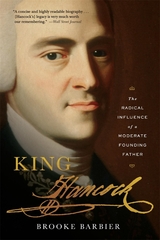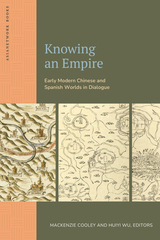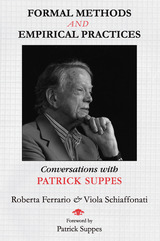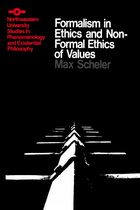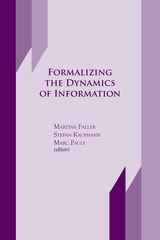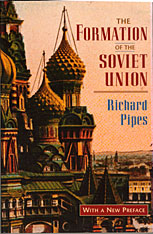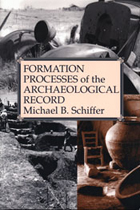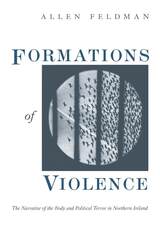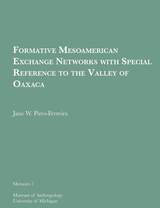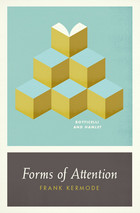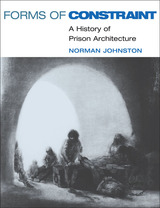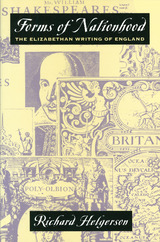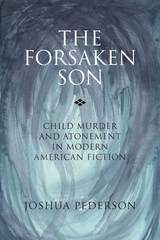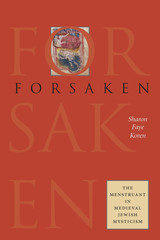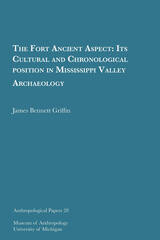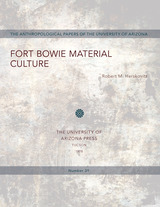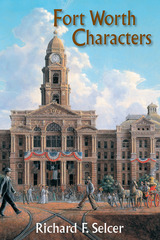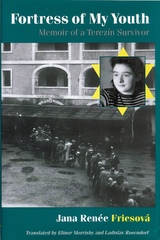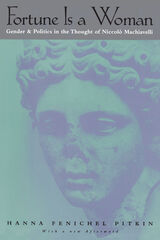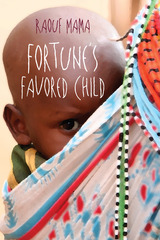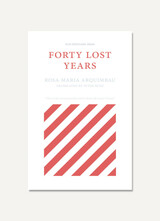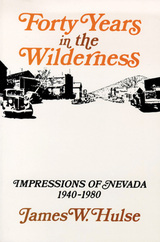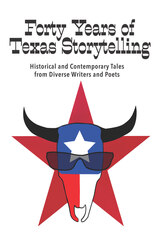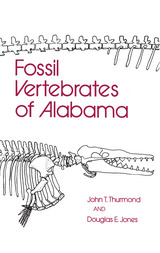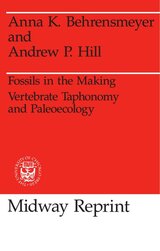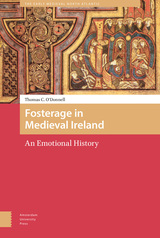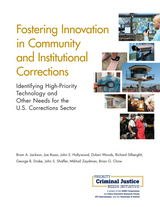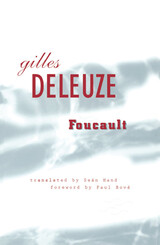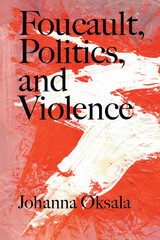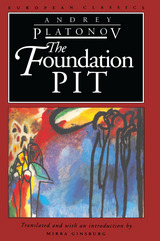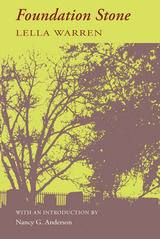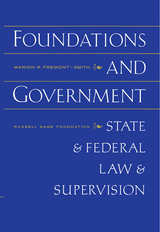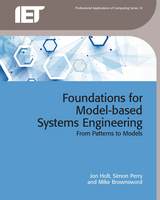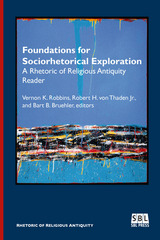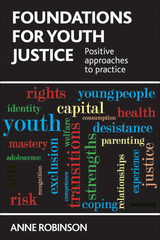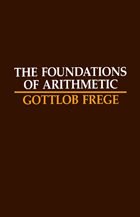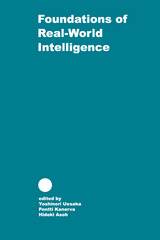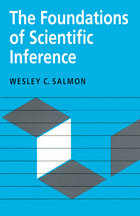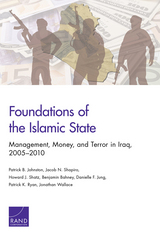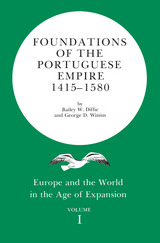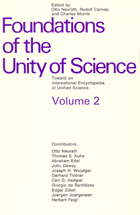Formal Methods and Empirical Practices: Conversations with Patrick Suppes
Roberta Ferrario and Viola Schiaffonati
CSLI, 2012 The philosopher Patrick Suppes has developed a unique and influential approach to studying the foundations of science—he combines an understanding of the main principles of scientific theories in axiomatic terms and formal models with a hands-on approach. While moving the study of the philosophy of science out of the parlor and into the lab, he often comes up with original results from the psychology of learning to the theory of measurement and quantum mechanics. This book searches for a common thread in Suppes’s multifaceted work through a series of conversations with the man himself and illuminates many of the more challenging aspects of his philosophy.
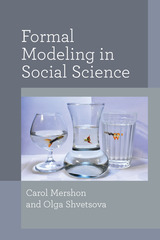 Formal Modeling in Social Science
Carol Mershon and Olga Shvetsova
University of Michigan Press, 2019 A formal model in the social sciences builds explanations when it structures the reasoning underlying a theoretical argument, opens venues for controlled experimentation, and can lead to hypotheses. Yet more importantly, models evaluate theory, build theory, and enhance conjectures. Formal Modeling in Social Science addresses the varied helpful roles of formal models and goes further to take up more fundamental considerations of epistemology and methodology.
The authors integrate the exposition of the epistemology and the methodology of modeling and argue that these two reinforce each other. They illustrate the process of designing an original model suited to the puzzle at hand, using multiple methods in diverse substantive areas of inquiry. The authors also emphasize the crucial, though underappreciated, role of a narrative in the progression from theory to model.
Transparency of assumptions and steps in a model means that any analyst will reach equivalent predictions whenever she replicates the argument. Hence, models enable theoretical replication, essential in the accumulation of knowledge. Formal Modeling in Social Science speaks to scholars in different career stages and disciplines and with varying expertise in modeling.
 Formal Spoken Arabic Basic Course with MP3 Files: Second Edition
1/
Georgetown University Press, 2005 This new edition, updated and with additional exercises, equips those who work, travel, and study in Arab countries with an educated form of spoken Arabic that functions flexibly in the face of various regional colloquial variants in the Arab world. Because the Arabic language has a number of very different spoken vernaculars, being able to speak and be understood in all Arab countries has become a challenge for English speakers. Ryding and Mehall have designed a course that teaches a standardized variant of spoken Arabic that is close to, but more natural than, the literary Modern Standard Arabic. With a non-grammar-based approach, this book fosters communicative competence in Arabic on all levels and develops speaking proficiency without abandoning Arabic script. It has proven to be clear, effective, and relevant to the needs of Americans living and working in the Arab East. Task-based lessons feature basic dialogues between Americans and Arabs, explanations of new structures, vocabulary expansion, and exercises; and provide gradual access to the sounds and script of Arabic by emphasizing listening and reading comprehension first, then slowly adding oral exercises and activities until the student has achieved basic proficiency. Not intended for self-instruction for beginners, Formal Spoken Arabic Basic Course with MP3 Files assumes some previous knowledge of Modern Standard Arabic, Arabic script and phonology, and previous or simultaneous instruction in orthography. This new edition includes a CD of MP3 audio exercises that are keyed to the text and drill students on listening and speaking. Lessons cover topics including: Heads of State
Cities and Countries
Official Titles
Geography
Systems of Government
Lost Luggage
Getting Acquainted
Establishing Common Ground
Seeking and Giving Information
Personal Needs and Family
Handling Problems
Eating Out
Bargaining and Buying
 Formal Spoken Arabic FAST Course with MP3 Files
Karin C. Ryding and Abdelnour Zaiback. Foreword by David Mehall
Georgetown University Press, 2004 This Arabic language-learning classic is now enhanced with a bound-in CD of MP3 files. Designed to provide beginners in Arabic with maximum linguistic and cultural exposure in a short period (about 100 hours of contact time), this book consists of sixteen lessons with dialogs and exercises dealing with day-to-day scenarios: greeting people, getting a taxi, making phone calls, asking directions, discussing the weather, and effectively communicating with police and duty officers. The lessons help the reader to navigate situations at gas stations, marketplaces, restaurants, and in their own households. Formal Spoken Arabic (FSA) is a kind of lingua franca that is more natural than speaking Modern Standard Arabic (MSA), the literary form of the language. FSA uses the shared features of the various urban colloquial dialects, defaulting to Levantive (terms common to Lebanon, Syria, and Jordan) where the spoken dialects diverge. Each lesson includes cultural notes on American-Arab interactions, notes on learner strategies for managing Arabic conversations with a limited amount of language, and grammar explanations in clear, non-technical language. Although the main dialogue for each lesson is presented in Arabic script, transcriptions are used to accelerate spoken performance. The FAST Course includes grammatical explanations, English-Arabic and Arabic-English glossaries, appendices listing common idioms, courtesy expressions and other useful terms, instructor's notes, and drills aided and accompanied by the CD. Originally created for diplomats, this is an expanded and enhanced edition of a work originally developed by the U.S. State Department as a six-week intensive, or "FAST" (Familiarization and Short-Term) course, and is easily adaptable for students in Middle East area studies. Travelers heading for posts in the Arab world who quickly need to gain a basic ability to converse in day-to-day situations will find Formal Spoken Arabic FAST Course an invaluable companion.
Formalizing the Dynamics of Information
Edited by Martina Faller, Stefan Kaufmann, and Marc Pauly
CSLI, 2000 The papers collected in this volume exemplify some of the trends in current approaches to logic, language and computation. Written by authors with varied academic backgrounds, the contributions are intended for an interdisciplinary audience. The first part of this volume addresses issues relevant for multi-agent systems: reasoning with incomplete information, reasoning about knowledge and beliefs, and reasoning about games. Proofs as formal objects form the subject of Part II. Topics covered include: contributions on logical frameworks, linear logic, and different approaches to formalized reasoning. Part III focuses on representations and formal methods in linguistic theory, addressing the areas of comparative and temporal expressions, modal subordination, and compositionality.
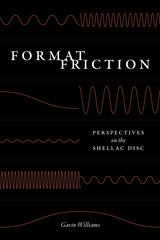 Format Friction: Perspectives on the Shellac Disc
Gavin Williams
University of Chicago Press, 2024 The first book to consider the shellac disc as a global format.
With the rise of the gramophone around 1900, the shellac disc traveled the world and eventually became the dominant sound format in the first half of the twentieth century. Format Friction brings together a set of local encounters with the shellac disc, beginning with its preconditions in South Asian knowledge and labor, to offer a global portrait of this format.
Spun at seventy-eight revolutions per minute, the shellac disc rapidly became an industrial standard even while the gramophone itself remained a novelty. The very basis of this early sound reproduction technology was friction, an elemental materiality of sound shaped through cultural practice. Using friction as a lens, Gavin Williams illuminates the environments plundered, the materials seized, and the ears entangled in the making of a sound format. Bringing together material, political, and music history, Format Friction decenters the story of a beloved medium, and so explores new ways of understanding listening in technological culture more broadly.
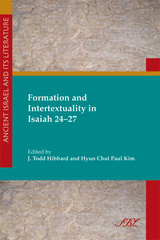 Formation and Intertextuality in Isaiah 24-27
J. Todd Hibbard
SBL Press, 2013 Isaiah 24–27, the so-called Isaiah Apocalypse, is often regarded as one of the latest sections added to the book of Isaiah. The formation and interpretation of these chapters are widely recognized as important matters for understanding the compositional history of Isaiah, emerging religious thought in the Persian period, and scribal techniques for late biblical materials. The essays in this volume explore these and other important issues of Isaiah 24–27 in light of the abundant recent research on these chapters. In addition, this volume outlines new directions forward for research on these pivotal chapters and their place in Isaiah and the prophetic literature generally. The contributors are Micaël Bürki, Paul Kang-Kul Cho, Stephen L. Cook, Wilson de A. Cunha, Carol J. Dempsey, Janling Fu, Christopher B. Hays, J. Todd Hibbard, Hyun Chul Paul Kim, Beth Steiner, John T. Willis, Archibald L. H. M. van Wieringen, and Annemarieke van der Woude.
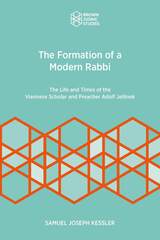 The Formation of a Modern Rabbi: The Life and Times of the Viennese Scholar and Preacher Adolf Jellinek
Samuel Joseph Kessler
SBL Press, 2022 An intellectual biography that critically engages Adolf Jellinek’s scholarship and communal activities
Adolf Jellinek (1821–1893), the Czech-born, German-educated, liberal chief rabbi of Vienna, was the most famous Jewish preacher in Central Europe in the second half of the nineteenth century. As an innovative rhetorician, Jellinek helped mold and define the modern synagogue sermon into an instrument for expressing Jewish religious and ethical values for a new era. As a historian, he made groundbreaking contributions to the study of the Zohar and medieval Jewish mysticism. Jellinek was emblematic of rabbi-as-scholar-preacher during the earliest, formative years of communal synagogues as urban religious space. In a world that was rapidly losing the felt and remembered past of premodern Jewish society, the rabbi, with Jellinek as prime exemplar, took hold of the Sabbath sermon as an instrument to define and mold Judaism and Jewish values for a new world.
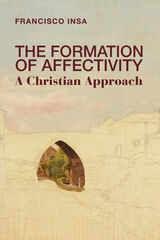 The Formation of Affectivity: A Christian Approach
Francisco Insa
St. Augustine's Press, 2023 The need and desire for the integral development of the person in his or her somatic, psychological and spiritual dimensions is growing faster than it can be answered. Ancient and classical wisdom gives us much to ponder and apply, but there is still much more to be given human life in the joy and integrity offered by Christianity. When one speaks of the meaningfulness and fruitfulness of life, there is an apostolic quality that makes of the beauty of a single individual a cause of fruitfulness in others as well. Yet many who are entrusted with the formation and care of souls have little at their disposal to foster or explain this.
The present book aims to respond to this need by addressing the consonance and individuality in human nature, and the ways in which ordering in personality and psychology are
not inhibiting, but potentially liberating and influential. Francisco Insa draws from his medical and theological background, which includes both clinical and pastoral experience, to address all those responsible for the formation of others––including parents, teachers, priests, spiritual directors––and enables them to confront their roles as formators with greater insight and confidence. Insa's guidance through the human personality and its various expressions, the education of the character, growth in maturity, the particularity of each stage of the life cycle, sexuality and celibacy, chastity in the context of post-modern life, and mental illnesses is a landmark presentation of scientific rigor matched with practical application. As often as one says, "My situation is unique,"; the author here responds: "Yes, but special even more than you can express"; Insa is forthright about what can never be lost in human beings, but only recovered when the head and heart are aligned and formed properly.
For as much as this book may help the reader understand himself, it will also render him better understood by others. The Christian approach to the formation of affectivity, as Insa shows, is indispensable to deep and enduring human development, and it is often the only way to identify and mediate interior dissonance and confusion.
 The Formation of Christendom
Christopher Dawson
Catholic University of America Press, 2026 Together with its sequel The Dividing of Christendom, this book was the fruit of the Harvard lectures that Christopher Dawson delivered as the first occupant of the Charles Chauncey Stillman Chair of Roman Catholic Studies from 1958-1962. Here, as in all his works, he sees religion as the dynamic element of culture.
This work traces the formation of Christian culture from its roots in the Judeo-Christian tradition through the rise and fall of medieval Christendom, and ends with an epilogue in which the author reflects on the defining characteristics of Christianity in general and the Catholic Church in particular.
In the introductory section of this work, Dawson highlights the importance of language in the origin and development of civilization. Christina Scott, the author’s daughter and first biographer, summarises Dawson’s ideas on this point in her work A Historian and his World: “In the beginning was the word: language was the gateway to the human world and was the single factor that distinguished man from the animal kingdom.” Language, as Dawson wrote, “enables man to think, to create a new world of imagination and reason.”
In parts two and three Dawson traces the beginnings of Christian culture in the first centuries after Christ through to the decline of medieval unity. Some of the tantalizing chapter headings include The Christian and Jewish Idea of Revelation, The Foundation of Europe: The Monks of the West, The Carolingian Age, Feudal Europe and the Age of Anarchy, The Achievement of Medieval Thought, and East and West in the Middle Ages.
Dawson shared with Arnold Toynbee the ideal of a universal spiritual society as the goal of history; but whereas Dr. Toynbee saw this as achievable by a consensus of the great world religions, Dawson concludes his work with a clear exposition of the Catholic ideal of a universal spiritual society. It provides an excellent summary of the author’s view of the uniqueness and universality of the Catholic Church, as well as its fundamentally non-sectarian basis.
His concluding words demonstrate his commitment to the concept of unity: “On the other hand, if Christianity were to lead the nations still further apart from one another into spiritual disunity, it would defeat the central purpose of the Church’s institution.”
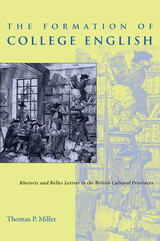 The Formation of College English: Rhetoric and Belles Lettres in the British Cultural Provinces
Thomas P. Miller
University of Pittsburgh Press, 1997 In the middle of the eighteenth century, English literature, composition, and rhetoric were introduced almost simultaneously into colleges throughout the British cultural provinces. Professorships of rhetoric and belles lettres were established just as print was reaching a growing reading public and efforts were being made to standardize educated taste and usage. The provinces saw English studies as a means to upward social mobility through cultural assimilation. In the educational centers of England, however, the introduction of English represented a literacy crisis brought on by provincial institutions that had failed to maintain classical texts and learned languages.
Today, as rhetoric and composition have become reestablished in the humanities in American colleges, English studies are being broadly transformed by cultural studies, community literacies, and political controversies. Once again, English departments that are primarily departments of literature see these basic writing courses as a sign of a literacy crisis that is undermining the classics of literature. The Formation of College English reexamines the civic concerns of rhetoric and the politics that have shaped and continue to shape college English.
 The Formation of the Parisian Bourgeoisie, 1690-1830
David Garrioch
Harvard University Press, 1996 Despite their importance during the French Revolution, the Paris middle classes are little known. This book focuses on the family organization and the political role of the Paris commercial middle classes, using as a case study the Faubourg St. Marcel and particularly the parish of St. Médard.
David Garrioch argues that in the late seventeenth and early eighteenth centuries the commercial middle classes were steadfastly local in their family ties and outlook. He shows, too, that they took independent political action in defense of their local position. This gradually changed during the eighteenth century, and the Revolution greatly accelerated the process of integration, at the same time broadening the composition of what may now be termed the Parisian bourgeoisie.
Central to Garrioch's argument is the idea that family, politics, and power are intimately connected. He shows the centrality of kinship to local politics in the first half of the eighteenth century, and the way new family structures were related to changes in the nature of politics even before the Revolution. Among the many important issues considered are birth control, the role of women, the importance of lineage, the spatial limits of middle-class lives, and the language and secularization of politics.
The Formation of the Soviet Union: Communism and Nationalism, 1917–1923, Revised Edition
Richard Pipes
Harvard University Press, 1997 Here is the history of the disintegration of the Russian Empire, and the emergence, on its ruins, of a multinational Communist state. In this revealing account, Richard Pipes tells how the Communists exploited the new nationalism of the peoples of the Ukraine, Belorussia, the Caucasus, Central Asia, and the Volga-Ural area--first to seize power and then to expand into the borderlands.
The Formation of the Soviet Union acquires special relevance in the post-Soviet era, when the ethnic groups described in the book once again reclaimed their independence, this time apparently for good.
In a 1996 Preface to the Revised Edition, Pipes suggests how material recently released from the Russian archives might supplement his account.
The Formation of Thomas Fuller’s “Holy and Profane States”
Walter E. Houghton, Jr.
Harvard University Press Coleridge and Lamb were responsible for putting Fuller into a critical straight-jacket by their exaggerated praise of his wit and wisdom. The nineteenth century reprinted his work in selections, often no longer than single sentences, and failed to appreciate his true contributions to biography and historiography. Walter Houghton has taken The Holy and Profane States as a test case and has shown that we can judge Fuller much more fairly as soon as we look at entire books, at their contents and their forms. His study, which is the only book of criticism about Fuller that has ever been published, looks into Fuller’s mind just before he began to write and during the time of writing and sees how it was working. The result is a unique contribution to English literary and intellectual history.
Formation Processes of the Archaeological Record
Michael Brian Schiffer
University of Utah Press, 1987 This handbook synthesizes the most important principles of cultural and environmental formation processes for both students and practicing archaeologists.
Formation Process of the Archaeological Record embodies a vision that the cultural past is knowable, but only when the nature of the evidence is thoroughly understood. It shows how the past is accessible in practice by identifying variability introduced by the diverse effects of people and nature that in some sum, form the archaeological record.
For students, it is intended as both an introduction and guide in method and theory, field work, and analysis. Practicing archaeologists will find it a valuable checklist of sources of variability when observations on the archaeological record are used to justify inferences.
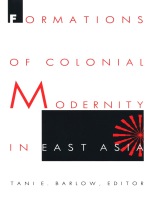 Formations of Colonial Modernity in East Asia
Tani E. Barlow, ed.
Duke University Press, 1997 The essays in Formations of Colonial Modernity in East Asia challenge the idea that notions of modernity and colonialism are mere imports from the West, and show how colonial modernity has evolved from and into unique forms throughout Asia. Although the modernity of non-European colonies is as indisputable as the colonial core of European modernity, until recently East Asian scholarship has tried to view Asian colonialism through the paradigm of colonial India (for instance), failing to recognize anti-imperialist nationalist impulses within differing Asian countries and regions. Demonstrating an impatience with social science models of knowledge, the contributors show that binary categories focused on during the Cold War are no longer central to the project of history writing. By bringing together articles previously published in the journal positions: east asia cultures critique, editor Tani Barlow has demonstrated how scholars construct identity and history, providing cultural critics with new ways to think about these concepts—in the context of Asia and beyond. Chapters address topics such as the making of imperial subjects in Okinawa, politics and the body social in colonial Hong Kong, and the discourse of decolonization and popular memory in South Korea. This is an invaluable collection for students and scholars of Asian studies, postcolonial studies, and anthropology. Contributors. Charles K. Armstrong, Tani E. Barlow, Fred Y. L. Chiu, Chungmoo Choi, Alan S. Christy, Craig Clunas, James A. Fujii, James L. Hevia, Charles Shiro Inouye, Lydia H. Liu, Miriam Silverberg, Tomiyama Ichiro, Wang Hui
 Formations of Ritual: Colonial and Anthropological Discourses on the Sinhala Yaktovil
David Scott
University of Minnesota Press, 1994 Formations of Ritual was first published in 1994. Minnesota Archive Editions uses digital technology to make long-unavailable books once again accessible, and are published unaltered from the original University of Minnesota Press editions. Yaktovil is an elaborate healing ceremony employed by Sinhalas in Sri Lanka to dispel the effects of the eyesight of a pantheon of malevolent supernatural figures known as yakku. Anthropology, traditionally, has articulated this ceremony with the concept metaphor of "demonism." Yet, as David Scott demonstrates in this provocative book, this use of "demonism" reveals more about the discourse of anthropology than it does about the ritual itself. His investigation of yaktovil and yakku within the Sinhala cosmology is also an inquiry into the ways in which anthropology, by ignoring the discursive history of the rituals, religions, and relationships it seeks to describe, tends to reproduce ideological-often, specifically colonial-objects. To do this, Scott describes the discursive apparatus through which yakku are positioned in the moral universe of Sinhala, traces the appearance of yakku and yaktovil in Western discourse, evaluates the contribution of these figures and this ceremony in anthropology, and attempts to show how the larger anthropology of Buddhism, in which the anthropology of yaktovil is embedded, might be reconfigured. Finally, he offers a rereading of the ritual in terms of the historically selfconscious approach he proposes.The result points to a major rethinking of the historical nature not only of the objects, but also of the concepts through which they are constructed in anthropological discourse. David Scott teaches in the Department of Anthropology at the University of Chicago.
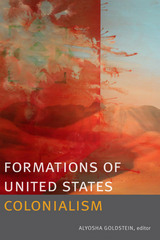 Formations of United States Colonialism
Alyosha Goldstein
Duke University Press, 2014 Bridging the multiple histories and present-day iterations of U.S. settler colonialism in North America and its overseas imperialism in the Caribbean and the Pacific, the essays in this groundbreaking volume underscore the United States as a fluctuating constellation of geopolitical entities marked by overlapping and variable practices of colonization. By rethinking the intertwined experiences of Native Americans, Puerto Ricans, Chamorros, Filipinos, Hawaiians, Samoans, and others subjected to U.S. imperial rule, the contributors consider how the diversity of settler claims, territorial annexations, overseas occupations, and circuits of slavery and labor—along with their attendant forms of jurisprudence, racialization, and militarism—both facilitate and delimit the conditions of colonial dispossession. Drawing on the insights of critical indigenous and ethnic studies, postcolonial theory, critical geography, ethnography, and social history, this volume emphasizes the significance of U.S. colonialisms as a vital analytic framework for understanding how and why the United States is what it is today.
Contributors. Julian Aguon, Joanne Barker, Berenika Byszewski, Jennifer Nez Denetdale, Augusto Espiritu, Alyosha Goldstein, J. K?haulani Kauanui, Barbara Krauthamer, Lorena Oropeza, Vicente L. Rafael, Dean Itsuji Saranillio, Lanny Thompson, Lisa Uperesa, Manu Vimalassery
Formations of Violence: The Narrative of the Body and Political Terror in Northern Ireland
Allen Feldman
University of Chicago Press, 1991 "A sophisticated and persuasive late-modernist political analysis that consistently draws the reader into the narratives of the author and those of the people of violence in Northern Ireland to whom he talked. . . . Simply put, this book is a feast for the intellect"—Thomas M. Wilson, American Anthropologist
"One of the best books to have been written on Northern Ireland. . . . A highly imagination and significant book. Formations of Violence is an important addition to the literature on political violence."—David E. Schmitt, American Political Science Review
Formative Mesoamerican Exchange Networks with Special Reference to the Valley of Oaxaca
Jane W. Pires-Ferreira
University of Michigan Press, 2019 For this volume, archaeologist Jane W. Pires-Ferreira analyzed artifacts from the Valley of Oaxaca in order to understand more about prehistoric trade patterns in the region. Using her analyses, she was able to describe obsidian exchange networks, iron ore mirror exchange networks, and shell exchange networks in Early and Middle Formative Mesoamerica.
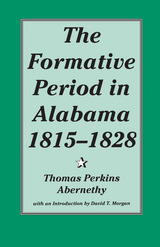 The Formative Period in Alabama, 1815-1828
Thomas Abernethy, with an introduction by David T. Morgan
University of Alabama Press, 1995 The Formative Period in Alabama, 1815-1828 is a beautifully crafted history of the evolution of the state written by Thomas Perkins Abernethy in 1922. The work shows how Alabama grew out of the Mississippi Territory and discusses the economic and political development during the years just before and just after Alabama became a state. Abernethy’s story begins when Alabama existed as the eastern part of the Mississippi Territory, settled primarily by Cherokees, Choctaws, and Creeks, a few traders, and some brave but foolhardy “squatters” who thought to supplant the Indians and carve out a home for themselves and their descendants from Indian territory. Friction with the Creeks escalated into war and, with their defeat at the Battle of Horseshoe Bend, the successful move began to wrest land from the Indians for white settlement. The availability of good land, the promise of transportation of goods along the waterways, and the opening of the Federal Road brought rapid population growth to an area blessed (and cursed) with forceful leaders. Abernethy describes in detail the political maneuverings and economic strangleholds that created territorial division and turmoil in the early days of Alabama’s statehood.
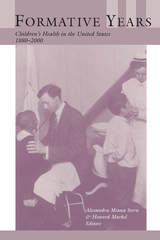 Formative Years: Children's Health in the United States, 1880-2000
Alexandra Minna Stern and Howard Markel, Editors
University of Michigan Press, 2004 Much has changed in the lives of children, and in the health care provided to them, over the past century. Formative Years explores how children's lives have become increasingly medicalized, traces the emergence of the fields of pediatrics and child health, and offers fascinating case studies of important and timely issues. With contributions from historians and physicians, this collection illuminates some of the most important transformations in children's health in the United States since the 1880s. Opening with a history of pediatrics as a medical specialty, the book addresses such topics as the formulation of normal growth curves, Better Babies contests at county fairs, the "discovery" of the sexual abuse of children, and the political radicalism of the founder of pediatrics, Dr. Abraham Jacobi. One of the first long-term historical and analytical overviews of pediatrics and child health in the twentieth century, Formative Years will be a welcome addition to several fields, including the history of medicine and technology, the history of childhood, modern U.S. history, women's history, and American studies. It also has ramifications for policymakers concerned with child welfare and development and poses important questions about the direction of children's health in the twenty-first century. Alexandra Minna Stern is Associate Director of the Center for the History of Medicine and Assistant Professor of Obstetrics and Gynecology and American Culture at the University of Michigan. Howard Markel is the George Edward Wantz Professor of the History of Medicine, Professor of Pediatrics and Communicable Diseases, and Professor of History at the University of Michigan, and Director of the Center for the History of Medicine.
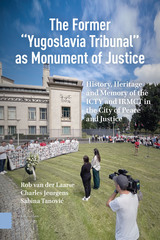 The Former “Yugoslavia Tribunal” as Monument of Justice: History, Heritage and Memory of the ICTY and IRMCT in the City of Peace and Justice
Rob van der Laarse
Amsterdam University Press, 2025 After Nuremberg, there is probably no other place where the future of Europe has been so definitively tested and safeguarded as in The Hague. The iconic building of the former International Criminal Tribunal for the former Yugoslavia (ICTY) has become a global symbol of international law and transitional justice since its establishment in 1993. As the direct successor to the International Military Tribunal of Nuremberg in 1945-1946, this UN tribunal concluded 25 years of unprecedented success in investigating and trying all major war crimes suspects from the wars in the former Yugoslavia during the 1990s. It also made history through the first application of the UN Genocide Convention in the trial of the 1995 Srebrenica massacre. This report addresses the question of how the significance of the International Criminal Tribunal for the former Yugoslavia, as a heritage and memorial site for its many (inter)national stakeholders, can be preserved following the withdrawal of the UN and a possible redevelopment of the site.
 Formerly British Honduras: A Profile Of The New Nation Of Belize
William David Setzerkorn
Ohio University Press, 1981 William Setzekorn weaves the folklore, facts, history, culture, economics and geography of Belize into an exciting mini-encyclopedia. His portrait of this proud new nation is painted with humor, gentleness, fact and empathy presenting a credible picture of modern day Belize. Reading with the ease and excitement of a novel it is more than a history book, a travelog or an encyclopedia giving the reader a feeling of kinship with the struggles and joy of this tiny new nation.
A mixture of Africans, Mestizos, East Indians, Europeans, Syrians, Lebanese, Mayans, and Chinese; Belize has grown into a heterogenous mosaic of a strong and brave country which is no bigger than Cambridge, Massachusetts. Studying the influences of British domination and Spanish intimidation up to the recent movements for self-government and independence, Setzekorn presents to the reader an accounting of Belizean social and political vicissitudes—a long and tortuous, yet coherent, struggle for national and cultural identity.
 Formerly God: Rethinking God after God
Rick Benjamins
Amsterdam University Press, 2026 God is and remains a meaningful term, even after “the death of God,” but its meaning is by no means clear or unambiguous. Clearly and with a broad perspective, this book challenges classical theology with the criticism that “onto-theology” is no longer possible today and shows in what drastically changed way it might “survive.” It shows how the academic theological conversation about God after God has developed over time and in different places.
This book begins with the controversial work of Dutch theologian Harry Kuitert, who bid farewell to old representations of God but got stuck finding new ones. It turns back to the important and indispensable insights of Hegel and Heidegger. It presents contemporary post-theistic thinking about God, using German, French, and American thinkers, distinguishing interpretive theologians, deconstructionists, and constructive theologians, finally formulating a new position.
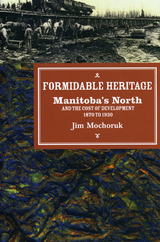 Formidable Heritage: Manitoba's North and the Cost of Development
Jim Mochoruk
University of Manitoba Press, 2004 Canadians have an ambivalent feeling towards the North. Although climate and geography make our northern condition apparent, Canadians often forget about the north and its problems. Nevertheless, for the generation of historians that included Lower, Creighton, and Morton, the northern rivers, lakes, forests, and plains were often seen as primary characters in the drama of nation building. W.L. Morton even went so far as to write that the ìmain task of Canadian life has been to make something of that formidable heritageî of the northern Canadian shield. For many politicians and developers, "to make something" of the North came to mean thinking of the North as an empty hinterland waiting to be exploited, and today, hydroelectric projects, mining, milling, pulp and paper, and other industries have changed much of the North beyond recognition.One of the first parts of the North to be aggressively industrialized was northern Manitoba. When all of Manitoba was given in 1670 to a group of entrepreneurs, a precedent was set that was replicated throughout the provinceís history. After the province entered confederation in 1870, provincial politicians and business leaders began to look to the northern resources as a new key to the provinceís economic development. Particularly after 1912, they saw resource development in the North as a strategy to expand the provincial economy from its agricultural base. Jim Mochoruk shows how government and business worked together to transform what had been the exclusive fur-trading preserve of the Hudsonís Bay Company into an industrial hinterland. He follows the many twisting paths established by developers and politicians as they chased their goal of economic growth, and recounts the ultimate costs of development in economic, ecological, and political terms.
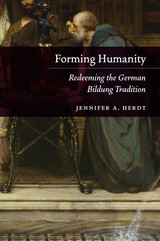 Forming Humanity: Redeeming the German Bildung Tradition
Jennifer A. Herdt
University of Chicago Press, 2019 Now in paperback, Forming Humanity reveals bildung, or ethical formation, as the key to post-Kantian thought.
Kant’s proclamation of humankind’s emergence from “self-incurred immaturity” left his contemporaries with a puzzle: What models should we use to sculpt ourselves if we no longer look to divine grace or received authorities? Deftly uncovering the roots of this question in Rhineland mysticism, Pietist introspection, and the rise of the bildungsroman, Jennifer A. Herdt reveals bildung, or ethical formation, as the key to post-Kantian thought. This was no simple process of secularization, in which human beings took responsibility for something they had earlier left in the hands of God. Rather, theorists of bildung, from Herder through Goethe to Hegel, championed human agency in self-determination while working out the social and political implications of our creation in the image of God. While bildung was invoked to justify racism and colonialism by stigmatizing those deemed resistant to self-cultivation, it also nourished ideals of dialogical encounter and mutual recognition. Herdt reveals how the project of forming humanity lives on in our ongoing efforts to grapple with this complicated legacy.
 Forming the Critical Mind: Dryden to Coleridge
James Engell
Harvard University Press, 1989 James Engell has prepared the first broad treatment of eighteenth- and early-nineteenth century British criticism to appear in a generation, presenting the views of scores of writers on a variety of questions, many of which remain live issues today.
While offering major reevaluations of Dryden, Hume, and Johnson, Engell demonstrates that eighteenth-century criticism cannot be represented by just a few major critics or by generalizations about Augustan taste, neoclassical rules, or “common sense.” He presents a complex and highly varied body of theoretical writing and practical application by dozens of critics including Rymer, Addison, Welsted, Ramsay, Hurd, Gerard, Newbery, Campbell, Blair, Beattie, Jeffrey, and Hazlitt. He also analyzes the continued relevance of their critical work, drawing connections with modern writers such as Eliot, Frye, Saussure, Barthes, Culler, Bakhtin, and Lévi-Strauss.
Engell concludes with a stimulating essay on the nature and function of the critical process itself. For students and scholars conversant with modern critical theory, Forming the Critical Mind will offer some surprising and interesting comparisons.
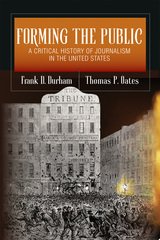 Forming the Public: A Critical History of Journalism in the United States
Frank D. Durham and Thomas P. Oates
University of Illinois Press, 2024 Throughout United States history, journalists and media workers have mobilized to promote and oppose various movements in public life. But a single meaning of the public remains elusive. Frank D. Durham and Thomas P. Oates provide an eye-opening analysis of the role played by journalism in the ongoing struggle to shape and transform ideas about the public. Using historical episodes and news reports, Durham and Oates offer examples of the influential words and images deployed by not only journalists but by media workers and activists. Their analysis moves from the patriot-inflamed emotions of the revolutionary period to the conventional and creative ways the American Indian Movement confronted the mainstream with their grievances. Weaving eyewitness history through US history, Forming the Public reveals what understanding the journalism landscape can teach us about the nature of journalism’s own interests in race, gender, and class while tracing the factors that shaped the contours of dominant American culture.
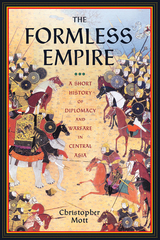 The Formless Empire: A Short History of Diplomacy and Warfare in Central Asia
Christopher Mott
Westholme Publishing, 2015 The Role of Nomadic Culture in the Evolution of Non-Western Power Politics
Central Asia, a vast region extending from eastern Russia and across Kazakhstan, Uzbekistan, Turkmenistan, Afghanistan, Tajikistan, Kyrgystan, Mongolia, and western China, has its own tradition of foreign policy rooted in the ancient nomadic culture of many of its peoples as well as the region’s distinctive geography. From the thundering hooves of Mongol or Cossack cavalry across the steppes to the clanking of tanks on parade in Moscow or Beijing, elements of this system still cast a shadow on the region at the heart of Earth’s largest continent. By tracing the evolution of Central Asian warfare and diplomacy through a series of historical examples, ranging from the ancient Xiongnu people and medieval Mongol Empire to the fall of the Soviet Union, historian Christopher Mott argues that the original system of informal relationships, indirect rule, and rapid military movement did not entirely fade from the region with the eclipse of the nomadic powers during the Middle Ages. In fact, many states like China, Iran, and Russia had already been influenced by nomadic people, and in so doing adapted their own diplomatic and military policies accordingly. The Formless Empire: A Short History of Diplomacy and Warfare in Central Asia is an engaging study of the nature of non-Western imperialism and great-power strategy. In addition, the book demonstrates that regional histories can show us the variety of political possibilities in the past and how they were adapted to changing circumstances—a point made even more important by the rapid changes facing global security and new forms of empire building.
“Christopher Mott’s extremely erudite and wide-ranging examination of the history of Central Asia shows us that we have been far too narrow-minded and Eurocentric in thinking about power and how the global system changes historically. Given the current interest in ‘caliphates’ we need to reflect on the history of the areas of the world that dance to a different historical drum than we do in the West.” —Andrew John Williams, author of France, Britain, and the United States in the Twentieth Century
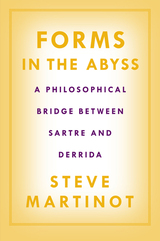 Forms in the Abyss: A Philosophical Bridge Between Sartre and Derrida
Steve Martinot
Temple University Press, 2007 The relationship between the existentialist Jean-Paul Sartre and the post-structuralist Jecques Derrida has never been fully examined until now. In Forms in the Abyss, Steve Martinot finds, between these two important philosophical thinkers of the twentieth century, "a common uncommonality" by which he sees them confront each other as "kindred souls" despite their vast differences.
Martinot argues that a bridge between these two thinkers can be constructed. He demonstrates that one can use the critical tools provided by Derrida, and the forms of discourse and reasoning developed by Sartre, to set the two in dialogue with each other. In the process, Martinot develops a theory of dialogue that incorporates both ethics and form and contributes a new way of thinking about critical and social theory. More importantly, he adds a new ethical and political imperative to postmodern thought that many dritics have often found missing in the works of thinkers like Derrida.
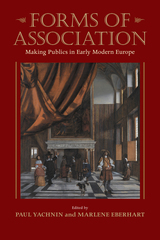 Forms of Association: Making Publics in Early Modern Europe
Paul Yachnin
University of Massachusetts Press, 2015 In today's connected and interactive world, it is hard to imagine a time when cultural and intellectual interests did not lead people to associate with others who shared similar views and preoccupations. In this volume of essays, fifteen scholars explore how these kinds of relationships began to transform early modern European culture.
Forms of Association grows out of the "Making Publics: Media, Markets, and Association in Early Modern Europe" (MaPs) project, funded by the Social Sciences and Humanities Research Council of Canada. This scholarly initiative convened an interdisciplinary research team to consider how "publics"—new forms of association built on the shared interests of individuals—developed in Europe from 1500 to 1700. Drawing on a wide array of texts and histories, including the plays of Shakespeare, the legend of Robin Hood, paintings, and music as well as English gossip about France, the contributors develop a historical account of what publics were in early modern Europe. This collaborative study provides a dynamic way of understanding the political dimensions of artistic and intellectual works and opens the way toward a new history of early modernity.
Until his death in 2008, the great Renaissance scholar Richard Helgerson was a key participant in the MaPs project. The scholars featured in this volume originally met in Montreal to engage in a critical, commemorative conversation about Helgerson's work, the issues and questions coming out of the MaPs project, and how Helgerson's thinking advanced and could in turn be advanced by MaPs. This collection represents the fruits of that conversation.
Forms of Attention: Botticelli and Hamlet
Frank Kermode
University of Chicago Press, 2011 Sir Frank Kermode, the British scholar, instructor, and author, was an inspired critic. Forms of Attention is based on a series of three lectures he gave on canon formation, or how we choose what art to value. The essay on Botticelli traces the artist’s sudden popularity in the nineteenth century for reasons that have more to do with poetry than painting. In the second essay, Kermode reads Hamlet from a very modern angle, offering a useful (and playful) perspective for a contemporary audience. The final essay is a defense of literary criticism as a process and conversation that, while often conflating knowledge with opinion, keeps us reading great art and working with—and for—literature.
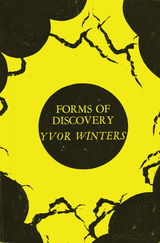 Forms of Discovery: Critical and Historical Essays on the Forms of the Short Poem in English
Yvor Winters
Ohio University Press, 1967 With Forms of Discovery, Yvor Winters completes his critical canon. The distinguished poet-critic defines by analysis and example the development of the method that he has called “post-Symbolist.” Starting with the styles of the English Renaissance, Winters discusses at length the felicities and shortcomings of these traditions, the main defect being that sensory imagery was little more than ornament. This sets the problem: to discover a style wherein both the conceptual and the perceptual are given their fullest expression In the work of Charles Churchill, Winters explores the development of a complexly controlled associational procedure. Here is a richly varied conceptual method, though the sensory is still almost totally absent. Churchill’s methods and those of the Renaissance masters are then contrasted with the work of the Romantics, who wrote a great deal about nature without bothering to look at it, and whose most lasting contribution would appear to be pathetically sentimental fallacies. The turn of the century, in France, Britain, and America, sees the beginning of the post-Symbolist methods, while Yeats continues the retrograde movement of the Romantics. It is in the work of poets like Tuckerman, Hardy, Bridges, Stevens, T. Sturge Moore, and Paul Valéry that rational discourse combines richly with the perceptual universe in which we live: the particular perception is enhanced by reference to general concepts, the general given substance by the particular exemplifying it. The post-Symbolist methods result in a poetry that unifies the diverse fields of human experience and employs all aspects of language. Style in Winters’ sense is not simply a way of gracefully combining words. It is the way a man lives, the method or art wherein he discovers to the best of his ability the real nature of the world in which he lives. It is in this sense that Forms of Discovery is a philosophical work, not a miscellaneous collection of essays; this book is, as Winters remarks, “an act of piety, not an act of destruction.”
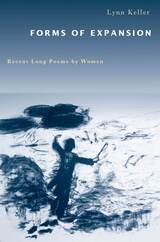 Forms of Expansion: Recent Long Poems by Women
Lynn Keller
University of Chicago Press, 1997 Expanding the boundaries of both genre and gender, contemporary American women are writing long poems in a variety of styles that repossess history, reconceive female subjectivity, and revitalize poetry itself. In the first book devoted to long poems by women, Lynn Keller explores this rich and evolving body of work, offering revealing discussions of the diverse traditions and feminist concerns addressed by poets ranging from Rita Dove and Sharon Doubiago to Judy Grahn, Marilyn Hacker, and Susan Howe.
Arguing that women poets no longer feel intimidated by the traditional associations of long poems with the heroic, public realm or with great artistic ambition, Keller shows how the long poem's openness to sociological, anthropological, and historical material makes it an ideal mode for exploring women's roles in history and culture. In addition, the varied forms of long poems—from sprawling free verse epics to regular sonnet sequences to highly disjunctive experimental collages—make this hybrid genre easily adaptable to diverse visions of feminism and of contemporary poetics.
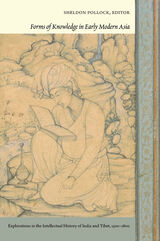 Forms of Knowledge in Early Modern Asia: Explorations in the Intellectual History of India and Tibet, 1500-1800
Sheldon Pollock, ed.
Duke University Press, 2011 In the past two decades, scholars have transformed our understanding of the interactions between India and the West since the consolidation of British power on the subcontinent around 1800. While acknowledging the merits of this scholarship, Sheldon Pollock argues that knowing how colonialism changed South Asian cultures, particularly how Western modes of thought became dominant, requires knowing what was there to be changed. Yet little is known about the history of knowledge and imagination in late precolonial South Asia, about what systematic forms of thought existed, how they worked, or who produced them. This pioneering collection of essays helps to rectify this situation by addressing the ways thinkers in India and Tibet responded to a rapidly changing world in the three centuries prior to 1800. Contributors examine new forms of communication and conceptions of power that developed across the subcontinent; changing modes of literary consciousness, practices, and institutions in north India; unprecedented engagements in comparative religion, autobiography, and ethnography in the Indo-Persian sphere; and new directions in disciplinarity, medicine, and geography in Tibet. Taken together, the essays in Forms of Knowledge in Early Modern Asia inaugurate the exploration of a particularly complex intellectual terrain, while gesturing toward distinctive forms of non-Western modernity. Contributors. Muzaffar Alam, Imre Bangha, Aditya Behl, Allison Busch, Sumit Guha, Janet Gyatso, Matthew T. Kapstein, Françoise Mallison, Sheldon Pollock, Velcheru Narayana Rao, Kurtis R. Schaeffer, Sunil Sharma, David Shulman, Sanjay Subrahmanyam, Mohamad Tavakoli-Targhi
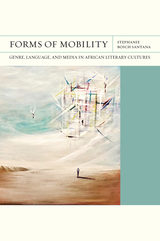 Forms of Mobility: Genre, Language, and Media in African Literary Cultures
Stephanie Bosch Santana
Northwestern University Press, 2025 Presents alternative categories of fiction through which to examine how contemporary writers have envisaged Africa’s changing literary terrains Stephanie Bosch Santana analyzes southern African writers’ experimentations with literary form in periodical print and digital media since the mid-twentieth century in order to offer an alternative account of contemporary African imaginations of mobility. Based on an understudied archive of texts in English and Chichewa/Nyanja from Malawi, South Africa, Zimbabwe, and Zambia, Forms of Mobility: Genre, Language, and Media in African Literary Cultures examines new, noncanonical categories of fiction, including migrant forms, township tales, weekend stories, and digital diaries. These generically, linguistically, and geographically mobile forms map changing ideas of interconnection and belonging. By reading them “in motion,” as they travel across space, time, genre, and language and between publications and platforms, Bosch Santana limns multiple centers of literary influence and relation across southern African and Black diasporas, revealing forms of literary mobility and space making that are occluded by current models of world literature.
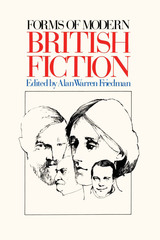 Forms of Modern British Fiction
Edited by Alan Warren Friedman
University of Texas Press, 1975 In Forms of Modern British Fiction six individualistic and strongminded critics delineate the "age of modernism" in British fiction. Dating the age and the movement from later Hardy works through the deaths of Joyce and Woolf, they present British fiction as a cohesive, self-contained unit of literary history. Hardy appears as the first of the modern British novelists, Lawrence as the central, and Joyce and Woolf as the last. The writers and the modern movement are framed by precursors, such as Galsworthy, and by successors, Durrell, Beckett, and Henry Green—the postmoderns. The pattern of the essays suggests a growing self-consciousness on the part of twentieth-century writers as they seek not only to refine their predecessors but also to deny (and sometimes obliterate) them. The moderns thus deny the novel itself, a genre once firmly rooted in history and forms of social life. Their works do not assume that comfortable mimetic relationship between the fictive realities of art and life. Consequently, there has now evolved a poetics of the novel that is virtually identifiable with modern fiction, a poetics still highly problematical in its attempt to denote a medium in whose name eclectic innovativeness and incessant revitalizing are proclaimed. Forms of Modern British Fiction refines and advances the discussion of the modern novel and the world it and we inhabit.
Forms of Nationhood: The Elizabethan Writing of England
Richard Helgerson
University of Chicago Press, 1992 What have poems and maps, law books and plays, ecclesiastical polemics and narratives of overseas exploration to do with one another? By most accounts, very little. They belong to different genres and have been appropriated by scholars in different disciplines. But, as Richard Helgerson shows in this ambitious and wide-ranging study, all were part of an extraordinary sixteenth- and seventeenth-century enterprise: the project of making England.
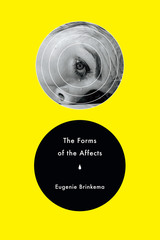 The Forms of the Affects
Eugenie Brinkema
Duke University Press, 2014 What is the relationship between a cinematic grid of color and that most visceral of negative affects, disgust? How might anxiety be a matter of an interrupted horizontal line, or grief a figure of blazing light? Offering a bold corrective to the emphasis on embodiment and experience in recent affect theory, Eugenie Brinkema develops a novel mode of criticism that locates the forms of particular affects within the specific details of cinematic and textual construction. Through close readings of works by Roland Barthes, Hollis Frampton, Sigmund Freud, Peter Greenaway, Michael Haneke, Alfred Hitchcock, Søren Kierkegaard, and David Lynch, Brinkema shows that deep attention to form, structure, and aesthetics enables a fundamental rethinking of the study of sensation. In the process, she delves into concepts as diverse as putrescence in French gastronomy, the role of the tear in philosophies of emotion, Nietzschean joy as a wild aesthetic of repetition, and the psychoanalytic theory of embarrassment. Above all, this provocative work is a call to harness the vitality of the affective turn for a renewed exploration of the possibilities of cinematic form.
 Forms of Truth and the Unity of Knowledge
Vittorio Hösle
University of Notre Dame Press, 2014 Forms of Truth and the Unity of Knowledge addresses a philosophical subject—the nature of truth and knowledge—but treats it in a way that draws on insights beyond the usual confines of modern philosophy. This ambitious collection includes contributions from established scholars in philosophy, theology, mathematics, chemistry, biology, psychology, literary criticism, history, and architecture. It represents an attempt to integrate the insights of these disciplines and to help them probe their own basic presuppositions and methods.
The essays in Forms of Truth and the Unity of Knowledge are collected into five parts, the first dealing with division of knowledge into multiple disciplines in Western intellectual history; the second with the foundational disciplines of epistemology, logic, and mathematics; the third with explanation in the natural sciences; the fourth with truth and understanding in disciplines of the humanities; and the fifth with art and theology.
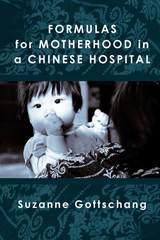 Formulas for Motherhood in a Chinese Hospital
Suzanne Gottschang
University of Michigan Press, 2018 What happens to pregnant women when the largest country in the world implements a global health policy aimed at reorganizing hospitals and re- training health care workers to promote breastfeeding? Since 1992, the Chinese government has led the world in reorganizing more than 7,000 hospitals into “Baby- Friendly” hospitals. The initiative’s goal, overseen by UNICEF and the World Health Organization, is to promote the practice of breastfeeding by reorganizing hospital routines, spaces, and knowledge in maternity wards and obstetrics clinics. At the same time, China’s hospitals in the mid- 1990s operated as sites where the effects of economic reform and capitalism increasingly blurred the boundaries between state imperatives to produce healthy future citizens and the flexibility accorded individuals through their participation in an emerging consumer culture.
Formulas for Motherhood follows a group of women over eighteen months as they visited a Beijing Baby- Friendly Hospital over the course of their pregnancies and throughout their postpartum recoveries. The book shows how the space of the hospital operates as a microcosm of the larger social, political, and economic forces that urban Chinese women navigate in the process of becoming a mother. Relations between biomedical practices, heightened expectations of femininity and sexuality demanded by a consumer culture, alongside international and national agendas to promote maternal and child health, reveal new agents of maternal governance emerging at the very moment China’s economy heats up. This ethnography provides insight into how women’s creative pragmatism in a rapidly changing society leads to their views and decisions about motherhood.
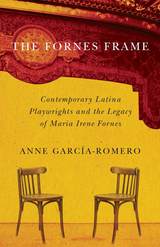 The Fornes Frame: Contemporary Latina Playwrights and the Legacy of Maria Irene Fornes
Anne García-Romero
University of Arizona Press, 2016 A key way to view Latina plays today is through the foundational frame of playwright and teacher Maria Irene Fornes, who has trained a generation of theatre artists and transformed the field of American theatre. Fornes, author of Fefu and Her Friends and Sarita and a nine-time Obie Award winner, is known for her plays that traverse cultural, spiritual, and aesthetic borders.
In The Fornes Frame: Contemporary Latina Playwrights and the Legacy of Maria Irene Fornes, Anne García-Romero considers the work of five award-winning Latina playwrights in the early twenty-first century, offering her unique perspective as a theatre studies scholar who is also a professional playwright.
The playwrights in this book include Pulitzer Prize–winner Quiara Alegría Hudes; Obie Award–winner Caridad Svich; Karen Zacarías, resident playwright at Arena Stage in Washington, DC; Elaine Romero, member of the Goodman Theatre Playwrights Unit in Chicago, Illinois; and Cusi Cram, company member of the LAByrinth Theater Company in New York City.
Using four key concepts—cultural multiplicity, supernatural intervention, Latina identity, and theatrical experimentation—García-Romero shows how these playwrights expand past a consideration of a single culture toward broader, simultaneous connections to diverse cultures. The playwrights also experiment with the theatrical form as they redefine what a Latina play can be. Following Fornes’s legacy, these playwrights continue to contest and complicate Latina theatre.
 Fornes: Theater in the Present Tense
Diane Lynn Moroff
University of Michigan Press, 1996 The work of Maria Irene Fornes, author of such acclaimed plays as Fefu and Her Friends, Mud, and The Conduct of Life, has for over three decades earned the attention of theater-goers, scholars and critics. She has won eight Obie awards, has provoked considerable controversy, and has consistently challenged and delighted the reader and spectator with her idiosyncratic voice and her serious and yet profoundly playful approach to the theater and to the issues of humanity, gender politics, and art.
Diane Lynn Moroff focuses on Fornes's major plays, providing illuminating readings of her unique and irreverent body of work. The book traces the career of this influential playwright, director, and teacher, including the reception of her plays, the range of critical responses (particularly those of feminist critics), and an introduction to Fornes's theatrical philosophies. It looks at such critical issues in Fornes's work as the representation of female subjectivity, theater as metaphor and context, art as ritual, and the role of the spectator. In a final chapter, Fornes's plays including Abingdon Square and her most recent work, What of the Night? are examined in the context of the sexualization of character, an ongoing theme for Fornes.
Fornes: Theater in the Present Tense will appeal to scholars and students in theater studies and women's studies and to anyone interested or engaged in contemporary theater.
Diane Lynn Moroff is Assistant Professor of English, Oglethorpe University.
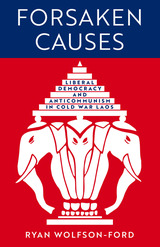 Forsaken Causes: Liberal Democracy and Anticommunism in Cold War Laos
Ryan Wolfson-Ford
University of Wisconsin Press, 2024 In the wake of anticolonial struggles and amid the two world wars, twentieth-century Southeast Asia churned with new political, cultural, and intellectual realities. Liberal democracies flourished briefly, only to be discarded for dictatorships and other authoritarian regimes as the disorder and inefficiencies inherent to democracy appeared unequal to postcolonial and Cold War challenges. Uniquely within the region, Laos maintained a stable democracy until 1975, surviving wars, coups, and revolutions. But Lao history during this period has often been flattened, subsumed within the tug-of-war between the global superpowers and their puppets.
Forsaken Causes offers a groundbreaking intellectual history of the Royal Lao Government (RLG) from 1945 to 1975. In Ryan Wolfson-Ford’s account, the Lao people emerge as not merely pawns of the superpowers but agents in their own right, with the Lao elite wielding particular influence over the nation’s trajectory. Their prevailing ideologies—liberal democracy and anticommunism—were not imposed from outside, but rather established by Lao themselves in the fight against French colonialism. These ideologies were rooted in Lao culture, which prized its traditional monarchy, Buddhist faith, French learning, and nationalist conception of a Lao race. Against histories that have dismissed Lao elites as instruments of foreign powers, Wolfson-Ford shows that the RLG charted its own course, guided by complex motivations, rationales, and beliefs. During this time Lao enjoyed unprecedented democratic freedoms, many of which have not been seen since the government fell to communist takeover in 1975.
By recentering the Lao in their own history, Wolfson-Ford restores our understanding of this robust but often forgotten liberal democracy, recovers lost voices, and broadens our understanding of postcolonial and Cold War Southeast Asia as a whole.
The Forsaken Son: Child Murder and Atonement in Modern American Fiction
Joshua Pederson
Northwestern University Press, 2015 The Forsaken Son engages the provocative coincidence of the vocabularies of infanticide and Christianity, specifically atonement theology, in six modern American novels: Flannery O’Connor’s The Violent Bear It Away, the first two installments of John Updike’s Rabbit tetralogy, Toni Morrison’s Beloved, Joyce Carol Oates’s My Sister, My Love, and Cormac McCarthy’s Outer Dark. Christian atonement theology explains why God lets His son be crucified. Yet in recent years, as an increasing number of scholars have come to reject that explanation, the cross reverts from saving grace to trauma—or even crime. More bluntly, without atonement, the cross may be a filicide, in which God forces his son to die for no apparent reason. Pederson argues that the novels about child murder mentioned above likewise give voice to modern skepticism about traditional atonement theology.
Forsaken: The Menstruant in Medieval Jewish Mysticism
Sharon Faye Koren
Brandeis University Press, 2011 This book addresses a central question in the study of Jewish mysticism in the medieval and early modern periods: why are there no known female mystics in medieval Judaism, unlike contemporaneous movements in Christianity and Islam? Sharon Faye Koren demonstrates that the male rejection of female mystical aspirations is based in deeply rooted attitudes toward corporeality and ritual purity. In particular, medieval Jewish male mystics increasingly emphasized that the changing states of the female body between ritual purity and impurity disqualified women from the quest for mystical connection with God. Offering a provocative look at premodern rabbinical views of the female body and their ramifications for women’s spiritual development, Koren compares Jewish views with medieval Christian and Muslim views of both female menstruation and the possibility of female mystical experience.
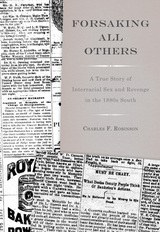 Forsaking All Others: A True Story of Interracial Sex and Revenge in the 1880s South
Charles F. Robinson
University of Tennessee Press, 2010
An intensely dramatic true story, Forsaking All Others recounts the fascinating case of an interracial couple who attempted, in defiance of society’s laws and conventions, to formalize their relationship in the post-Reconstruction South. It was an affair with tragic consequences, one that entangled the protagonists in a miscegenation trial and, ultimately, a desperate act of revenge.
From the mid-1870s to the early 1880s, Isaac Bankston was the proud sheriff of Desha County, Arkansas, a man so prominent and popular that he won five consecutive terms in office. Although he was married with two children, around 1881 he entered into a relationship with Missouri Bradford, an African American woman who bore his child. Some two years later, Missouri and Isaac absconded to Memphis, hoping to begin a new life there together. Although Tennessee lawmakers had made miscegenation a felony, Isaac’s dark complexion enabled the couple to apply successfully for a marriage license and take their vows. Word of the marriage quickly spread, however, and Missouri and Isaac were charged with unlawful cohabitation. An attorney from Desha County, James Coates, came to Memphis to act as special prosecutor in the case. Events then took a surprising turn as Isaac chose to deny his white heritage in order to escape conviction. Despite this victory in court, however, Isaac had been publicly disgraced, and his sense of honor propelled him into a violent confrontation with Coates, the man he considered most responsible for his downfall. Charles F. Robinson uses Missouri and Isaac’s story to examine key aspects of post-Reconstruction society, from the rise of miscegenation laws and the particular burdens they placed on anyone who chose to circumvent them, to the southern codes of honor that governed both social and individual behavior, especially among white men. But most of all, the book offers a compelling personal narrative with important implications for our supposedly more
tolerant times.
 The Forsyth Experiment: An Alternative System for Dental Care
Ralph R. Lobene
Harvard University Press, 1979 The largest unmet health need in this country—and potentially the most costly—is for dental care; meeting this need would strain existing personnel and facilities beyond capacity. This book reports an experiment in delivering dental care by means that are not traditional but preserve the high standards that have been achieved by American dentistry.
At the Forsyth Dental Center in Boston, Massachusetts, graduate dental hygienists received additional training in the administration of local anesthesia, drilling decayed teeth, and filling them. The program was designed to prepare dental auxiliaries to undertake restorative treatment under the direct supervision of a dentist who assumes ultimate responsibility for planning treatment, assessing the quality of performance, and assuring the patient's well-being.
The Forsyth experiment yielded information on the competence of auxiliaries trained in this fashion, on patient acceptance, on the efficiency of various patterns of practice, and on the potential economic effects of delivering care in this way. The results of the study are bound to stir controversy, but they cannot be ignored by anyone who cares about a major problem in health care.
The Fort Ancient Aspect
James Bennett Griffin
University of Michigan Press, 1943 James B. Griffin presents an analysis of the archaeological remains from central Ohio Valley. He reports on sites in Indiana, Ohio, West Virginia, and Kentucky, including the Baum site, the Feurt site, the Madisonville site, and more. This encyclopedic work is based in large part on Griffin’s study of the pottery collection in the Ceramic Repository for the Eastern United States, held at the University of Michigan Museum of Anthropological Archaeology. Lavishly illustrated with 185 black and white photographs, maps, and figures.
Fort Bowie Material Culture
Robert M. Herskovitz
University of Arizona Press, 1978 The Anthropological Papers of the University of Arizona is a peer-reviewed monograph series sponsored by the School of Anthropology. Established in 1959, the series publishes archaeological and ethnographic papers that use contemporary method and theory to investigate problems of anthropological importance in the southwestern United States, Mexico, and related areas.
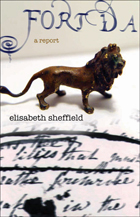 Fort Da: A Report
Elisabeth Sheffield
University of Alabama Press, 2009 A psychological and linguistic exploration of obsession and illicit love.
While working at a sleep lab in northern Germany, Rosemarie Ramee, a 38-year-old American neurologist, falls in love with Aslan, an eleven-year-old Turkish Cypriot. To get closer to the boy, RR undertakes a "marriage of convenience" to the boy's uncle. But when the uncle suddenly disappears, Ramee, alone with Aslan, must take the boy to his relatives in northern Cyprus. A train journey ensues, chronicled in RR's psychological reports and neurological inquiries.
But what begins as an objective "report" breaks down as the story progresses: RR's voice, hitherto suppressed and analytical, emerges hesitantly and then erupts, splintering every conception of inner and outer lives, solipsistic reality, and the irrevocable past. Consistently surprising and unrelenting, Fort Da turns one woman's illicit affair into a riveting exploration of language and the mind.
Fort Dearborn: A Novel
Jerry Crimmins
Northwestern University Press, 2008 In a story that brings to life the founding of one of the world's great cities, Fort Dearborn takes us back to Chicago's early struggle of fire and blood. Through the eyes of two young boys and their fathers—one father a sergeant with the United States First Infantry, the other a Potawatomi warrior—we see the events that lead up to the Fort Dearborn Massacre. Using scores of letters, historical documents and maps, and long-forgotten Native American speeches, Jerry Crimmins breathes life into the little known drama that took place in the vicinity of the fort that once occupied what is now downtown Chicago. A suspenseful narrative, Fort Dearborn is also a remarkable historical account, minutely observed and meticulously documented, preserving a key moment in American history.
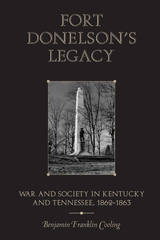 Fort Donelson's Legacy: War and Society in Kentucky and Tennessee, 1862–1863
Benjamin Franklin Cooling
University of Tennessee Press, 2010 Fort Donelson's Legacy portrays the tapestry of war and society in the upper southern heartland of Tennessee and Kentucky after the key Union victories at Forts Henry and Donelson in February 1862. Those victories, notes Benjamin Franklin Cooling, could have delivered the decisive blow to the Confederacy in the West and ended the war in that theater. Instead, what followed was terrible devastation and bloodshed that embroiled soldier and civilian alike.
Cooling compellingly describes a struggle that was marked not only by the movement of armies and the strategies of generals but also by the rise of guerrilla bands and civil resistance. It was, in part, a war fought for geography—for rivers and railroads and for strategic cities such as Nashville, Louisville, and Chattanooga. But it was also a war for the hearts and minds of the populace. "Stubborn civilian opposition to Union invaders," Cooling writes, "prompted oppressive military occupation, subversion of civil liberties, and confiscation of personal property in the name of allegiance to the United States—or to the Confederacy, for that matter, since some Unionist southerners resented Confederate intrusion fully as much as their secessionist neighbors opposed Yankee government."
In exploring the complex terrain of "total war" that steadily engulfed Tennessee and Kentucky, Cooling draws on a huge array of sources, including official military records and countless diaries and memoirs. He makes considerable use of the words of participants to capture the attitudes and concerns of those on both sides. The result is a masterful addition to Civil War literature that integrates the military, social, political, and economic aspects of the conflict into a large and endlessly fascinating picture.
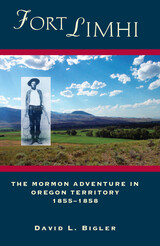 Fort Limhi: The Mormon Adventure in Oregon Territory, 1855-1858
David L. Bigler
Utah State University Press, 2004
In May 1855 twenty-seven men set out from the young Mormon settlements in Utah to establish the northernmost colony of the Kingdom of God, "the Northern Mission to the Remnants of the House of Jacob"-American Indians. More colonists, including families, would join them later. Building a fort in the Limhi Valley, four hundred miles to the north and at the foot of the pass by which Lewis and Clark had crossed the Continental Divide, they began to proselyte among Sacagawea's Shoshone relatives as well as members of the Bannock, Nez Percé, and other tribes. Three years later, some of their expected and actual Indian converts violently drove the colonists out and destroyed Fort Limhi.
In Fort Limhi: The Mormon Adventure in Oregon Territory, 1855-1858, David Bigler shows that the colony, known as the Salmon River Mission, played a pivotal role in the Utah War of 1857-1858 and that the catastrophic end of the mission was critical in keeping that conflict from becoming an all out war between Mormon Utah and the United States. In the process, he uses a multitude of primary sources, many newly uncovered or previously overlooked, to reconstruct a dramatic and compelling story involving stalwart Mormon frontiersmen, Brigham Young, a variety of Native American individuals and groups, the U. S. Army, and "mountaineers," as the surviving fur trade veterans now commonly known as "mountain men" called themselves.
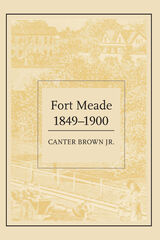 Fort Meade, 1849–1900
Canter Brown
University of Alabama Press, 1995 The oldest town in interior south Florida, Fort Meade lies about 50 miles east of Tampa and 10 miles south of Polk County's seat of Bartow. In this volume, Polk County native Canter Brown recounts the intriguing story of the founding and evolution of Fort Meade during the last half of the 19th century, when it was first established as a military outpost to separate Seminoles from white pioneer families desirous of cattle-grazing lands. A civilian community coalesced at Fort Meade under the pressures of the Billy Bowlegs War of 1855-58. Quickly the village developed as a cattle-industry center, which was important to the Confederacy until its destruction in 1864 by home-grown Union forces.
In the postwar era the cattle industry revived, and the community prospered. The railroads arrived in the 1880s, bringing new settlers, and the village grew into a town. Opportunities expanded as well with the growth of citrus, phosphate mining, truck farming, and tobacco industries. A boom-and-bust economy alternately bolstered and rocked the town, and the disastrous freezes of 1894Ð95 almost delivered a fatal blow.
Little has been written about town development on the Florida frontier. This book portrays the extremely complicated and often exciting processes and influences at play in interior south Florida, and the very precarious hold that town life possessed on that frontier.Local history the way it should be written. Canter Brown has managed to score several significant accomplishments in Fort Meade, 1849-1900. The book contributes to the growing body of good, solid monographs dealing with Florida state and local history and represents the building blocks necessary for a state and regional synthesis. The cumulative research compiled for this volume is impressive and daunting. Canter Brown proves that good local history requires considerable detective work and far-ranging inquiries.
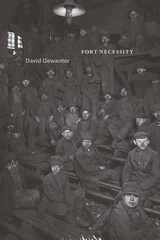 Fort Necessity
David Gewanter
University of Chicago Press, 2018 Who are the lords of labor? The owners, or the working bodies? In this smart, ambitious, and powerful book, David Gewanter reads the body as creator and destroyer—ultimately, as the broken mold of its own work.
Haunted by his father’s autopsy of a workman he witnessed as a child, Gewanter forges intensely personal poems that explore the fate of our laboring bodies, from the Carnegie era’s industrial violence and convict labor to our present day of broken trust, profiteering, and the Koch brothers. Guided by a moral vision to document human experience, this unique collection takes raw historical materials—newspaper articles, autobiography and letters, court testimony, a convict ledger, and even a menu—and shapes them into sonnets, ballads, free verse, and prose poems. The title poem weaves a startling lyric sequence from direct testimony by steelworkers and coal-miners, strikers and members of prison chain-gangs, owners and anarchists, revealing an American empire that feeds not just on oil and metal, but also on human energy, impulse, and flesh. Alongside Gewanter’s family are hapless souls who dream of fortune, but cannot make their fates, confronting instead the dark outcomes of love, loyalty, fantasy, and betrayal.
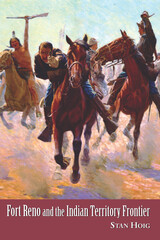 Fort Reno and the Indian Territory Frontier
Stan Hoig
University of Arkansas Press, 2005 Following the Indian uprising known as the Red River War, Fort Reno (in what would become western Oklahoma) was established in 1875 by the United States government. Its original assignment was to serve as an outpost to exercise control over the Cheyenne and Arapaho Indians. But Fort Reno also served as an embryonic frontier settlement around which the first trappings of Anglo-American society developed a regulatory force between the Indian tribes and the white man, and the primary arm of government responsible for restraining land-hungry whites from invading country promised to Native American tribes by treaty. With the formation of the new Territory of Oklahoma and introduction of civil law, Fort Reno was forced to assume another purpose: it became a cavalry remount center. But when the mechanization of the military brought an end to the horse cavalry, the demise of Fort Reno was imminent. When Ben Clark, the prideful scout who knew and loved Fort Reno, ended his own life in 1914, the military post that had once thrived on America’s frontier was brought to a poignant end.
The story of Fort Reno, as detailed here by Stan Hoig, touches on several of the most important topics of nineteenth-century Western history: the great cattle drives, Indian pacification and the Plains Wars, railroads, white settlement, and the Oklahoma land rushes. Hoig deals not only with Fort Reno, but also with Darlington agency, the Chisolm Trail, and the trading activities in Indian Territory from 1874 to approximately 1900. The author includes maps, photographs, and illustrations to enhance the narrative and guide the reader, like a scout, through a time of treacherous but fascinating events in the Old West.
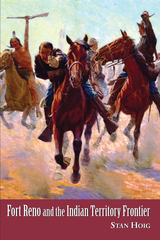 Fort Reno and the Indian Territory Frontier
Stan Hoig
University of Arkansas Press, 2005 Following the Indian uprising known as the Red River War, Fort Reno (in what would become western Oklahoma) was established in 1875 by the United States government. Its original assignment was to serve as an outpost to exercise control over the Cheyenne and Arapaho Indians. But Fort Reno also served as an embryonic frontier settlement around which the first trappings of Anglo-American society developed a regulatory force between the Indian tribes and the white man, and the primary arm of government responsible for restraining land-hungry whites from invading country promised to Native American tribes by treaty. With the formation of the new Territory of Oklahoma and introduction of civil law, Fort Reno was forced to assume another purpose: it became a cavalry remount center. But when the mechanization of the military brought an end to the horse cavalry, the demise of Fort Reno was imminent. When Ben Clark, the prideful scout who knew and loved Fort Reno, ended his own life in 1914, the military post that had once thrived on America’s frontier was brought to a poignant end.
The story of Fort Reno, as detailed here by Stan Hoig, touches on several of the most important topics of nineteenth-century Western history: the great cattle drives, Indian pacification and the Plains Wars, railroads, white settlement, and the Oklahoma land rushes. Hoig deals not only with Fort Reno, but also with Darlington agency, the Chisolm Trail, and the trading activities in Indian Territory from 1874 to approximately 1900. The author includes maps, photographs, and illustrations to enhance the narrative and guide the reader, like a scout, through a time of treacherous but fascinating events in the Old West.
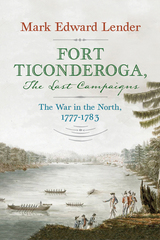 Fort Ticonderoga, The Last Campaigns: The War in the North, 1777–1783
Mark Edward Lender
Westholme Publishing, 2022 During the War for Independence, Fort Ticonderoga’s guns, sited critically between Lakes Champlain and George, dominated north-south communications in upstate New York that were vital to both the British and American war efforts. In the public mind Ticonderoga was the “American Gibraltar” or the “Key to the Continent,” and patriots considered holding the fort essential to the success of the Revolutionary cause. Ticonderoga was a primary target in British Lieutenant General John Burgoyne’s 1777 campaign to crush American resistance in the north and end the rebellion in a decisive stroke. American efforts to defend the fort in June against overwhelming odds entailed political and military intrigue, bungling, heroism, and ultimately a narrow escape for the Continental and provincial forces under Major General Arthur St. Clair. The loss of Ticonderoga stunned patriot morale and ignited one of the greatest political firestorms of the war. But the fortunes of war turned. Two months later, the rebels mounted a sensational—if little known—counter-attack on Ticonderoga that had major implications for Burgoyne’s eventual defeat at Saratoga in October. Yet Saratoga brought no peace, and Ticonderoga would be central to additional military and political maneuverings—many of them known only to specialist historians—that would keep the region on edge until the end of the war in 1783. Based on new archival research and taking advantage of the latest scholarship, Fort Ticonderoga, The Last Campaigns: The War in the North, 1777-1783 by distinguished historian Mark Edward Lender highlights the strategic importance of the fort as British, American, and regional forces (including those of an independent Vermont Republic) fought for control of the northern front at a critical point in the war. The book tells the Ticonderoga story in all of its complexity and drama, correcting misconceptions embedded in many previous accounts, and sheds vital new light on this key chapter in America’s struggle for independence.
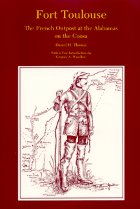 Fort Toulouse: The French Outpost at the Alabamas on the Coosa
Daniel H Thomas, with an introduciton by Gregory A. Waselkov
University of Alabama Press, 1989 Situated at the head of the Alabama River system—at the juncture of the Coosa and Tallapoosa rivers—Fort Toulouse in 1717 was planned to keep the local Indians neutral, if not loyal, to the French and contain the British in their southernmost Atlantic colonies. Unlike the usual frontier settlements, Fort Toulouse was both a diplomatic post, since its officers acted as resident ministers, and a military post. Because it was located in a friendly territory adjoining an area under a rival (British) influence, the post participated in psychological warfare rather than in blood-letting. It used trade and aid, and was familiar with spies and double-agents—welcoming and debriefing British defectors; no cannon was discharged in anger at Toulouse.
The most eminent figure to have been connected directly with Fort Toulouse was General Andrew Jackson, who established a military post there during the War of 1812 after his victory over the Indians at Horseshoe Bend. The outpost was named Fort Jackson in his honor and played a key role in the treaty negotiations and eventual settlement of the Indian land by Americans.
In addition to discussing geopolitical and military affairs and diplomatic relations with Indian chiefs, Thomas describes daily life at the post and the variety of interactions between residents and visitors. Waselkov's introduction places the original 1960 book within the context of the existing scholarship of that time and adds an extensive and enlightening review of the most recent archaeological and historical research to Thomas' pioneering work.
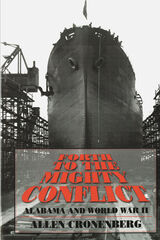 Forth to the Mighty Conflict: Alabama and World War II
Allen Cronenberg
University of Alabama Press, 1995 Details conditions in Alabama and the role of its citizens in a time of military crisis unknown since the Civil War
Alabama and its people played a conspicuous role in World War II. Not only were thousands of servicemen trained at military facilities in the state—at Fort McClellan, Camp Rucker, Camp Sibert, Maxwell Air Field, and Tuskegee Army Air Field—but Axis prisoners of war were interned in camps on Alabama soil. The state of Alabama held a significant number of these prisoners, over seventeen thousand in four camps across the state: Camp Aliceville, Camp Opelika, Fort McClellan, and Fort Rucker. This study focuses on Camp Aliceville and Camp Opelika which provide a sample that frames and highlights the national prisoner of war program. Through this example, one can see the lasting legacy of the prisoner of war program and its role in transforming the United States and forever changing the lives of thousands of prisoners, guards, and local citizens. An analysis of the Alabama camps also reveals how memory is constructed and how one narrative can ultimately emerge as the dominant story. In addition, a survey of the landscape reveals the importance of place and its role in the process of remembering and forgetting.
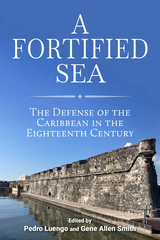 A Fortified Sea: The Defense of the Caribbean in the Eighteenth Century
Edited by Pedro Luengo and Gene Allen Smith
University of Alabama Press, 2024 Winner of The Society for Military History's 2025 Distinguished Book Award
A multidisciplinary examination of the role of military forts in the Caribbean during the age of European colonial expansion
A Fortified Sea illuminates the key role of military forts in the greater Caribbean during the long eighteenth century. The historical Caribbean, with its multiple contested boundaries at the periphery of European western expansion, typically has been analyzed as part of an empire. European powers, including Spain, the Netherlands, England, and Denmark, carved up the Caribbean Sea into a cultural patchwork. These varied cultural contexts were especially evident during regional and national conflicts throughout the eighteenth century and prompted the construction of more fortifications to protect imperial interests. The emergence of Anglo-American colonies during the eighteenth century and later the United States gradually altered previous geopolitical balances, redefining the cultural and geopolitical boundaries of the region. This collection of essays incorporates several historiographical traditions—from Spanish to American—all portraying the borderland as a breakthrough contested cultural, social, economic, and military boundary. A multinational roster of contributors approaches topics through a war studies lens as well as architecturally and historically, enriching a usually monothematic view. As well, discussion of cultural management of the historical remains of forts shows local communities trying to preserve and interpret the role of forts in society. Part I defines the training of military engineers in Spain. Part II engages with British defensive military plans and settlements in the Caribbean and shows how the British dealt with the rhetorical image of the empire. Part III clarifies the building processes of fortifications in Santiago de Cuba, Cartagena de Indias, Havana, and Veracruz, among other places. Copious period maps complement the prodigious research. The book will appeal to readers interested in the history of the Caribbean, military history, and European imperial expansion.
CONTRIBUTORS
Mónica Cejudo Collera / Pedro Cruz Freire / María Mercedes Fernández Martín / Aaron Graham / Manuel Gámez Casado / Francisco Javier Herrera García / Nuria Hinarejos Martín / Pedro Luengo / Ignacio J. López-Hernández / José Miguel Morales Folguera / Alfredo J. Morales / Juan Miguel Muñoz Corbalán / Jesús Maria Ruiz Carrasco / Germán Segura García / Gene Allen Smith / Christopher K. Waters
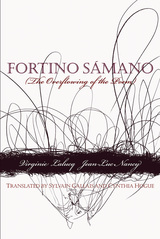 Fortino Sámano: The Overflowing of the Poem
Virginie Lalucq and Jean-Luc Nancy
Omnidawn, 2012 Fortino Sámano (the overflowing of the poem), translated by Cynthia Hogue and Sylvain Gallais, with French on facing pages, is a collaborative work by the emerging French poet, Virginie Lalucq, and the distinguished philosopher, Jean-Luc Nancy. Lalucq wrote the serial poem, Fortino Sámano, after seeing an exhibit of photographs on the Mexican Revolution by Agustin Victor Casasola. Her series is a meditation on the single, extant photograph of Sámano, a Zapatista lieutenant and counterfeiter, which Casasola snapped as Sámano, smoking a last cigar, appeared to stare death nonchalantly in the face moments before his execution by firing squad (it was reported that he himself gave the order to fire). Little is known about Sámano, and Lalucq’s poem makes no attempt to be biographical or historical. Rather, she treats the image itself, the fact that the camera caught the image of life just prior to its end. What, then, does the image represent? She asks. Nancy’s section, Les débordements du poème (The overflowing of the poem), is a series of poetic commentaries on each of the poems in Lalucq’s series. It is a philosophical contemplation of the specific poem, Fortino Sámano, and also, a poetic investigation of the lyric genre, which works hand-in-hand with Lalucq’s poems. Fortino Sámano is an exciting poetic dialogue, and a significant work in poetics, which Hogue and Gallais have brought into English.
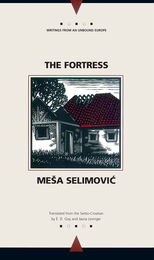 The Fortress: A Novel
Mesa Selimovic, translated from the Serbian by Edward Dennis Goy and Jasna Levinger-Goy
Northwestern University Press, 1999 The Fortress is one of the most significant and fascinating novels to come out of the former Yugoslavia. Published as Tvrđava in Serbian, it is the tenth and among the best-known novels by Mesa Selimovic (1910–1982). In the novel, Ahmet Shabo returns home to seventeenth-century Sarajevo from the war in Russia, numbed by the death in battle or suicide of nearly his entire military unit. In time he overcomes the anguish of war, only to find that he has emerged a reflective and contemplative man in a society that does not value, and will not tolerate, the subversive implications of these qualities.
Set in Bosnia in the late 1700s, the novel sometimes functions as an artful metaphor for the communist Yugoslavia of Selimovic's day. At other times, the author explores the nuances of Ottoman rule in the Balkans. Muslim Ahmet's sustaining marriage to a young Christian woman provides a multicultural tension that strongly resonates with contemporary readers and sensibilities.
Fortress of My Youth: Memoir of a Terezín Survivor
Jana Renée Friesová
University of Wisconsin Press, 2011 Jana Renée Friesová was fifteen when she was imprisoned by the Nazis in the Czech ghetto town of Terezín. Her memoir tells the poignantly familiar story of a young girl who, even under the most abominable circumstances, engages in intense adolescent friendships, worries with her companions over her looks, and falls in love.
Anne Frank’s diary ends with deportation to a concentration camp; Fortress of My Youth, in contrast, takes the reader deep into the horrors of daily life in a camp that were faced by a young girl and her family. But Friesová also tells of love, joy, sacrifice, and the people who shared in the most profound experiences of her life.
 Fortress Power: Hostile Designs and the Politics of Spatial Control
Derek S. Denman
University of Minnesota Press, 2025 A compelling treatise on the relationship between power and enclosure Fortress Power presents a genealogy of fortification as a material and political technology intent on obstruction, tracing its implementation across battlefields, borders, and urban environments. Drawing on the influential work of philosophers Michel Foucault and Giorgio Agamben, Derek S. Denman places the fortress alongside the archetypes of the prison and the camp, citing them as paradigmatic of how space is transformed into a tool of domination and control. Focusing on the defensive architecture of bastion fortresses, urban design, and border landscapes, Fortress Power charts the rise of a form of governance grounded in hostility, extending the scope of its subject from a piece of military construction to a much broader political concept. Detailing how power manifests in everything from city centers to international boundaries, the book analyzes the logic of fortification as it moves through various contexts in the advancement of surveillance, exploitation, warfare, and political authority. Through a unique blend of architecture and design studies, political theory, international relations, geography, and migration studies, Denman outlines the disquieting legacy of the fortress to highlight its role in the formation of modern government and the enactment of violence. In an era marked by the increasing prevalence of authoritarian power and conflicting geopolitical boundaries, he presents an insightful investigation of the weaponization of the built environment.
Fortressing Pixels: Information security for images, videos, audio and beyond
Subhrajyoti Deb
The Institution of Engineering and Technology, 2025 Emerging and pivotal technologies such as artificial intelligence and deep learning, cloud computing, internet of things, blockchain, encryption, and quantum cryptography are required to meet multimedia data's evolving needs and security requirements. In digital imaging, a pixel is the smallest element of an image that can be manipulated through software. Pixels within a digital image or graphical user interface must be secured to control unauthorized access or manipulation.
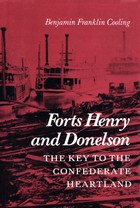 Forts Henry and Donelson: The Key to the Confederate Heartland
Benjamin Franklin Cooling
University of Tennessee Press, 1987 Forts Henry and Donelson portrays the tapestry of war and society in the upper southern heartland of Tennessee and Kentucky after key Union victories in February 1862. Those victories, notes Benjamin Franklin Cooling, could have delivered the decisive blow to the Confederacy in the West and ended the war in that theater. Instead, what followed was terrible devastation and bloodshed that embroiled soldier and civilian alike. Cooling compellingly describes a struggle that was marked not only by the movement of armies and the strategies of generals but also by the rise of guerrilla bands and civil resistance. It was, in part, a war fought for geography—for rivers and railroads and for strategic cities such as Nashville, Louisville, and Chattanooga. But it was also a war for the hearts and minds of the populace. “Stubborn civilian opposition to Union invaders,” Cooling writes, “prompted oppressive military occupation, subversion of civil liberties, and confiscation of personal property in the name of allegiance to the United States—or to the Confederacy, for that matter, since some Unionist southerners resented Confederate intrusion fully as much as their secessionist neighbors opposed Yankee government.” In exploring the complex terrain of “total war” that steadily engulfed Tennessee and Kentucky, Cooling draws on a huge array of sources, including official military records and countless diaries and memoirs. He makes considerable use of the words of participants to capture the attitudes and concerns of those on both sides. The result is a masterful addition to Civil War literature that integrates the military, social, political, and economic aspects of the conflict into a large and endlessly fascinating picture.
 Fortunate People in a Fortunate Land: At Home in Santa Monica's Rent-Controlled Housing
Lauren E. M. Everett
Temple University Press, 2025 Rent control and other tenant protections have profound and positive impacts on individuals’ and communities’ lives. Lauren Everett’s Fortunate People in a Fortunate Land shows how rent control impacts the lives of the renters themselves. Everett interviews residents about their experiences in low- and middle-income households in rent-controlled private market housing in Santa Monica, CA, a city where Everett was born and raised but can no longer afford to live.
Everett seeks to understand the extent to which individuals feel at home or not at home and what factors contribute to those experiences. She also explores the nexus of Santa Monica’s tenant protection policies, infrastructure, and resources and the extent to which they inform stability—both perceived and actual—and life decisions.
The first scholarly book to take a tenant-centered approach to examining the benefits and problems of rent control, Fortunate People in a Fortunate Land examines the residential experience in this specific local context and explains how it relates to policy and other externalities in cities where homeownership is not financially viable for most renters.
In the series Urban Life, Landscape, and Policy
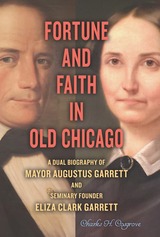 Fortune and Faith in Old Chicago: A Dual Biography of Mayor Augustus Garrett and Seminary Founder Eliza Clark Garrett
Charles H. Cosgrove
Southern Illinois University Press, 2020 This engaging biography of Augustus Garrett and Eliza Clark Garrett tells two equally compelling stories: an ambitious man’s struggle to succeed and the remarkable spiritual journey of a woman attempting to overcome tragedy. By contextualizing the couple’s lives within the rich social, political, business, and religious milieu of Chicago’s early urbanization, author Charles H. Cosgrove fills a gap in the history of the city in the mid-nineteenth century. The Garretts moved from the Hudson River Valley to a nascent Chicago, where Augustus made his fortune in the land boom as an auctioneer and speculator. A mayor during the city’s formative period, Augustus was at the center of the first mayoral election scandal in Chicago. To save his honor, he resigned dramatically and found vindication in his reelection the following year. His story reveals much about the inner workings of Chicago politics and business in the antebellum era. The couple had lost three young children to disease, and Eliza arrived in Chicago with deep emotional scars. Her journey exemplifies the struggles of sincere, pious women to come to terms with tragedy in an age when most people attributed unhappy events to divine punishment. Following Augustus’s premature death, Eliza developed plans to devote her estate to founding a women’s college and a school for ministerial training, and in 1853 she endowed a Methodist theological school, the Garrett Biblical Institute (now the Garrett-Evangelical Theological Seminary), thereby becoming the first woman in North America to found an institution of higher learning. In addition to illuminating our understanding of Chicago from the 1830s to the 1850s, Fortune and Faith in Old Chicago explores American religious history, particularly Presbyterianism and Methodism, and its attention to gender shows how men and women experienced the same era in vastly different ways. The result is a rare, fascinating glimpse into old Chicago through the eyes of two of its important early residents.
 Fortune and Misfortune at Saint Gall
Ekkehard IV
Harvard University Press, 2021 The eleventh-century monk Ekkehard IV’s Fortune and Misfortune at Saint Gall, part of the chronicles of the famous Swiss abbey, is a treasure trove of medieval monastic life. Saint Gall’s records span its humble beginnings in the early seventh century to the late Middle Ages, with Ekkehard’s contribution covering the 880s to 972, near the end of the monastery’s two-century-long golden age. Its unforgettable tales, sometimes at odds with the historical record, contain sharp flashes of Ekkehard’s signature humor—when, for instance, a spying abbot from a neighboring monastery is caught hiding in the latrine. Ekkehard also shows how the abbey’s role as a spiritual haven could be compromised by worldly ties, including close associations with the powerful Carolingian and Ottonian courts. He bears witness to the struggles of the tenth-century church reform movement, when Emperor Otto I dispatched investigators to uncover Saint Gall’s deviations from the Rule of Saint Benedict.
This volume publishes the Latin text alongside its first complete English translation.
Fortune Is a Woman: Gender and Politics in the Thought of Niccolo Machiavelli
Hanna Fenichel Pitkin
University of Chicago Press, 1999 "Fortune is a woman, and if you want to keep her under, you've got to knock her around some."—Niccolò Machiavelli
Hanna Pitkin's provocative and enduring study of Machiavelli was the first to systematically place gender at the center of its exploration of his political thought. In this edition, Pitkin adds a new afterword, in which she discusses the book's critical reception and situates the book's arguments in the context of recent interpretations of Machiavelli's thought.
"A close and often brilliant exegesis of Machiavelli's writings."—The American Political Science Review
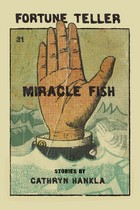 Fortune Teller Miracle Fish
Cathryn Hankla
Michigan State University Press, 2011 A mentally challenged teen in a coma, a WWII veteran weighing his beliefs, an intersexed man anticipating a relationship, a single woman who has kissed far too many frogs, and a first grader suffering at the hands of a family friend. These are just a few of the unforgettable characters in Fortune Teller Miracle Fish, an innovative collection of stories from award-winning novelist and poet Cathryn Hankla. The figures in these stories struggle toward more truthful expressions of themselves, as outsiders whose dilemmas, emotions, and desires make them unmistakably human. As varied as they are vivid, they strive for closer connections of love and community. Through humor and understanding, Hankla intrepidly navigates the transitions that define them—unplanned pregnancy, divorce, death, and gender change, to name a few. Acutely attuned to her subjects’ inner landscapes, Hankla captures the full spectrum of human experience, from childhood to old age, with heart, rare skill, and nerve.
Fortune's Favored Child
Raouf Mama
Northwestern University Press, 2014 Raouf Mama is widely beloved by children and adults alike for his books and especially for his African and multicultural storytelling, which incorporates poetry, song, music, and dance. In Fortune’s Favored Child, the master storyteller tells his own story, beginning in the West African country of Benin. Through a harrowing experience with sickness, an encounter with a clairvoyant traditional healer, and astonishing twists of fortune, the protagonist struggles to uncover his real identity, to get an education, and to make his own way in the world. His journey takes him to the shores of the United States to attend graduate school at the University of Michigan and begin a new chapter in his life. .
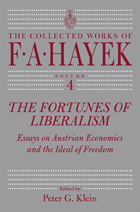 The Fortunes of Liberalism: Essays on Austrian Economics and the Ideal of Freedom
F. A. Hayek
University of Chicago Press, 1991 The Reagan and Thatcher "revolutions." The collapse of Eastern Europe dramatically captured in the tearing down of the Berlin Wall. F. A. Hayek, "grand old man of capitalism" and founder of the classical liberal, free-market revival which ignited and inspired these world events, forcefully predicted their occurrence in writings such as The Road to Serfdom, first published in 1944.
Hayek's well-known social and political philosophy—in particular his long-held pessimistic view of the prospects of socialism, irrefutably vindicated by the recent collapse of the Eastern bloc—is fully grounded in the Austrian approach to economics. In this new collection, Hayek traces his intellectual roots to the Austrian school, the century-old tradition founded at the University of Vienna by Carl Menger, and links it to the modern rebirth of classical liberal or libertarian thought.
As Hayek reminds us, the cornerstone of modern economics—the theory of value and price—"represents a consistent continuation of the fundamental principles handed down by the Vienna school." Here, in this first modern collection of essays on the Austrian school by one of its preeminent figures, is the genesis of this tradition and its place in intellectual history.
Reflections on Hayek's days as a young economic theorist in Vienna, his opening address to the inaugural meeting of the Mont Pèlerin Society, and essays on former teachers and other leading figures in the Austrian school are included in volume 4. Two hitherto unavailable memoirs, "The Economics of the 1920s as Seen from Vienna," published here for the first time, and "The Rediscovery of Freedom: Personal Recollections," available for the first time in English, make this collection invaluable for Hayek scholars.
Hayek's writings continue to provide an invaluable education in a subject which is nothing less than the development of the modern world.
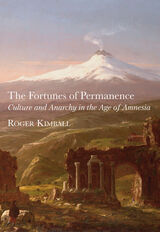 The Fortunes of Permanence: Culture and Anarchy in an Age of Amnesia
Roger Kimball
St. Augustine's Press, 2022 “Cultural instructions.” Everyone who has handled a package of seedlings has encountered that enigmatic advisory. This much water and that much sun, certain tips about fertilizer, soil, and drainage. Planting one sort of flower nearby keeps the bugs away but proximity to another sort makes bad things happen. Young shoots might need stakes, and watch out for beetles, weeds, and unseasonable frosts. It’s a complicated business.
But at least since Cicero introduced the term cultura animi (“cultivation of the mind or spirit”), such “cultural instructions” have applied as much to the realm of civilization as to horticulture. In this wide-ranging investigation into the vicissitudes of culture in the twenty-first century, the distinguished critic Roger Kimball traces the deep filiations between cultivation as a spiritual enterprise and the prerequisites of political freedom. Drawing on figures as various as James Burnham, Richard Weaver, G. K. Chesterton, Rudyard Kipling, John Buchan, Friedrich von Hayek, and Leszek Kolakowski, Kimball traces the interconnections between what he calls the fortunes of permanence and such ambassadors of anarchy as relativism, multiculturalism, and the socialist-utopian imperative.
With his signature blend of wit and erudition, Kimball deftly draws on the resources of art, literature, and political philosophy to illuminate some of the wrong turns and dead ends our culture has recently pursued, while also outlining some of the simple if overlooked alternatives to the various tyrannies masquerading as liberation we have again and again fallen prey to. This rich, rewarding, and intelligent volume bristles with insights into what the nineteenth-century novelist Anthony Trollope called “The Way We Live Now.”
Partly an exercise in cultural pathology, The Fortunes of Permanence is also a forward-looking effort of cultural recuperation. It promises to be essential reading for anyone concerned about the direction of Western culture in an age of anti-Western animus and destructive multicultural fantasy.
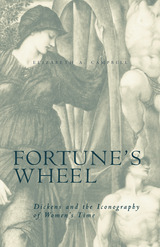 Fortune’s Wheel: Dickens and the Iconography of Women’s Time
Elizabeth A. Campbell
Ohio University Press, 2003 In the first half of the nineteenth century, England became quite literally a world on wheels. The sweeping technological changes wrought by the railways, steam-powered factory engines, and progressively more sophisticated wheeled conveyances of all types produced a corresponding revolution in Victorian iconography: the image of the wheel emerged as a dominant trope for power, modernity, and progress. In Fortune’s Wheel, an original and illuminating study, Elizabeth Campbell explores the ways in which Charles Dickens appropriated and made central to his novels the dominant symbol of his age. Between 1840 and 1860, a transformation took place in Dickens’ thinking about gender and time, and this revolution is recorded in iconographic representations of the goddess Fortune and wheel imagery that appear in his work. Drawing on a rich history of both literary and visual representations of Fortune, Professor Campbell argues that Dickens’ contribution to both the iconographic and narrative traditions was to fuse the classical image of the wheel with the industrial one. As the wheel was increasingly identified as the official Victorian symbol for British industrial and economic progress, Dickens reacted by employing this icon to figure a more pessimistic historical vision—as the tragic symbol for human fate in the nineteenth century. Fortune’s Wheel ably portrays the concept that, in both text and illustrations, images of fortune and the wheel in Dickens’ work record his abandonment of a linear, progressive, and arguably masculine view of history to embrace a cyclical model that has been identified with “women’s time.”
Forty Lost Years
Rosa Maria Arquimbau, Translated by Peter Bush
Fum d'Estampa Press, 2021 Published for the first time in 1971, Forty Lost Years tells the captivating story of Laura Vidal, a working-class woman who becomes a high-fashion dressmaker to the bourgeois ladies of Barcelona during Franco’s dictatorship. Beginning in 1931, with the proclamation of the Republic, and ending in the 1970s, Rosa Maria Arquimbau’s masterpiece paints a vivid picture of forty years in Catalan history. Weaving the personal and the political, Forty Lost Years is a bitter tale that immerses readers into the frivolous atmosphere of a sexually liberal republican Barcelona, and the despair of a country defeated by the Fascists.
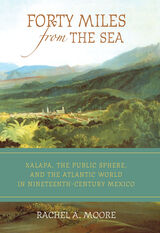 Forty Miles from the Sea: Xalapa, the Public Sphere, and the Atlantic World in Nineteenth-Century Mexico
Rachel A. Moore
University of Arizona Press, 2011 While the literature on Atlantic history is vast and flourishing, few studies have examined the importance of inland settlements to the survival of Atlantic ports. This book explores the symbiotic yet conflicted relationships that bound the Mexican cities of Xalapa and Veracruz to the larger Atlantic world and considers the impact these affiliations had on communication and, ultimately, the formation of national identity.
Over the course of the nineteenth century, despite its inland location, Xalapa became an important Atlantic community as it came to represent both a haven and a place of fortification for residents of Veracruz. Yellow fever, foreign invasion, and domestic discord drove thousands of residents of Veracruz, as well as foreign travelers, to seek refuge in Xalapa. At the same time, these adverse circumstances prompted the Mexican government to use Xalapa as a bulwark against threats originating in the Atlantic.
The influence of the Atlantic world thus stretched far into central Mexico, thanks to both the instability of the coastal region and the desire of government officials to “protect” central Mexico from volatile Atlantic imports. The boundaries established at Xalapa, however, encouraged goods, information, and people to collect in the city and thereby immerse the population in the developments of the Atlantic sphere. Thus, in seeking to protect the center of the country, government authorities more firmly situated Xalapa in the Atlantic world. This connection would be trumped by national affiliation only when native residents of Xalapa became more comfortable with their participation in the Mexican public sphere later in the nineteenth century.
The interdisciplinary and comparative nature of this study will make it appeal to those studying Atlantic history, including historians of Britain, the United States, Latin America, and Africa, as well as those studying communication, print culture, and postal history more broadly.
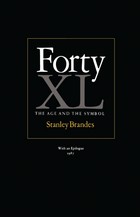 Forty: The Age and the Symbol
Stanley Brandes
University of Tennessee Press, 1987 "The distinguished anthropologist and folklorist Stanley Brandes has written an elegant and stimulating treatise on what it means to be 40 and on what 40 means as a symbol." —Gary Alan Fine, Contemporary Sociology
"Brandes's tour through numerology and etymology is rich and entertaining." — Psychology Today
"The midlife crisis is a popular topic these days, but this book is unique in that it draws upon psychology, history, literature, religion, anthropology, and folklore to present a summary of our past and present attitudes towards both the number and the age 40. An imminently readable book." — Library Journal
" Forty gratifies and consoles, as its author demonstrates how it is in our power to alter the scenario; we can change the third act in the life span, or altogether exchange the stage play/life analogy for a more truthful and rewarding vision of our lives." — Newsday
"The book is avaliant effort to formulate a perspective on the darkness and bewilderment that all too frequently descend on this 'unstable moment.' It is a friendly and supportive book. For anyone about to shoulder this yoke of years unguided, Forty is a handsome volume and a relevant gift." —Wilson Library Bulletin
Forty Years of Texas Storytelling: Historical and Contemporary Tales from Diverse Writers and Poets
Ted Parkhurst
Parkhurst Brothers, Inc., 2024 A collection of thirty-plus stories by regional storytellers, each representing the Texas Storytelling Tradition as nurtured within the Tejas Storytelling Association since 1984. Contributors to this sampler of folktales, original stories, humorous and historic tales are all part of Texas Storytelling Festival history. The Festival is an annual event in Denton, Texas.
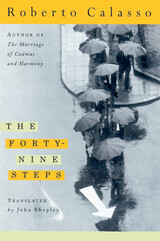 Forty-Nine Steps
Roberto Calasso
University of Minnesota Press, 2001 The first treatment of contemporary thought by the acclaimed cultural critic.
In books lauded as "brilliant,"* "exhilarating,"** and "profound,"*** Roberto Calasso has revealed the unexpected intersections of ancient and modern through topics ranging from Greek and Indian mythology to what a legendary African kingdom can tell us about the French Revolution. In this first translation of his most important essays, Calasso brings his powerful intellect and elegant prose style to bear on the essential thinkers of our time, providing a sweeping analysis of the current state of Western culture.
"Forty-nine steps" refers to the Talmudic doctrine that there are forty-nine steps to meaning in every passage of the Torah. Employing this interpretive approach, Calasso offers a "secret history" of European literature and philosophy in the wake of Nietzsche, Marx, and Freud. Calasso analyzes how figures ranging from Gustav Flaubert, Gottfried Benn, Karl Kraus, Martin Heidegger, Walter Benjamin, Franz Kafka, Bertolt Brecht, and Theodor Adorno have contributed to, or been emblematic of, the current state of Western thought. The book's theme, writ large, is the power of fable-specifically, its persistence in art and literature despite its exclusion from orthodox philosophy.
In its breadth and the nature of its concerns, The Forty-nine Steps is a philosophical and literary twin to the widely-praised The Marriage of Cadmus and Harmony. Combining erudition with engaging prose and original insights, Calasso contributes a daring new interpretation of some of the most challenging writers of the past 150 years.
Roberto Calasso is the author of The Marriage of Cadmus and Harmony (1993), The Ruin of Kasch (1994), Ka (1998), and Literature and the Gods (2000). He is the publisher of Adelphi Edizioni and lives in Milan.
John Shepley is a freelance writer and translator who lives in New York City. His translation of Pasolini's Roman Nights and Other Stories won the first Italo Calvino Translation Award in 1987.
 Forward for the People: The Autobiography of America's Longest Serving Legislator
Fred A. Risser and Doug Moe
Wisconsin Historical Society Press, 2025 When Fred Risser retired from the Wisconsin Senate in 2021, his sixty-four years in state government made him the longest serving legislator in US history. Now, in this candid and illuminating autobiography, Risser shares his singular perspective on events that transformed the state and the nation over the course of his remarkable career. From his role in the “Joe Must Go” drive to recall US Senator Joseph McCarthy in the 1950s to his position as the senior senator among the “Fab Fourteen” Wisconsin Democrats who opposed Governor Scott Walker’s Act 10 legislation against collective bargaining in 2011, Risser was a leader in state politics for decades, always maintaining an unwavering belief that political action can change people’s lives for the better. Forward for the People provides a unique peek behind the political curtain from the viewpoint of someone who saw it all. Risser worked with thirteen governors and authored more than 240 bills that became law, championing public health and safety, environmental protection, women’s and reproductive rights, organized labor, civil rights, and social justice, among many other causes. Risser also recounts interactions with prominent national politicians, including Robert La Follette Jr., Hubert Humphrey, Jimmy Carter, and Bill Clinton. More than forty photographs from Risser’s personal collection and the Wisconsin Senate paint a vivid picture of his six-decade journey through Wisconsin politics. Forward for the People details Risser’s experiences out of state, from a stint in the Panama Canal Zone as a navy hospital corpsman to his undergraduate debate-team days at Minnesota’s Carleton College to his years studying law at the University of Oregon and his travels to all seven continents. The book also depicts the quirky habits that made Risser a memorable and beloved politician: biking his age in miles every birthday and never taking the elevator in his sixty-four years at the Wisconsin State Capitol. Enhanced with details sourced from correspondence, personal notes, newspaper accounts, and recollections from friends and former colleagues, Risser and coauthor Doug Moe have crafted an engaging account of an extraordinary life in public service.
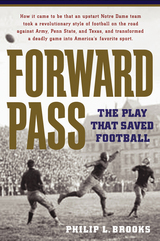 Forward Pass: The Play That Saved Football
Philip L. Brooks
Westholme Publishing, 2007 The Most Important Innovation in the History of Football
In 1913, a small, up-and-coming school came to West Point to challenge the great Army football team. The opposing quarterback dropped back, raised the football, and threw a perfect spiral to his wide open teammate. Again and again the quarterback and his receiver completed passes, resulting in a stunning 35-13 defeat of Army. That school was Notre Dame and the receiver was Knute Rockne: the game of football was transformed. The story of Notre Dame’s passing attack goes back seven years, when the forward pass was first legalized as a means of opening the game up to avoid the fatalities that plagued early football and nearly saw the game banned. A student of the legendary Amos Alonzo Stagg, Jesse Harper, envisioned a mixture of precision passing and running throughout the game, and after arriving at Notre Dame, he schooled his team in his new-fangled approach.
In Forward Pass: The Play That Saved Football, Philip L. Brooks introduces the reader to the dirt, spectacle, and emotion of the great teams of the early twentieth century, including Jim Thorpe and the Carlisle Indians, Stagg’s University of Chicago Maroons, Fielding Yost’s Michigan Wolverines, Johnny Heisman’s Georgia Tech Yellow Jackets, and Gil Dobie’s Washington Huskies. While most teams experimented with passing, it was Jesse Harper and Knute Rockne who showed how the forward pass could be used as the ultimate offensive strategy and key to the brilliant future of football.
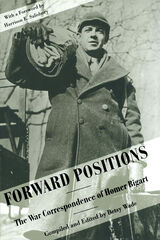 Forward Positions: The War Correspondence of Homer Bigart
Homer Bigart
University of Arkansas Press, 1992 Among journalists—and particularly war correspondents—Homer Bigart was both legend and example. In a career of four decades, first with the New York Herald Tribuneand then, through 1972, with The New York Times, Bigart distinguished himself as a superb writer and tireless digger for the realities that could be learned only in the field and not at headquarters. In 1943 Bigart sailed for England to cover the air war and was soon on mule-back in Sicily, and hanging on at Anzio. He then went to the Pacific, where his dispatches won him his first Pulitzer Prize for foreign correspondence. When hostilities erupted in Korea he was again on the front lines in the front lines in the Orient, and again recipient of a Pulitzer. By the time of the American involvement in Vietnam, he was an old-timer, a seasoned correspondent admired and celebrated for his wit but regarded with awe for his masterly stories, in which straightforward prose, informed by tenacious reporting, cut to the heart of the issues. Previously available only n crumbling library copies of the Tribune and the Times, or in microfilm repositories, his dispatches, with their rare insights into warefar and he minds of those who wage war, are now collected in Forward Positions: The War Correspondence of Home Bigart, edited by Betsy Wade and introduced by Harrison E. Salisbury, himself the winner of a Pulitzer Prize for journalism. Forward Positions does honor to a breed of journalist that had passed into history by the time of Bigart’s death. It includes one of the first accounts of the atomic annihilation of Hiroshima, a report on the war-crimes trial of Adolf Eichmann, a number of dispatches on “hot” battles of the Cold War, and a probing dispatch on Lieutenant William Calley’s testimony on the Mỹ Lai Massacre. With this representative selection of more than fifty of Bigart’s accounts of war on the ground, in the air, and in the courtroom, Wade provides a wealth of background material about his career, as well as glimpses of his impact on journalism. The book promises hours of captivating and informative reading for journalists, historians, veterans, and anyone who likes a good story tautly told.
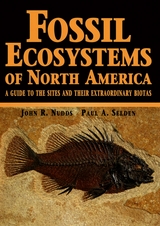 Fossil Ecosystems of North America: A Guide to the Sites and Their Extraordinary Biotas
John R. Nudds and Paul A. Selden
University of Chicago Press, 2008 The fossil record affords a fascinating glimpse at past environments and the kinds of plants and animals that inhabited them. Some sites, for instance, contain nearly complete preserved records of ancient life. Fourteen of these remarkable fossil depositories are found in North America, including Mistaken Point in Newfoundland, Mazon Creek in Illinois, and Rancho La Brea in Los Angeles.
Fossil Ecosystems of North America describes these and eleven other sites that range across the continent.
John R. Nudds and Paul A. Selden introduce each site and place the fossil findings in geologic and evolutionary context. They go on to describe the history of research at each site—the sedimentology, stratigraphy, biota, paleoecology—and offer comparisons to other localities of similar age or environment. Fossil Ecosystems of North America also includes an appendix of museums at which readers can see specimens from the sites and suggestions for visiting the sites in person. In some cases, new specimens can still be collected from these sites by professionals and amateurs alike.
Accessible and informative, this guide to Fossil-Lagerstätten will appeal to expert scientists and adventuresome lay paleontologists alike.
 Fossil Invertebrates
Paul D. Taylor and David N. Lewis
Harvard University Press, 2005 Fossil Invertebrates introduces readers to the biosphere as it was hundreds of millions of years ago, when seas teemed with animal forms both familiar and strange: ammonites and corals, mollusks and sponges, crinoids and trilobites. On land, terrestrial forms were beginning to make their mark, leaving behind traces such as burrows and track ways and other fossil evidence of the important transition to life on land. The plates in this book capture the incredibly detailed impressions and casts of ancient life, contrasting them with forms, such as the horseshoe crab and the chambered nautilus, that persist today virtually unchanged.
The shells and hard exoskeletons of invertebrates make them excellent candidates for fossilization, and the amateur fossil collectors are more likely to uncover an invertebrate fossil than any other kind. The fossilized remains of invertebrates dominate university collections and museum holdings worldwide and their study continues to yield important insights into the nature of evolutionary change and the impact of climate change on biodiversity, as great explosions of diversity were succeeded by mass extinctions. Paul D. Taylor and David N. Lewis, both of the Natural History Museum, London, have written a comprehensive and accessible resource, one that provides undergraduates and amateur fossil enthusiasts with a means to understand and interpret this rich fossil record.
Fossil Vertebrates of Alabama
John T. Thurmond and Douglas E. Jones
University of Alabama Press, 1981 The only comprehensive description of the fossil-vertebrate content of this important part of the world.
 Fossils: An Essential Guide
Paul D. Taylor
University of Chicago Press, 2025 With stunning images and an expert guide, explore the world of fossils to uncover the story of life on Earth, from the origins of new life to mass extinctions.
Ancient Earth seems like an alien world. But the fossil record can help reveal the mysteries of the organisms that have lived on our planet since its formation some 4,600 million years ago. In this engaging and beautifully illustrated book, world-renowned paleontologist Paul D. Taylor provides a comprehensive guide to all aspects of fossils to tell the story of life on Earth.
Taylor begins with the basics: how fossils form, how they mark geological time, and what they tell us about the origins of life and major evolutionary events like the Cambrian Explosion. He then shows the oldest fossils—single-celled bacteria in amazing, three-billion-year-old microbial rock structures—before introducing the first animals in the fossil record. From fishes to amphibians, reptiles, and mammals, we meet these animal fossils in an appropriate evolutionary parade. Next, we imagine plants long past, charting the evolution of this kingdom and learning how ephemeral botanical remains can become permanent records. While comprehensive in his coverage of fossil groups and ages, Taylor pays particular attention to specimens fossil hunters are most likely to encounter, like crinoids and the iconic ammonites. Throughout, he introduces us to fascinating fossil folklore—like the idea that ammonites are the petrified remains of coiled snakes—and helps us distinguish true fossils from fakes.
With stunning color images of many original specimens from the collections of London’s Natural History Museum, Fossils is an essential introduction, connecting life on Earth today to the ancient past.
Fossils in the Making: Vertebrate Taphonomy and Paleoecology
Anna K. Behrensmeyer and Andrew P. Hill
University of Chicago Press, 1988 One of the first interdisciplinary discussions of taphonomy (the study of how fossil assemblages are formed) and paleoecology (the reconstruction of ancient ecosystems), this volume helped establish these relatively new disciplines. It was originally published as part of the influential Prehistoric Archeology and Ecology series.
"Taphonomy is plainly here to stay, and this book makes a first class introduction to its range and appeal."—Anthony Smith, Interdisciplinary Science Reviews
 Fossils: The Key to the Past
Richard Fortey
Harvard University Press, 1991 Fossils, far from being mere dry bones, provide the key to understanding the stuff of history: past climates, evolution, and extinction. In this lively introduction, Richard Fortey offers an engaging and lucid explanation of how fossils are a product of our endlessly evolving habitat. The story begins with the Precambrian era, more than 600 million years ago. As Fortey traces the history of life from the dawn of the Precambrian to the present, he paints a vivid picture of the emergence of the plants and animals that we would recognize today. Unlike so many works on fossils that focus on dinosaurs, this book covers a broad range of animals and plants and does justice to the numerical superiority of invertebrate fossils.
The scope of the book is wide, including not only a history of paleontology but a review of those parts of general geology that are needed to appreciate the wealth of information contained in the fossil record: stratigraphy, measurements of paleotemperatures and radiometric ages, turbidites, reefs, sandstones, and so on. But the main emphasis of the book is on what paleontology is really about, how the paleontologist tries to figure out the ways in which fossil animals lived, and how geological processes such as plate tectonics have interacted with the history of life.
Fossils attempts to survey the contemporary paleontological scene in order to communicate the excitement of investigating the past. A primary goal of the book is to inspire and instruct the amateur fossil collector; hence, the specimens illustrated—many of which are presented in full color—are ones that are not too difficult for the amateur to collect. To aid the neophyte, the author has appended notes on the occurrence, significance, and preparation of each specimen. Of particular interest to the amateur are the discussions on how to collect fossils and on the economic and practical importance of fossils and their enclosing sediments. In striking a perfect balance between detail and generalization, Richard Fortey has written a book that will appeal to amateur and professional alike.
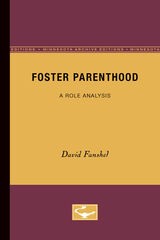 Foster Parenthood: A Role Analysis
David Fanshel
University of Minnesota Press, 1966
Foster Parenthood was first published in 1966.Although many thousands of children in the United States live in foster family homes supervised by public or private agencies, surprisingly little attention has been focused on the men and women who serve as foster parents. This book will help to fill the gaps in our understanding of foster parents and consequently it will, it is hoped, aid in efforts to improve the administration of foster home care.Professor Fanshel inquires into the motivations of a group of foster parents and identifies psychological and sociocultural factors related to role performance. The study is based on research in depth with 101 foster families on the roster of a social agency in Pittsburgh, Pennsylvania. Data were obtained through interviews with foster mothers and fathers, administration of a parental attitude questionnaire, and ratings by caseworkers of the role performance of the foster parents.The findings of the study provide a prospectus for the guidance of child welfare workers concerned with foster home care. The book also points up the need for further research on the problems studied. In a foreword, Perry B. Hall of the National Study Service writes: “We hope that this study may stimulate other agencies to carry out similar studies and to publish their findings since all of the child welfare field with benefit therefrom.”The book will be useful not only to social workers in the field of child welfare but to social scientists who are students of role analysis and to child development specialists interested in the study of parent behavior.
Fosterage in Medieval Ireland: An Emotional History
Thomas O'Donnell
Amsterdam University Press, 2020 Fosterage was a central feature of medieval Irish society, yet the widespread practice of sending children to another family to be cared for until they reached adulthood is a surprisingly neglected topic. Where it has been discussed, fosterage is usually conceptualised and treated as a purely legal institution. This work seeks to outline the emotional impact of growing up within another family. What emerges is a complex picture of deeply felt emotional ties binding the foster family together. These emotions are unique to the social practice of fosterage, and we see the language and feelings originating within the foster family being used to describe other relationships such as those in the monastery or between humans and animals. This book argues that the more we understand how people felt in fosterage, the more we understand medieval Ireland.
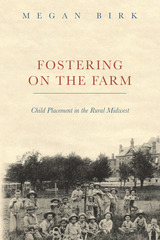 Fostering on the Farm: Child Placement in the Rural Midwest
Megan Birk
University of Illinois Press, 2019 From 1870 until after World War I, reformers led an effort to place children from orphanages, asylums, and children's homes with farming families. The farmers received free labor in return for providing room and board. Reformers, meanwhile, believed children learned lessons in family life, citizenry, and work habits that institutions simply could not provide.
Drawing on institution records, correspondence from children and placement families, and state reports, Megan Birk scrutinizes how the farm system developed--and how the children involved may have become some of America's last indentured laborers. Between 1850 and 1900, up to one-third of farm homes contained children from outside the family. Birk reveals how the nostalgia attached to misplaced perceptions about healthy, family-based labor masked the realities of abuse, overwork, and loveless upbringings endemic in the system. She also considers how rural people cared for their own children while being bombarded with dependents from elsewhere. Finally, Birk traces how the ills associated with rural placement eventually forced reformers to transition to a system of paid foster care, adoptions, and family preservation.
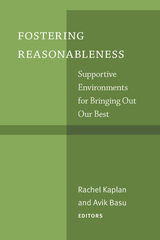 Fostering Reasonableness: Supportive Environments for Bringing Out Our Best
Rachel Kaplan and Avik Basu, editors
Michigan Publishing, 2015 We humans are difficult animals. We are the source of environmental degradation, the culprits of resource decline. We are reluctant to trust and easily angered. However, we are also the source of inspiration, compassion, and creative solutions. What brings out the reasonable side of our capacity? The Reasonable Person Model (RPM) offers a simple framework for considering essential ingredients in how people, at their best, deal with one another and the resources on which we all rely. RPM is a hopeful and engaging framework that helps us understand and address a wide diversity of issues. The 20 chapters of Fostering Reasonableness provide the conceptual foundations of the framework and applications examining contexts as diverse as a region, organization, the classroom, finding common ground in resource planning, education in the prison environment, greening in the inner city. Our collective hope in putting the book together is to encourage a way of seeing, a way of understanding and examining circumstances that might lead to more wholesome, adaptive, and effective means of addressing the big and little issues that depend on humanity’s reasonableness.
Foucault
Gilles Deleuze
University of Minnesota Press, 1988
 Foucault and Augustine: Reconsidering Power and Love
J. Joyce Schuld
University of Notre Dame Press, 2003 Using Augustine as a conversation partner, this important new book explores the value of Michel Foucault's controversial writings for theologians, ethicists, philosophers, and cultural theorists. J. Joyce Schuld demonstrates the promising possibilities as well as the difficulties and limits of applying Foucault's social criticisms within Christian contexts. She maintains that the best way to make Foucault's postmodern concerns and his unsettling descriptions, metaphors, and methods accessible to Christian readers is to examine his thought through a premodern lens.
By bringing Foucault and Augustine into constructive dialogue, Schuld reveals the surprising analytical usefulness of Augustine's writings for postmodern and poststructuralist studies. She pursues from a new and critically illuminating perspective the personal, cultural, and historical ramifications of Augustine's formative understanding of love and the complicated effects of original sin on all inter- and intrapersonal relations. Schuld argues that Foucault's dynamic and relational description of power helps us reconceptualize an ancient doctrine that has lost currency in the modern era and challenges us to rethink the vulnerabilities to which human loves endlessly expose us as individuals and engaged members of sociohistorical communities. This approach facilitates further theological examination of the intertwining personal and political implications of pride, the morally ambiguous aspirations for progress and perfecting knowledge, and the paradoxical power of the incarnation, the cross, and eschatological hope.
Schuld's is the first sustained analysis of the rich theological possibilities of employing Foucault's most influential concepts and methods, historical research, and contemporary cultural criticisms. Foucault and Augustine: Reconsidering Power and Love will appeal to those who already use Foucault constructively and to those who have either never read him or who are familiar with his writings but have never considered them valuable for Christians.
J. Joyce Schuld received her Ph.D. in religious studies from Yale University and currently resides in Ithaca, New York, where she is working on two books: Missions of Power: A Cultural Analysis of Indian-Christian Relations in the American Southwest , for the University of Notre Dame Press, and Michel Foucault: An Introduction for Theologians , for Cambridge University Press.
Reviews
"I hope Schuld's book is widely read by those interested in Augustine and Foucault, and by many others." --Theology Today, July 2004, Vol. 61 No. 2
"Foucault and Augustine is an important book, an original contribution at once to the literature on Augustine and on Foucault, and to current debates about postmodern Christian thought." --American Catholic Philosophical Quarterly
"Schuld's work shows Foucault to be not a threat to but rather a resource for religious thinking. å Both Augustine and Foucault lived in the wake of ideological collapse, and this volume shows their joint response to this crisis in some of their major themes and in their shared style of moving between the clear conceptual level and an immersion in historical detail and contingency. Schuld has Foucault's interest in socially and historically constructed spaces serve as a complement to the traditional ethical focus on the personal, and places that personal interaction in the more complex field of artificial institutions. I think Schuld's treatment of social evil is masterful and her connecting of original sin to Foucault's analysis of micropowers was inspired. I am delighted by this book and the conversation which it will help to further." --James Bernauer, S.J., Boston College
"Professor Schuld's study is an extended and detailed conversation between a very odd couple. She constantly reminds the reader of their differences, but this helps make the conversation persuasive and interesting. Both Foucault and Augustine weigh all human social and political arrangements in the balance and find them wanting. Yet their respective critiques of the rhetorics of progress and glory imply a 'subversive hope' that is tied to how we can make the best of the bad bargain we have been given rather than to any systematic or metaphysical structure. The conversation succeeds brilliantly in giving us a clear purchase on both figures; each illuminates the other. Readers drawn into the conversation will find themselves challenged to think more clearly about the social and political structures that are a perennial feature of human life, and they will be grateful to Professor Schuld." --Rowan A. Greer, Yale Divinity School
"Schuld sets up a fascinating and original conversation between Foucault and Augustine from the concerns of Christian cultural criticism and achieves a remarkable synthesis and cross-reading, which shows the theological value of Foucault for theology today." --Jeremy R. Carrette, University of Stirling, Scotland
"Schuld contributes richly to the study of religion in showing how one can speak responsibly and insightfully to the issues of our time with the resources of the Christian and post-Christian West." --Margaret R. Miles, Graduate Theological Union, Berkeley, California
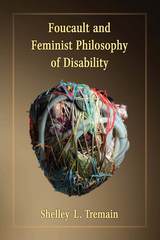 Foucault and Feminist Philosophy of Disability
Shelley L. Tremain
University of Michigan Press, 2017 Foucault and Feminist Philosophy of Disability is a distinctive contribution to growing discussions about how power operates within the academic field of philosophy. By combining the work of Michel Foucault, the insights of philosophy of disability and feminist philosophy, and data derived from empirical research, Shelley L. Tremain compellingly argues that the conception of disability that currently predominates in the discipline of philosophy, according to which disability is a natural disadvantage or personal misfortune, is inextricably intertwined with the underrepresentation of disabled philosophers in the profession of philosophy. Against the understanding of disability that prevails in subfields of philosophy such as bioethics, cognitive science, ethics, and political philosophy, Tremain elaborates a new conception of disability as a historically specific and culturally relative apparatus of power. Although the book zeros in on the demographics of and biases embedded in academic philosophy, it will be invaluable to everyone who is concerned about the social, economic, institutional, and political subordination of disabled people.
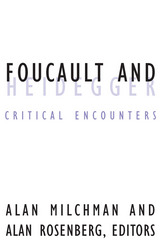 Foucault And Heidegger: Critical Encounters
Alan Milchman
University of Minnesota Press, 2003 An essential consideration of these two closely related and influential figures.
Michel Foucault and Martin Heidegger are two of the most important intellectual figures of the twentieth century, and yet there are significant, largely unexplored questions about the relationship between their projects. Foucault and Heidegger stages a crucial critical encounter between these two thinkers; in doing so, it clarifies not only the complexities of the Heidegger-Foucault relationship, but also their relevance to questions about truth and nihilism, acquiescence and resistance, and technology and agency that are central to debates in contemporary thought.
These essays examine topics ranging from Heidegger's and Foucault's intellectual forebears to their respective understanding of the Enlightenment, modernity, and technology, to their conceptions of power and the political.
Contributors: Hubert L. Dreyfus, Stuart Elden, Béatrice Han, Steven V. Hicks, Ladelle McWhorter, Jana Sawicki, Michael Schwartz, Charles E. Scott, William V. Spanos, Leslie Paul Thiele, Rudi Visker, Edith Wyschogrod.
Alan Milchman is lecturer in political science and Alan Rosenberg is associate professor of philosophy, both at Queens College, City University of New York.
Foucault and His Interlocutors
Edited by Arnold I. Davidson
University of Chicago Press, 1997 Containing the debate between Michel Foucault and Noam Chomsky on epistemology and politics, this book also features the most significant essays by the most important French thinkers who influenced and were influenced by Foucault. Foucault's teachers, colleagues, and collaborators take up his major claims, from his first to final works, and provide us with the authoritative context in which to understand Foucault's writings.
This volume also includes several important works by Foucault previously unpublished in English. The other contributors are Georges Canguilhem, Gilles Deleuze, Jacques Derrida, Pierre Hadot, Michel Serres, and Paul Veyne.
Here for the first time is the French Foucault.
This volume offers lucid and important texts that will appeal to students and professors at every level of study. It is essential reading for all scholars of twentieth-century philosophy and critical theory.
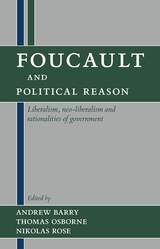 Foucault and Political Reason: Liberalism, Neo-Liberalism, and Rationalities of Government
Edited by Andrew Barry, Thomas Osborne, and Nikolas Rose
University of Chicago Press, 1996 Despite the enormous influence of Michel Foucault in gender studies, social theory, and cultural studies, his work has been relatively neglected in the study of politics. Although he never published a book on the state, in the late 1970s Foucault examined the technologies of power used to regulate society and the ingenious recasting of power and agency that he saw as both consequence and condition of their operation.
These twelve essays provide a critical introduction to Foucault's work on politics, exploring its relevance to past and current thinking about liberal and neo-liberal forms of government. Moving away from the great texts of liberal political philosophy, this book looks closely at the technical means with which the ideals of liberal political rationalities have been put into practice in such areas as schools, welfare, and the insurance industry.
This fresh approach to one of the seminal thinkers of the twentieth century is essential reading for anyone interested in social and cultural theory, sociology, and politics.
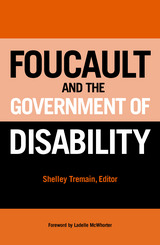 Foucault and the Government of Disability
Shelley Tremain, Editor
University of Michigan Press, 2005
Foucault and the Government of Disability is the first book-length investigation of the relevance and importance of the ideas of Michel Foucault to the field of disability studies-and vice versa. Over the last thirty years, politicized conceptions of disability have precipitated significant social change, including the landmark Americans with Disabilities Act in 1990, the redesign of urban landscapes, the appearance of closed-captioning on televisions, and the growing recognition that disabled people constitute a marginalized and disenfranchised constituency.
The provocative essays in this volume respond to Foucault's call to question what is regarded as natural, inevitable, ethical, and liberating, while they challenge established understandings of Foucault's analyses and offer fresh approaches to his work. The book's roster of distinguished international contributors represents a broad range of disciplines and perspectives, making this a timely and necessary addition to the burgeoning field of disability studies.
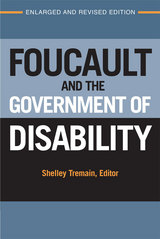 Foucault and the Government of Disability
Shelley Tremain, Editor
University of Michigan Press, 2005 Foucault and the Government of Disability considers the continued relevance of Foucault to disability studies, as well as the growing significance of disability studies to understandings of Foucault. A decade ago, this international collection provocatively responded to Foucault’s call to question what is regarded as natural, inevitable, ethical, and liberating. The book’s contributors draw on Foucault to scrutinize a range of widely endorsed practices and ideas surrounding disability, including rehabilitation, community care, impairment, normality and abnormality, inclusion, prevention, accommodation, and special education. In this revised and expanded edition, four new essays extend and elaborate the lines of inquiry by problematizing (to use Foucault’s term) the epistemological, political, and ethical character of the supercrip, the racialized war on autism, the performativity of intellectual disability, and the potent mixture of neoliberalism and biopolitics in the context of physician-assisted suicide. “[A]n important, prescient, and necessary contribution…a kind of litmus test for the efficacy of Foucault’s concepts in the study of disability, concepts that lead to a refusal of the biological essentialism implied in the disability/impairment binary.”
—Foucault Studies “Tremain has done an exceptional job at organizing and procuring important, rigorously argued, and entertaining essays…. This book should be a mandatory read for anyone interested in contemporary philosophical debates surrounding the experience of disability."
—Essays in Philosophy “A beautiful exploration of how Foucault’s analytics of power and genealogies of discursive knowledges can open up new avenues for thinking critically about phenomena that many of us take to be inevitable and thus new ways of resisting and possibly at times redirecting the forces that shape our lives. Every scholar, every person with an interest in Foucault or in political theory generally, needs to read this book.”
—Ladelle McWhorter, University of Richmond
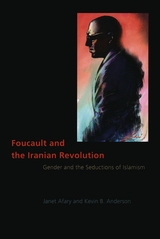 Foucault and the Iranian Revolution: Gender and the Seductions of Islamism
Janet Afary and Kevin B. Anderson
University of Chicago Press, 2005 In 1978, as the protests against the Shah of Iran reached their zenith, philosopher Michel Foucault was working as a special correspondent for Corriere della Sera and le Nouvel Observateur. During his little-known stint as a journalist, Foucault traveled to Iran, met with leaders like Ayatollah Khomeini, and wrote a series of articles on the revolution. Foucault and the Iranian Revolution is the first book-length analysis of these essays on Iran, the majority of which have never before appeared in English. Accompanying the analysis are annotated translations of the Iran writings in their entirety and the at times blistering responses from such contemporaneous critics as Middle East scholar Maxime Rodinson as well as comments on the revolution by feminist philosopher Simone de Beauvoir.
In this important and controversial account, Janet Afary and Kevin B. Anderson illuminate Foucault's support of the Islamist movement. They also show how Foucault's experiences in Iran contributed to a turning point in his thought, influencing his ideas on the Enlightenment, homosexuality, and his search for political spirituality. Foucault and the Iranian Revolution informs current discussion on the divisions that have reemerged among Western intellectuals over the response to radical Islamism after September 11. Foucault's provocative writings are thus essential for understanding the history and the future of the West's relationship with Iran and, more generally, to political Islam. In their examination of these journalistic pieces, Afary and Anderson offer a surprising glimpse into the mind of a celebrated thinker.
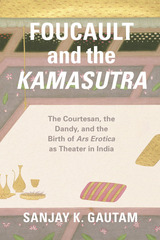 Foucault and the Kamasutra: The Courtesan, the Dandy, and the Birth of Ars Erotica as Theater in India
Sanjay K. Gautam
University of Chicago Press, 2016 The Kamasutra is best known in the West for its scandalous celebration of unbridled sensuality. Yet, there is much, much more to it; embedded in the text is a vision of the city founded on art and aesthetic pleasure. In Foucault and the "Kamasutra", Sanjay K. Gautam lays out the nature and origin of this iconic Indian text and engages in the first serious reading of its relationship with Foucault.
Gautam shows how closely intertwined the history of erotics in Indian culture is with the history of theater-aesthetics grounded in the discourse of love, and Foucault provides the framework for opening up an intellectual horizon of Indian thought. To do this, Gautam looks to the history of three inglorious characters in classical India: the courtesan and her two closest male companions—her patron, the dandy consort; and her teacher and advisor, the dandy guru. Foucault’s distinction between erotic arts and the science of sexuality drives Gautam’s exploration of the courtesan as a symbol of both sexual-erotic and aesthetic pleasure. In the end, by entwining together Foucault’s works on the history of sexuality in the West and the classical Indian texts on eros, Gautam transforms our understanding of both, even as he opens up new ways of investigating erotics, aesthetics, gender relations, and subjectivity.
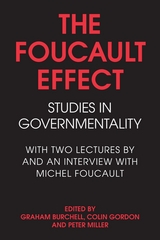 The Foucault Effect: Studies in Governmentality
Edited by Graham Burchell, Colin Gordon, and Peter Miller
University of Chicago Press, 1991 Based on Michel Foucault's 1978 and 1979 lectures at the Collège de France on governmental rationalities and his 1977 interview regarding his work on imprisonment, this volume is the long-awaited sequel to Power/Knowledge. In these lectures, Foucault examines the art or activity of government both in its present form and within a historical perspective as well as the different ways governmentality has been made thinkable and practicable.
Foucault's thoughts on political discourse and governmentality are supplemented by the essays of internationally renowned scholars. United by the common influence of Foucault's approach, they explore the many modern manifestations of government: the reason of state, police, liberalism, security, social economy, insurance, solidarity, welfare, risk management, and more. The central theme is that the object and the activity of government are not instinctive and natural things, but things that have been invented and learned.
The Foucault Effect analyzes the thought behind practices of government and argues that criticism represents a true force for change in attitudes and actions, and that extending the limits of some practices allows the invention of others. This unique and extraordinarily useful collection of articles and primary materials will open the way for a whole new set of discussions of the work of Michel Foucault as well as the status of liberalism, social policy, and insurance.
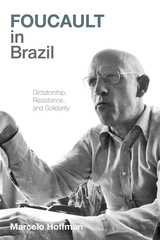 Foucault in Brazil: Dictatorship, Resistance, and Solidarity
Marcelo Hoffman
University of Pittsburgh Press, 2024 Philosopher Michel Foucault’s cultural criticism crosses disciplines and is well known as an influence on modern conceptions of knowledge and power. Less well known are the five trips he took to Brazil between 1965 and 1976. Although a coup in 1964 had installed a military dictatorship, Foucault kept his opinion on the Brazilian government largely to himself until October 23, 1975. On that date, he delivered a manifesto at a student assembly in São Paulo expressing his solidarity with students and professors protesting a wave of arrests and torture. This manifesto caught the government’s attention and became the focal point of the dictatorship’s surveillance of Foucault. Foucault in Brazil explores the production of the public antagonism between the philosopher and the dictatorship through a meticulous consideration of each of his visits to Brazil. Marcelo Hoffman connects history, philosophy, and political theory to open new ways of thinking about Foucault as a person and thinker and about Brazil and authoritarianism.
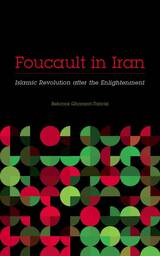 Foucault in Iran: Islamic Revolution after the Enlightenment
Behrooz Ghamari-Tabrizi
University of Minnesota Press, 2016 Were the thirteen essays Michel Foucault wrote in 1978–1979 endorsing the Iranian Revolution an aberration of his earlier work or an inevitable pitfall of his stance on Enlightenment rationality, as critics have long alleged? Behrooz Ghamari-Tabrizi argues that the critics are wrong. He declares that Foucault recognized that Iranians were at a threshold and were considering if it were possible to think of dignity, justice, and liberty outside the cognitive maps and principles of the European Enlightenment. Foucault in Iran centers not only on the significance of the great thinker’s writings on the revolution but also on the profound mark the event left on his later lectures on ethics, spirituality, and fearless speech. Contemporary events since 9/11, the War on Terror, and the Arab Uprisings have made Foucault’s essays on the Iranian Revolution more relevant than ever. Ghamari-Tabrizi illustrates how Foucault saw in the revolution an instance of his antiteleological philosophy: here was an event that did not fit into the normative progressive discourses of history. What attracted him to the Iranian Revolution was precisely its ambiguity. Theoretically sophisticated and empirically rich, this interdisciplinary work will spark a lively debate in its insistence that what informed Foucault’s writing was not an effort to understand Islamism but, rather, his conviction that Enlightenment rationality has not closed the gate of unknown possibilities for human societies.
Foucault, Politics, and Violence
Johnanna Oksala
Northwestern University Press, 2012 In her book, Oksala shows that the arguments for the ineliminability of violence from the political are often based on excessively broad, ontological conceptions of violence distinct from its concrete and physical meaning and, on the other hand, on a restrictively narrow and empirical understanding of politics as the realm of conventional political institutions.
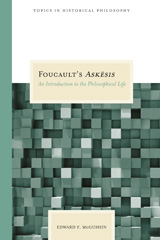 Foucault's Askesis: An Introduction to the Philosophical Life
Edward McGushin
Northwestern University Press, 2007 In his renowned courses at the Collège de France from 1982 to 1984, Michel Foucault devoted his lectures to meticulous readings and interpretations of the works of Plato, Epictetus, Seneca, and Marcus Aurelius, among others. In this his aim was not, Edward F. McGushin contends, to develop a new knowledge of the history of philosophy; rather, it was to let himself be transformed by the very activity of thinking. Thus, this work shows us Foucault in the last phase of his life in the act of becoming a philosopher. Here we see how his encounter with ancient philosophy allowed him to experience the practice of philosophy as, to paraphrase Nietzsche, a way of becoming who one is: the work of self-formation that the Greeks called askēsis.
Through a detailed study of Foucault's last courses, McGushin demonstrates that this new way of practicing philosophical askēsis evokes Foucault's ethical resistance to modern relations of power and knowledge. In order to understand Foucault's later project, then, it is necessary to see it within the context of his earlier work. If his earlier projects represented an attempt to bring to light the relations of power and knowledge that narrowed and limited freedom, then this last project represents his effort to take back that freedom by redefining it in terms of care of the self. Foucault always stressed that modern power functions by producing individual subjects. This book shows how his excavation of ancient philosophical practices gave him the tools to counter this function-with a practice of self-formation, an askēsis.
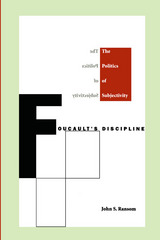 Foucault's Discipline: The Politics of Subjectivity
John S. Ransom
Duke University Press, 1997 In Foucault’s Discipline, John S. Ransom extracts a distinctive vision of the political world—and oppositional possibilities within it—from the welter of disparate topics and projects Michel Foucault pursued over his lifetime. Uniquely, Ransom presents Foucault as a political theorist in the tradition of Weber and Nietzsche, and specifically examines Foucault’s work in relation to the political tradition of liberalism and the Frankfurt School. By concentrating primarily on Discipline and Punish and the later Foucauldian texts, Ransom provides a fresh interpretation of this controversial philosopher’s perspectives on concepts such as freedom, right, truth, and power.
Foucault’s Discipline demonstrates how Foucault’s valorization of descriptive critique over prescriptive plans of action can be applied to the decisively altered political landscape of the end of this millennium. By reconstructing the philosopher’s arguments concerning the significance of disciplinary institutions, biopower, subjectivity, and forms of resistance in modern society, Ransom shows how Foucault has provided a different way of looking at and responding to contemporary models of government—in short, a new depiction of the political world.
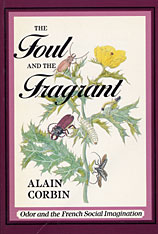 The Foul and the Fragrant: Odor and the French Social Imagination
Alain Corbin
Harvard University Press, 1986 In a book whose insight and originality have already had a dazzling impact in France, Alain Corbin has put the sense of smell on the historical map. He conjures up the dominion that the combined forces of smells - from the seductress's civet to the ubiquitous excremental odors of city cesspools - exercised over the lives (and deaths) of the French in the eighteenth and nineteenth centuries. Table of Contents: Introduction Part One: The Perceptual Revolution or the Sense of Smell on Trial 1. Air and the Threat of the Putrid
2. The Extremes of Olfactory Vigilance
3. Social Emanations
4. Redefining the Intolerable
5. The New Calculus of Olfactory Pleasure Part Two: Purifying Public Space 6. The Tactics of Deodorization
7. Odors and the Physiology of the Social Order
8. Policy and Pollution Part Three: Smells, Symbols, and Social Representations 9. The Stench of the Poor
10. Domestic Atmospheres
11. The Perfumes of Intimacy
12. The Intoxicating Flask
13. "Laughter in a Bead of Sweat"
14. The Odors of Paris Conclusion
Notes
Index
Reviews of this book: [This book] is not only serious, but interesting and important; one of those studies that profoundly alters our understanding of both social life and history. --Joan W. Scott, New York Times Book Review Reviews of this book: At once encyclopedic and impressionistic, The Foul and the Fragrant is...a masterful exposition of odors and the perception of odors from 1750 to the "Pasteurian revolution" of the late nineteenth century...It is an important and, at times, fascinating voyage...Exploring with imagination and audacity the changing role of smell in the anxieties and antagonisms of the modern world, Corbin reminds us that social history, too long sanitized and too often abstract, must make room for the senses. --Michael Burns, Los Angeles Times Book Review Reviews of this book: The story has never been told more brilliantly, nor with such verve and perceptiveness. That alone would make Corbin's book worth reading, but one may read it as well for a deeper understanding of the roots of modern urban anxieties about the unwholesome...Corbin's book is a tour de force. --Simon Schama, New Republic
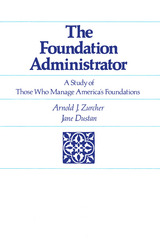 The Foundation Administrator: A Study of Those Who Manage America's Foundations
Arnold John Zurcher
Russell Sage Foundation, 1972 This book offers a systematic study of those individuals who derive their livelihood and professional satisfactions from foundation employment above a clerical level. Replies to questionnaires addressed to foundations and to foundation staff, supplemented by other research, enabled the authors to secure a wealth of data, not previously available, concerning such staff personnel. The data relates to their origin, education or training, professional or occupational background, personal qualities, recruitment for foundation service, job specialization in foundations and in-service and on-the-job training, salary levels, retirement, fringe benefits and perquisites of various kinds. These data are systematically analyzed according to the employing foundation's asset size, program, founding auspices, staff size, geographical location, and other variables. The comprehensiveness of the data also makes possible a census of full-time and part-time staff employed by all foundations and better reveals the rather distorted pattern of the distribution of that staff among the employing foundations. A feature of the study is a chapter that tabulates and analyzes the comments on foundation employment of some 420 foundation executives—on their satisfactions, dissatisfactions, and frustrations and on how foundation employment might be made more attractive. The pros and cons of the related issue of increased professionalization of foundation service is considered in the light of these comments and from the standpoint, also, of the current philanthropic policies of different kinds of foundations. The probable long-term effect on foundation service of certain provisions of the Tax Reform Act of 1969 is also examined.
 The Foundation for Yoga Practitioners: The Buddhist Yogācārabhūmi Treatise and Its Adaptation in India, East Asia, and Tibet
Ulrich Timme Kragh
Harvard University Press The Yogacarabhumi, a fourth-century Sanskrit treatise, is the largest Indian text on Buddhist meditation. Its enormous scope exhaustively encompasses all yoga instructions on the disciplines and contemplative exercises of sravaka, pratyekabuddha, and bodhisattva practitioners. The thoroughness of the text meant that the Yogacarabhumi became the fundamental source for later Buddhist writings on meditation across Asia. The present edited volume, conceived by Geumgang University in South Korea, brings together the scholarship of thirty-four leading Buddhist specialists on the Yogacarabhumi from across the globe. The essays elaborate the background and environment in which the Yogacarabhumi was composed and redacted, provide a detailed summary of the work, raise fundamental and critical issues about the text, and reveal its reception history in India, China, and Tibet. The volume also provides a thorough survey of contemporary Western and Asian scholarship on the Yogacarabhumi in particular and the Yogacara tradition more broadly. The Foundation for Yoga Practitioners aims not only to tie together the massive research on this text that has been carried out in Japan, Korea, China, Taiwan, Europe, and the United States up to now, but also to make this scholarship accessible to all students and scholars of Buddhism.
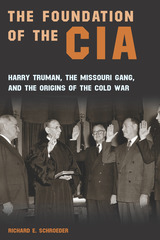 The Foundation of the CIA: Harry Truman, The Missouri Gang, and the Origins of the Cold War
Richard E. Schroeder
University of Missouri Press, 2017 This highly accessible book provides new material and a fresh perspective on American National Intelligence practice, focusing on the first fifty years of the twentieth century, when the United States took on the responsibilities of a global superpower during the first years of the Cold War. Late to the art of intelligence, the United States during World War II created a new model of combining intelligence collection and analytic functions into a single organization—the OSS. At the end of the war, President Harry Truman and a small group of advisors developed a new, centralized agency directly subordinate to and responsible to the President, despite entrenched institutional resistance. Instrumental to the creation of the CIA was a group known colloquially as the “Missouri Gang,” which included not only President Truman but equally determined fellow Missourians Clark Clifford, Sidney Souers, and Roscoe Hillenkoetter.
The Foundation Pit
Andrey Platonov
Northwestern University Press, 1994 Once known only to a small circle of admirers in Russia and the West, Andrey Platonov (1899-1951) has emerged to assume his rightful place as one of the major Russian writers of the twentieth century. Set during a small Russian town during the forcible collectivization of agriculture, The Foundation Pit portrays a group of workmen and local bureaucrats engaged in digging the foundation pit for a grand building where all the town's will live happily and "in silence."
Foundation Stone
Lella Warren
University of Alabama Press, 1986 Using the history of Alabama and the stories of her pioneering ancestors, Lella Warren created the Whetstone clan who settled Alabama in the 1820s, helped lead it into the prosperity of the 1850s, and fought for it in the War Between the States. The historical background of Foundation Stone is authentic, but, more, it is a compelling story about believable characters. The story of these people—three generations of Whetstones—captures the American pioneering spirit. As an unidentified reviewer described the novel, “Lella Warren’s ‘Foundation Stone’ is the long, well-told chronicle of a family that loved and hoped and struggled in a difficult world, unaware that they symbolized an era and a way of life.” Foundation Stone was published in September 1940 and was on the Publishers Weekly bestseller list September 1940-February 1941, along with Hemingway’s For Whom the Bell Tolls and Wolfe’s You Can’t Go Home Again.
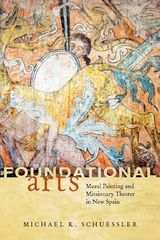 Foundational Arts: Mural Painting and Missionary Theater in New Spain
Michael K. Schuessler
University of Arizona Press, 2013 The languages of two hemispheres collided when Spain conquered Mexico, and as a result, a dynamic expression of visual and dramatic arts emerged. Mural painting and missionary theater quickly became the media to explain and comprehend the encounter of indigenous peoples with Christ and the crucifixion, as well as with heaven and hell.
In Foundational Arts Michael K. Schuessler asserts that the literature of New Spain begins with missionary theater and its intimate relationship to mural painting. In particular, he examines the relationships between texts and visual images that emerged in Mexico at two Augustinian monasteries in Hidalgo, Mexico, during the century following the Spanish Conquest. The forced combination of the ideographical tradition of Nahuatl with Latin-based language alphabets led to a fascinating array of new cultural expressions.
Missionary theater was organized by ingenious friars with the intent to convert and catechize indigenous populations. Often performed in Nahuatl or other local languages, the actors combined Latin-based language texts with visual contexts that corresponded to indigenous ways of knowing: murals, architectural ornamentation, statuary, altars, and other modes of visual representation. By concentrating on the interrelationship between mural painting and missionary theater, Foundational Arts explores the artistic and ideological origins of Mexican plastic arts and literature.
Foundations and Government: State and Federal Law Supervision
Marion R. Fremont-Smith
Russell Sage Foundation, 1965 Concentrates on the historical, statutory, judicial, and administrative aspects of philanthropic foundations. It begins with a general survey of the rise of foundations, particularly as a legal concept, and examines existing provisions for state registration and supervision, with special atention to the role of the attorney general. There are field reports on ten states with programs aimed at following charitable activities closely. The concluding chapter provides appraisals and recommendations, and appendices include state legal requirements for charitable trusts and corporations, selected state acts, rules, reporting forms, and a list of cases.
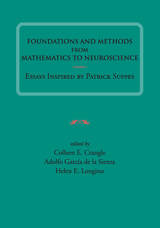 Foundations and Methods from Mathematics to Neuroscience: Essays Inspired by Patrick Suppes
Edited by Colleen E Crangle, Adolfo García de la Sienra, and Helen E. Longino
CSLI, 2014 During his long and continuing scholarly career, Patrick Suppes has contributed significantly both to the sciences and to scientific philosophies. In this volume, an international group of Suppes’s colleagues, collaborators, and students seeks to build upon Suppes’s insights. Each of their essays is accompanied by a response from Suppes himself, which together create a uniquely engaging dialogue. Suppes and his peers explore a diverse array of topics including the relationship between science and philosophy; the philosophy of physics; problems in the foundations of mathematics; theory of measurement, decision theory, and probability; the foundations of economics and political theory; psychology, language, and the philosophy of language; Suppes’s most recent research in neurobiology; and the alignment (or misalignment) of method and policy.
Foundations for Model-based Systems Engineering: From patterns to models
Jon Holt
The Institution of Engineering and Technology, 2016 The practice of Model-based Systems Engineering is becoming more widely adopted in industry, academia and commerce and, as the use of modelling matures in the real world, so the need for more guidance on how to model effectively and efficiently becomes more prominent. This book describes a number of systems-level 'patterns' (pre-defined, reusable sets of views) that may be applied using the systems modelling language SysML for the development of any number of different applications and as the foundations for a system model.
Foundations for Sociorhetorical Exploration: A Rhetoric of Religious Antiquity Reader
Vernon K. Robbins
SBL Press, 2016 Engaging resources for understanding the importance of bodies and spaces in producing and interpreting persuasive language
This volume collects essays that represent intellectual milestones that are informing sociorhetorical interpretation during the twenty-first century. The essays are arranged into five parts: (1) Topos; (2) Cultural Geography and Critical Spatiality; (3) Rhetorolects and Conceptual Blending; (4) Rhetography; and (5) Rhetorical Force.
Features:
- Tools for integrating multiple approaches to biblical interpretation
- Resources that emphasize the importance of language that prompts mental pictures in effective rhetoric
- Essays from classicists, rhetoricians, and biblical scholars
Foundations for Youth Justice: Positive Approaches to Practice
Anne Robinson
Bristol University Press, 2014 How can youth justice refocus its attention on the rights and perspectives of young people in transition? Foundations for Youth Justice outlines youth justice practices in their current state of flux in the United Kingdom as New Labour policies receive direction under the vastly different Coalition Government. Anne Robinson explores opportunities for a fresh orientation that places young people at the center. She outlines the risks and problems that modern society creates for them and asks when, and how, society should respond to youth behaviors that cause harm to others. The result is a bold—and realistic—remodelling of youth justice practices.
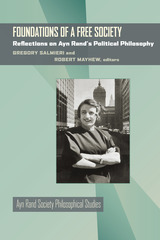 Foundations of a Free Society: Reflections on Ayn Rand's Political Philosophy
Gregory Salmieri and Robert Mayhew
University of Pittsburgh Press, 2019 Foundations of a Free Societybrings together some of the most knowledgeable Ayn Rand scholars and proponents of her philosophy, as well as notable critics, putting them in conversation with other intellectuals who also see themselves as defenders of capitalism and individual liberty. United by the view that there is something importantly right—though perhaps also much wrong—in Rand’s political philosophy, contributors reflect on her views with the hope of furthering our understandings of what sort of society is best and why. The volume provides a robust elaboration and defense of the foundation of Rand’s political philosophy in the principle that force paralyzes and negates the functioning of reason; it offers an in-depth scholarly discussion of Rand’s view on the nature of individual rights and the role of government in defending them; it deals extensively with the similarities and differences between Rand’s thought and the libertarian tradition (to which she is often assimilated) and objections to her positions arising from this tradition; it explores Rand’s relation to the classical liberal tradition, specifically with regard to her defense of freedom of the intellect; and it discusses her views on the free market, with special attention to the relation between these views and those of the Austrian school of economics.
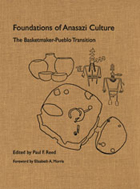 Foundations of Anasazi Culture: The Basketmaker Pueblo Transition
Paul F Reed
University of Utah Press, 2002 This major synthesis of work explores new evidence gathered at Basketmaker III sites on the Colorado Plateau in search of further understanding of Anasazi development.
Since the 1960s, large-scale cultural resource management projects have revealed the former presence of Anasazi within the entire northern Southwest. These discoveries have resulted in a greatly expanded view of the BMIII period (A.D. 550-750) which immediately proceeds the Pueblo phase. Particularly noteworthy are finding of Basketmaker remains under those of later periods and in sites with open settings, as opposed to the more classic Basketmaker cave and rock shelter sites.
Foundations of Anasazi Culture explores this new evidence in search of further understanding of Anasazi development. Several chapters address the BMII-BMIII transition, including the initial production and use of pottery, greater reliance on agriculture, and the construction of increasingly elaborate structures. Other chapters move beyond the transitional period to discuss key elements of the Anasazi lifestyle, including the use of gray-,red-, and white-ware ceramics, pit structures, storage cists, surface rooms, full dependence on agriculture, and varying degrees of social specialization and differentiation. A number of contributions address one or more of these issues as they occur at specific sites. Other contributors consider the material culture of the period in terms of common elements in architecture, ceramics, lithic technology, and decorative media.
This work on BMIII sites on the Colorado Plateau will be useful to anyone with an interest in the earliest days of Anasazi civilization.
 Foundations of Animal Behavior: Classic Papers with Commentaries
Edited by Lynne D. Houck and Lee C. Drickamer
University of Chicago Press, 1996 Beginning with Darwin's work in the 1870s, Foundations of Animal Behavior selects the most important works from the discipline's first hundred years—forty-four classic papers—and presents them in facsimile, tracing the development of the field. These papers are classics because they either founded a line of investigation, established a basic method, or provided a new approach to an important research question.
The papers are divided into six sections, each introduced by prominent researchers. Sections one and two cover the origins and history of the field and the emergence of basic methods and approaches. They provide a background for sections three through six, which focus on development and learning; neural and hormonal mechanisms of behavior; sensory processes, orientation, and communication; and the evolution of behavior.
This outstanding collection will serve as the basis for undergraduate and graduate seminars and as a reference for researchers in animal behavior, whether they focus on ethology, behavioral ecology, comparative psychology, or anthropology.
Published in association with the Animal Behavior Society
Foundations of Applied Electromagnetics
Kamal Sarabandi
Michigan Publishing, 2022 Electromagnetics is credited with the greatest achievements of physics in the 19th century. Despite its long history of development, due to its fundamental nature and broad base, research in applied electromagnetics is still vital and going strong. In recent years electromagnetics played a major role in a wide range of disciplines, including wireless communication, remote sensing of the environment, military defense, and medical applications, among many others. Graduate students interested in such exciting fields of research need a strong foundation in field theory, which was part of the motivation for writing this book on classical electromagnetics but with an eye on its modern applications.
The Foundations of Arithmetic: A Logico-Mathematical Enquiry into the Concept of Number
Gottlob Frege
Northwestern University Press, 1980 The Foundations of Arithmetic is undoubtedly the best introduction to Frege's thought; it is here that Frege expounds the central notions of his philosophy, subjecting the views of his predecessors and contemporaries to devastating analysis. The book represents the first philosophically sound discussion of the concept of number in Western civilization. It profoundly influenced developments in the philosophy of mathematics and in general ontology.
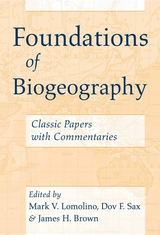 Foundations of Biogeography: Classic Papers with Commentaries
Edited by Mark V. Lomolino, Dov F. Sax, and James H. Brown
University of Chicago Press, 2004 Foundations of Biogeography provides facsimile reprints of seventy-two works that have proven fundamental to the development of the field. From classics by Georges-Louis LeClerc Compte de Buffon, Alexander von Humboldt, and Charles Darwin to equally seminal contributions by Ernst Mayr, Robert MacArthur, and E. O. Wilson, these papers and book excerpts not only reveal biogeography's historical roots but also trace its theoretical and empirical development. Selected and introduced by leading biogeographers, the articles cover a wide variety of taxonomic groups, habitat types, and geographic regions. Foundations of Biogeography will be an ideal introduction to the field for beginning students and an essential reference for established scholars of biogeography, ecology, and evolution.
List of Contributors
John C. Briggs, James H. Brown, Vicki A. Funk, Paul S. Giller, Nicholas J. Gotelli, Lawrence R. Heaney, Robert Hengeveld, Christopher J. Humphries, Mark V. Lomolino, Alan A. Myers, Brett R. Riddle, Dov F. Sax, Geerat J. Vermeij, Robert J. Whittaker
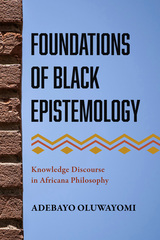 Foundations of Black Epistemology: Knowledge Discourse in Africana Philosophy
Adebayo Oluwayomi
Temple University Press, 2025 Foundations of Black Epistemology is Adebayo Oluwayomi’s bold endeavor to delineate Black epistemology as a new sub-disciplinary focus in contemporary Africana or Black philosophy. He engages in a rigorous historical study of Black intellectual history to show how seminal Black thinkers have long been interested in and engaged with questions concerning the phenomenon of human knowledge, and questions around human agency, including practical considerations regarding the social and political value of knowledge.
Foundations of Black Epistemology examines writings by Phillis Wheatley, Frederick Douglass, Ida B. Wells, W.E.B. DuBois, Frantz Fanon, Steve Bantu Biko, Huey P. Newton, and Kathleen Neal Cleaver. Each chapter addresses issues of self-knowledge, self-assertion, Black consciousness, or anticolonialism and its relation to personal and political epistemologies.
Oluwayomi offers innovative perspectives on the formulation, deduction, and interrogation of epistemological themes within Black Africana philosophy. By considering the important epistemological theories and arguments in Black philosophy particularly in the last 150 to 200 years, Foundations of Black Epistemology promises to generate new discussions around this necessary field of Black Africana philosophy.
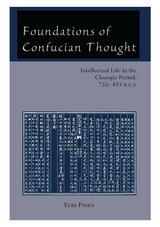 Foundations of Confucian Thought: Intellectual Life in the Chunqiu period, 722-453 B.C.E.
Yuri Pines
University of Hawaii Press, 2002 This ambitious work focuses on the world of Chinese thought during the two and a half centuries directly preceding and partly overlapping the time of Confucius. Ideas developed by Chunqiu statesmen and thinkers formed the intellectual milieu of Confucius and his disciples and contributed directly to the intellectual flowering of the Zhanguo (Warring States) era (453-221 B.C.E.), the formative period of the Chinese intellectual tradition. This study is the first attempt to systematically reconstruct major intellectual trends in pre-Confucian China. Foundations of Confucian Thought is based on an exploration of the Zuo zhuan, the largest pre-imperial historical text. Relying on meticulous textual and linguistic analysis, Yuri Pines argues that hundreds of the speeches of Chunqiu statesmen recorded in the Zuo zhuan were not invented by the compiler of the treatise but reproduced from earlier sources, thus making it an authentic reflection of the Chunqiu intellectual tradition. By tracing changes in ideas and concepts throughout the Chunqiu period, Pines reconstructs the dynamics of contemporary political and ethical discourse, distilling major intellectual impulses that Chunqiu thinkers bequeathed to their Zhanguo descendants.
 Foundations of Conservation Biology: A Guide to the Classic Literature
Edited by Jeffrey D. Brawn, Erica Fleishman, Curt Meine
University of Chicago Press For students, practitioners, and researchers, a comprehensive guide to conservation biology’s foundational literature.
This book summarizes over a century of multidisciplinary scientific literature that contributed to the development of conservation biology. It explores how different scientific, social, and cultural traditions have informed that literature, enabling a deeper comprehension of the natural world and conservation practices. The volume traces conservation biology’s scientific and cultural foundations and its emergence in the mid-1980s in response to the accelerating effects of human activity on biological diversity. As conservation moved beyond its early emphasis on sustaining yields of selected natural resources and responding to environmental degradation, it both reflected and required changes in its scope and foundations. Today, conservation biologists aim to understand the complex ecological and social causes of biodiversity loss and apply that integrated understanding to sustain life and ecological integrity at all levels.
Examining this evolving field’s foundations in philosophy and culture, population genetics, landscape ecology, management techniques, law, the social sciences, and climate change science, the contributors to this volume identify and provide historical and contextual interpretations of the key literature. Foundations of Conservation Biology shows how insights from the past have influenced contemporary studies, and how they may continue to shape future research and actions.
Foundations of Digital Signal Processing: Theory, algorithms and hardware design
Patrick Gaydecki
The Institution of Engineering and Technology, 2004 Foundations of Digital Signal Processing: Theory, algorithms and hardware design starts by introducing the mathematical foundations of DSP, assuming little prior knowledge of the subject from the reader, and moves on to discuss more complex topics such as Fourier, Laplace and digital filtering. It provides detailed information on off-line, real-time and DSP programming, and guides the reader through advanced topics such as DSP hardware design, FIR and IIR filter design and difference equation manipulation.
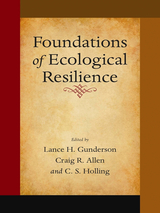 Foundations of Ecological Resilience
Edited by Lance Gunderson, Craig R. Allen, and C.S. Holling
Island Press, 2009 Ecological resilience provides a theoretical foundation for understanding how complex systems adapt to and recover from localized disturbances like hurricanes, fires, pest outbreaks, and floods, as well as large-scale perturbations such as climate change. Ecologists have developed resilience theory over the past three decades in an effort to explain surprising and nonlinear dynamics of complex adaptive systems. Resilience theory is especially important to environmental scientists for its role in underpinning
adaptive management approaches to ecosystem and resource management. Foundations of Ecological Resilience is a collection of the most important articles on the subject of ecological resilience—those writings that have defined and developed basic concepts in the field and help explain its importance and meaning for scientists and researchers. The book’s three sections cover articles that have shaped or defined the concepts and theories of resilience, including key papers that broke new conceptual ground and contributed novel ideas to the field; examples that demonstrate ecological resilience in a range of ecosystems; and articles that present practical methods for understanding and managing nonlinear ecosystem dynamics. Foundations of Ecological Resilience is an important contribution to our collective understanding of resilience and an invaluable resource for students and scholars in ecology, wildlife ecology, conservation biology, sustainability, environmental science, public policy, and related fields.
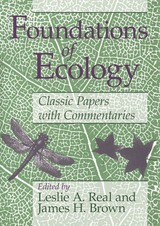 Foundations of Ecology: Classic Papers with Commentaries
Edited by Leslie A. Real and James H. Brown
University of Chicago Press, 1991 Assembled here for the first time in one volume are forty classic papers that have laid the foundations of modern ecology. Whether by posing new problems, demonstrating important effects, or stimulating new research, these papers have made substantial contributions to an understanding of ecological processes, and they continue to influence the field today.
The papers span nearly nine decades of ecological research, from 1887 on, and are organized in six sections: foundational papers, theoretical advances, synthetic statements, methodological developments, field studies, and ecological experiments. Selections range from Connell's elegant account of experiments with barnacles to Watt's encyclopedic natural history, from a visionary exposition by Grinnell of the concept of niche to a seminal essay by Hutchinson on diversity.
Six original essays by contemporary ecologists and a historian of ecology place the selections in context and discuss their continued relevance to current research. This combination of classic papers and fresh commentaries makes Foundations of Ecology both a convenient reference to papers often cited today and an essential guide to the intellectual and conceptual roots of the field.
Published with the Ecological Society of America.
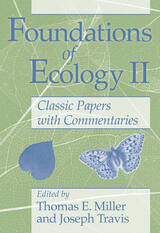 Foundations of Ecology II: Classic Papers with Commentaries
Edited by Thomas E. Miller and Joseph Travis
University of Chicago Press, 2022 The classic papers that laid the foundations of modern ecology alongside commentaries by noted ecologists.
The period of 1970 to 1995 was a time of tremendous change in all areas of ecology—from an increased rigor for experimental design and analysis to the reevaluation of paradigms, new models for understanding, and theoretical advances. Edited by ecologists Thomas E. Miller and Joseph Travis, Foundations of Ecology II includes facsimiles of forty-six papers from this period alongside expert commentaries that discuss a total of fifty-three key studies, addressing topics of diversity, predation, complexity, competition, coexistence, extinction, productivity, resources, distribution, abundance, and conservation. The result is more than a catalog of historic firsts; this book offers diverse perspectives on the foundational papers that led to today’s ecological work. Like this book’s 1991 predecessor, Foundations of Ecology edited by Leslie A. Real and James H. Brown, Foundations of Ecology II promises to be the essential primer for graduate students and practicing ecologists for decades to come.
Foundations of Economic Analysis: Enlarged Edition
Paul Samuelson
Harvard University Press, 1983 Although his classic work has gone through many reprintings and translations, only now has Paul A. Samuelson added new material to his 1947 treatise. A new introduction portrays the genesis of the book and analyzes how its contributions fit into theoretical developments of the last thirty-five years. A new and lengthy mathematical appendix gives a survey of the following post-1947 breakthroughs in political economy, in relation to the methodology of Foundations: linear programming and comparative statics; nonlinear programming, dynamic and stochastic; modern duality theory; the testable content of the neoclassical money model; probabilistic decision making, with new slants on the dogma of Expected-Utility maximizing; and portfolio and liquidity preference analysis by general methods that transcend mean-variance approximations.
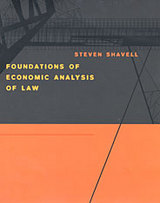 Foundations of Economic Analysis of Law
Steven Shavell
Harvard University Press, 2004 What effects do laws have? Do individuals drive more cautiously, clear ice from sidewalks more diligently, and commit fewer crimes because of the threat of legal sanctions? Do corporations pollute less, market safer products, and obey contracts to avoid suit? And given the effects of laws, which are socially best? Such questions about the influence and desirability of laws have been investigated by legal scholars and economists in a new, rigorous, and systematic manner since the 1970s. Their approach, which is called economic, is widely considered to be intellectually compelling and to have revolutionized thinking about the law.
In this book Steven Shavell provides an in-depth analysis and synthesis of the economic approach to the building blocks of our legal system, namely, property law, tort law, contract law, and criminal law. He also examines the litigation process as well as welfare economics and morality. Aimed at a broad audience, this book requires neither a legal background nor technical economics or mathematics to understand it. Because of its breadth, analytical clarity, and general accessibility, it is likely to serve as a definitive work in the economic analysis of law.
 Foundations of Environmental Physics: Understanding Energy Use and Human Impacts
Kyle Forinash
Island Press, 2010 Foundations of Environmental Physics is designed to focus students on the current energy and environmental problems facing society, and to give them the critical thinking and computational skills needed to sort out potential solutions. From its pedagogical approach, students learn that a simple calculation based on first principles can often reveal the plausibility (or implausibility) of a proposed solution or new technology. Throughout its chapters, the text asks students to apply key concepts to current data (which they are required to locate using the Internet and other sources) to get a clearer picture of the most pressing issues in environmental science. The text begins by exploring how changes in world population impact all aspects of the environment, particularly with respect to energy use. It then discusses what the first and second laws of thermodynamics tell us about renewable and nonrenewable energy; how current energy use is changing the global climate; and how alternative technologies can be evaluated through scientific risk assessment. In approaching real-world problems, students come to understand the physical principles that underlie scientific findings. This informative and engaging textbook offers what prospective scientists, managers, and policymakers need most: the knowledge to understand environmental threats and the skills to find solutions.
 The Foundations of Glen Canyon Dam: Infrastructures of Dispossession on the Colorado Plateau
Erika Marie Bsumek
University of Texas Press, 2023 2024 Best Indigenous Studies Award, The Mormon History Association
2024 Southwest Book of the Year, Pima County Public Library
A history of how the construction of the Glen Canyon Dam was built and sustained by social inequalities
The second highest concrete-arch dam in the United States, Glen Canyon Dam was built to control the flow of the Colorado River throughout the Western United States. Completed in 1966, the dam continues to serve as a water storage facility for residents, industries, and agricultural use across the American West. The dam also generates hydroelectric power for residents in Colorado, Wyoming, New Mexico, Utah, Nevada, Arizona, and Nebraska. More than a massive piece of physical infrastructure and an engineering feat, the dam exposes the cultural structures and complex regional power relations that relied on Indigenous knowledge and labor while simultaneously dispossessing the Indigenous communities of their land and resources across the Colorado Plateau. Erika Marie Bsumek reorients the story of the dam to reveal a pattern of Indigenous erasure by weaving together the stories of religious settlers and Indigenous peoples, engineers and biologists, and politicians and spiritual leaders. Infrastructures of dispossession teach us that we cannot tell the stories of religious colonization, scientific exploration, regional engineering, environmental transformation, or political deal-making as disconnected from Indigenous history. This book is a provocative and essential piece of modern history, particularly as water in the West becomes increasingly scarce and fights over access to it continue to unfold.
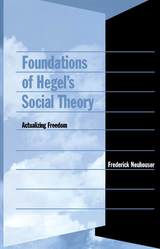 Foundations of Hegel’s Social Theory: Actualizing Freedom
Frederick Neuhouser
Harvard University Press, 2000 The author's purpose is to understand the philosophical foundations of Hegel's social theory by articulating the normative standards at work in his claim that the three central social institutions of the modern era--the nuclear family, civil society, and the constitutional state--are rational or good. Its central question is: what, for Hegel, makes a rational social order rational? In addressing this question the book aspires to be faithful to Hegel's texts and to articulate a compelling theory of rational social institutions; its aim is not only to interpret Hegel correctly but also to demonstrate the richness and power that his vision of the rational social order possesses.
Frederick Neuhouser's task is to understand the conceptions of freedom on which Hegel's theory rests and to show how they ground his arguments in defense of the modern social world. In doing so, the author focuses on Hegel's most important and least understood contribution to social philosophy, the idea of "social freedom."
Neuhouser's strategy for making sense of social freedom is to show its affinities with Rousseau's conception of the general will. The main idea that Hegel appropriates from Rousseau is that rational social institutions must satisfy two conditions: first, they must furnish the basic social preconditions of their members' freedom; and, second, all social members must be able subjectively to affirm their freedom-conditioning institutions as good and thus to regard the principles that govern their social participation as coming from their own wills.
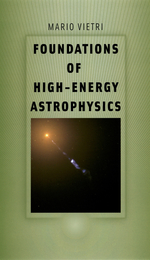 Foundations of High-Energy Astrophysics
Mario Vietri
University of Chicago Press, 2008 Written by one of today’s most highly respected astrophysicists, Foundations of High-Energy Astrophysics is an introduction to the mathematical and physical techniques used in the study of high-energy astrophysics. Here, Mario Vietri approaches the basics of high-energy astrophysics with an emphasis on underlying physical processes as opposed to a more mathematical approach. Alongside more traditional topics, Vietri presents new subjects increasingly considered crucial to understanding high-energy astrophysical sources, including the electrodynamics of cosmic sources, new developments in the theory of standard accretion disks, and the physics of coronae, thick disks, and accretion onto magnetized objects.
The most thorough and engaging survey of high-energy astrophysics available today, Foundations of High-Energy Astrophysics introduces the main physical processes relevant to the field in a rigorous yet accessible way, while paying careful attention to observational issues. Vietri’s book will quickly become a classic text for students and active researchers in astronomy and astrophysics. Those in adjoining fields will also find it a valuable addition to their personal libraries.
 Foundations of Information Ethics
John T. F. Burgess
American Library Association, 2019 As discussions about the roles played by information in economic, political, and social arenas continue to evolve, the need for an intellectual primer on information ethics that also functions as a solid working casebook for LIS students and professionals has never been more urgent. This text, written by a stellar group of ethics scholars and contributors from around the globe, expertly fills that need. Organized into twelve chapters, making it ideal for use by instructors, this volume from editors Burgess and Knox - thoroughly covers principles and concepts in information ethics, as well as the history of ethics in the information professions;
- examines human rights, information access, privacy, discourse, intellectual property, censorship, data and cybersecurity ethics, intercultural information ethics, and global digital citizenship and responsibility;
- synthesizes the philosophical underpinnings of these key subjects with abundant primary source material to provide historical context along with timely and relevant case studies;
- features contributions from John M. Budd, Paul T. Jaeger, Rachel Fischer, Margaret Zimmerman, Kathrine A. Henderson, Peter Darch, Michael Zimmer, and Masooda Bashir, among others; and
- offers a special concluding chapter by Amelia Gibson that explores emerging issues in information ethics, including discussions ranging from the ethics of social media and social movements to AI decision making.
This important survey will be a key text for LIS students and an essential reference work for practitioners
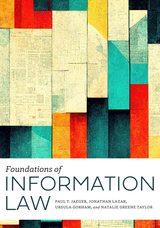 Foundations of Information Law
Paul T. Jaeger, Jonathan Lazar, Ursula Gorham, and Natalie Greene Taylor
American Library Association, 2023 Learning the basic concepts of information law and the many legal concepts that come into play in the field of librarianship can seem like an overwhelming endeavor. Drawing upon the authors’ unique backgrounds in both law and librarianship, this text is designed to empower readers to understand, rather than be intimidated by, the law. It melds essential context, salient examples of best practices, and stimulating discussions to illuminate numerous key legal and social issues directly related to the information professions. Helping readers better understand the role of law in their work, this primer - discusses information law as part of a continuum of interrelated issues rather than an assortment of discrete topics;
- examines information law in the context of different types of libraries;
- delves into the manifold legal issues raised when interacting with patrons and communities, from intellectual freedom topics like censorship and public activities in the library to the legal issues surrounding materials and information access;
- elucidates operational and management legal issues, including library security, interacting with law enforcement, advocacy, lobbying, funding, human resources, and liability;
- promotes literacy of the law, its structures, and its terminology as a professional skill;
- gives readers the tools to find and understand different sources of legal authority and demonstrates how to interpret them when they conflict; and
- explores information law as a national and cross-national issue.
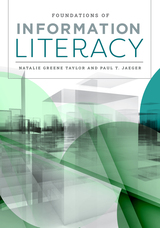 Foundations of Information Literacy
Natalie Greene Taylor
American Library Association, 2021 It’s not hyperbole to conclude that in today’s world, information literacy is essential for survival and success; and also that, if left unchecked, the social consequences of widespread misinformation and information illiteracy will only continue to grow more dire. Thus its study must be at the core of every education. But while many books have been written on information literacy, this text is the first to examine information literacy from a cross-national, cross-cultural, and cross-institutional perspective. From this book, readers will - learn about information literacy in a wide variety of contexts, including academic and school libraries, public libraries, special libraries, and archives, through research and literature that has previously been siloed in specialized publications;
- come to understand why information literacy is not just an issue of information and technology, but also a broader community and societal issue;
- get an historical overview of advertising, propaganda, disinformation, misinformation, and illiteracy;
- gain knowledge of both applied strategies for working with individuals and for addressing the issues in community contexts;
- find methods for combating urgent societal ills caused and exacerbated by misinformation; and
- get tools and techniques for advocacy, activism, and self-reflection throughout one’s career.
 Foundations of Information Policy
Paul T. Jaeger
American Library Association, 2019 Foreword by Alan S. Inouye; Afterword by Nancy Kranich The first of its kind, this important new text provides a much-needed introduction to the myriad information policy issues that impact information professionals, information institutions, and the patrons and communities served by those institutions. In this key textbook for LIS students and reference text for practitioners, noted scholars Jaeger and Taylor - draw from current, authoritative sources to familiarize readers with the history of information policy;
- discuss the broader societal issues shaped by policy, including access to infrastructure, digital literacy and inclusion, accessibility, and security;
- elucidate the specific laws, regulations, and policies that impact information, including net neutrality, filtering, privacy, openness, and much more;
- use case studies from a range of institutions to examine the issues, bolstered by discussion questions that encourage readers to delve more deeply;
- explore the intersections of information policy with human rights, civil rights, and professional ethics; and
- prepare readers to turn their growing understanding of information policy into action, through activism, advocacy, and education.
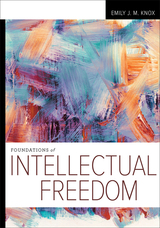 Foundations of Intellectual Freedom
Emily J. M. Knox
American Library Association, 2022 Enshrined in the mission statement of ALA, intellectual freedom is one of the core values of the information professions. The importance of ensuring information access to all, and the historical, social, and legal foundations of this commitment, are powerfully explored in this essential primer. Designed to function as both an introductory text for LIS students as well as a complementary resource for current professionals, this book provides a cohesive, holistic perspective on intellectual freedom. Extending beyond censorship to encompass such timely and urgent topics as hate speech and social justice, from this book readers will gain an understanding of - the historical and legal roots of intellectual freedom, with an in-depth examination of John Stuart Mill’s “On Liberty” and Article 19 of the U.N Declaration of Human Rights, and its central concepts and principles;
- the intersection of intellectual freedom, freedom of expression, and social justice;
- professional values, codes of ethics, ALA’s Library Bill of Rights, and Freedom to Read/View Statements;
- pro- and anti- censorship arguments and their use in impeding and facilitating access to information;
- book banning and internet filtering;
- privacy and its relationship to information services;
- U.S. case law and precedents;
- the basics of U.S. copyright law, including fair use, and how it differs from international copyright law; and
- emerging global issues and their impact on future intellectual freedom.
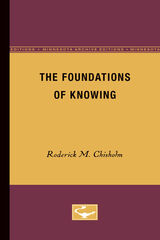 The Foundations of Knowing
Roderick M. Chisholm
University of Minnesota Press, 1982
The Foundations of Knowing was first published in 1982. Minnesota Archive Editions uses digital technology to make long-unavailable books once again accessible, and are published unaltered from the original University of Minnesota Press editions.
This collection of essays on the foundations of empirical knowledge brings together ten of Roderick M. Chisholm's most important papers in epistemology, three of them published for the first time, the others significantly revised and expanded for this edition. The essays in Part I constitute a thoroughgoing defense of foundationalism—the doctrine that our justification for believing always rests upon a self-evident basis. In Part II, Chisholm applies foundationalist principles to various areas within the theory of knowledge, and in part III he presents a history of twentieth-century American epistemology.
"Roderick M. Chisholm's work has been most influential both in the development of epistemology and in the widespread application of his analytic method. I am sure this publication featuring the unification of his views will be of great value to those working on the central issues of philosophy." Hector-Neri Castañeda, Indiana University
Roderick Chisholm is Andrew W. Mellon Professor of the Humanities in the department of philosophy at Brown University. Among his books are Perceiving: A Philosophical Study, Theory of Knowledge, Person and Object,and The First Person (Minnesota, 1981).
 Foundations of Library and Information Science
Richard E. Rubin
American Library Association, 2020 Richard E. Rubin’s book has served as the authoritative introductory text for generations of library and information science practitioners, with each new edition taking in its stride the myriad societal, technological, political, and economic changes affecting our users and institutions and transforming our discipline. Rubin teams up with his daughter, Rachel G. Rubin, a rising star in the library field in her own right, for the fifth edition. Spanning all types of libraries, from public to academic, school, and special, it illuminates the major facets of LIS for students as well as current professionals. Continuing its tradition of excellence, this text addresses - the history and mission of libraries from past to present, including the history of service to African Americans;
- critical contemporary social issues such as services to marginalized communities, tribal libraries, and immigrants;
- the rise of e-government and the crucial role of political advocacy;
- digital devices, social networking, digital publishing, e-books, virtual reality, and other technology;
- forces shaping the future of libraries, including Future Ready libraries, and sustainability as a core value of librarianship;
- the values and ethics of the profession, with new coverage of civic engagement, combatting fake news, the importance of social justice, and the role of critical librarianship;
- knowledge infrastructure and organization, including Resource Description and Access (RDA), linked data, and the Library Research Model;
- the significance of the digital divide and policy issues related to broadband access and net neutrality;
- intellectual freedom, legal issues, and copyright-related topics;
- contemporary issues in LIS education such as the ongoing tensions between information science and library science; and
- the changing character of collections and services including the role of digital libraries, preservation, and the digital humanities.
In its newest edition, Foundations of Library and Information Science remains the field’s essential resource.
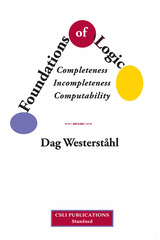 Foundations of Logic: Completeness, Incompleteness, Computability
Dag Westerståhl
CSLI, 2023 A comprehensive introduction to logic’s central concepts.
This book provides a concise but detailed account of modern logic's three cornerstones: the completeness of first-order logic, Gödel's Incompleteness Theorems, and Turing's analysis of computability. In addition to the central text, an appendix explains the required technical terminology and facts. The main ideas behind the three cornerstones are explained in a simple, easy-to-grasp manner, and it is possible to select among the chapters and sections so that the reader becomes familiar with these ideas, even if some technicalities are skipped or postponed. A wealth of exercises accompany a wide selection of materials, including the histories and philosophical implications of the three main premises, making it useful as a textbook for undergraduate or graduate courses focusing on any of the three main themes. The material is rigorous and detailed but keeps the main ideas in sight, and there are numerous excursions into more advanced material for curious readers to explore.
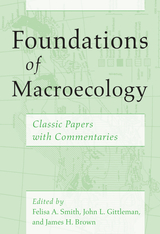 Foundations of Macroecology: Classic Papers with Commentaries
Edited by Felisa A. Smith, John L. Gittleman, and James H. Brown
University of Chicago Press, 2014 Macroecology is an approach to science that emphasizes the description and explanation of patterns and processes at large spatial and temporal scales. Some scientists liken it to seeing the forest through the trees, giving the proverbial phrase an ecological twist. The term itself was first introduced to the modern literature by James H. Brown and Brian A. Maurer in a 1989 paper, and it is Brown’s classic 1995 study, Macroecology, that is credited with inspiring the broad-scale subfield of ecology. But as with all subfields, many modern-day elements of macroecology are implicit in earlier works dating back decades, even centuries.
Foundations of Macroecology charts the evolutionary trajectory of these concepts—from the species-area relationship and the latitudinal gradient of species richness to the relationship between body size and metabolic rate—through forty-six landmark papers originally published between 1920 and 1998. Divided into two parts—“Macroecology before Macroecology” and “Dimensions of Macroecology”—the collection also takes the long view, with each paper accompanied by an original commentary from a contemporary expert in the field that places it in a broader context and explains its foundational role. Providing a solid, coherent assessment of the history, current state, and potential future of the field, Foundations of Macroecology will be an essential text for students and teachers of ecology alike.
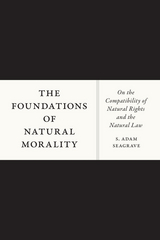 The Foundations of Natural Morality: On the Compatibility of Natural Rights and the Natural Law
S. Adam Seagrave
University of Chicago Press, 2014 Recent years have seen a renaissance of interest in the relationship between natural law and natural rights. During this time, the concept of natural rights has served as a conceptual lightning rod, either strengthening or severing the bond between traditional natural law and contemporary human rights. Does the concept of natural rights have the natural law as its foundation or are the two ideas, as Leo Strauss argued, profoundly incompatible?
With The Foundations of Natural Morality, S. Adam Seagrave addresses this controversy, offering an entirely new account of natural morality that compellingly unites the concepts of natural law and natural rights. Seagrave agrees with Strauss that the idea of natural rights is distinctly modern and does not derive from traditional natural law. Despite their historical distinctness, however, he argues that the two ideas are profoundly compatible and that the thought of John Locke and Thomas Aquinas provides the key to reconciling the two sides of this long-standing debate. In doing so, he lays out a coherent concept of natural morality that brings together thinkers from Plato and Aristotle to Hobbes and Locke, revealing the insights contained within these disparate accounts as well as their incompleteness when considered in isolation. Finally, he turns to an examination of contemporary issues, including health care, same-sex marriage, and the death penalty, showing how this new account of morality can open up a more fruitful debate.
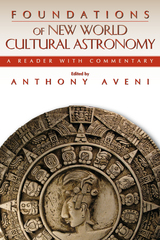 Foundations of New World Cultural Astronomy: A Reader with Commentary
Anthony Aveni
University Press of Colorado, 2008 Gazing into the black skies from the Anasazi observatory at Chimney Rock or the Castillo Pyramid in the Maya ruins of Chichén Itzá, a modern visitor might wonder what ancient stargazers looked for in the skies and what they saw. Once considered unresearchable, these questions now drive cultural astronomers who draw on written and unwritten records and a constellation of disciplines to reveal the wonders of ancient and contemporary astronomies. Cultural astronomy, first called archaeoastronomy, has evolved at ferocious speed since its genesis in the 1960s, with seminal essays and powerful rebuttals published in far-flung, specialized journals. Until now, only the most closely involved scholars could follow the intellectual fireworks. In Foundations of New World Cultural Astronomy, Anthony Aveni, one of cultural astronomy's founders and top scholars, offers a selection of the essays that built the field, from foundational works to contemporary scholarship.
Including four decades of research throughout the Americas by linguists, archaeologists, historians, ethnologists, astronomers, and engineers, this reader highlights the evolution of the field through thematic organization and point-counterpoint articles. Aveni - an award-winning author and former National Professor of the Year - serves up incisive commentary, background for the uninitiated, and suggested reading, questions, and essay topics. Students, readers, and scholars will relish this collection and its tour of a new field in which discoveries about ancient ways of looking at the skies cast light on our contemporary views.
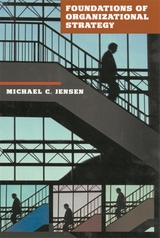 Foundations of Organizational Strategy
Michael C. Jensen
Harvard University Press, 1998 In this volume, Michael Jensen and his collaborators present the foundations of an integrated theory of organizations. The theory assumes that organizations are equilibrium systems that, like markets, can be influenced, but cannot be told what to do; that human beings are rational and self-interested for the most part; and that information is costly to produce and transfer among agents. The theory also treats business organizations as entities existing in a system of markets (including financial, product, labor, and materials markets) that must be considered in the formulation of organizational strategy.
Jensen argues that the cost of transferring information makes it necessary to decentralize some decision rights in organizations and in the economy. This decentralization in turn requires organizations to solve the control problem that results when self-interested persons do not behave as perfect agents.
Capitalist economies solve these control problems through the institution of alienable decision rights. But because organizations must suppress the alienability of decision rights, they must devise substitute mechanisms that perform its functions. Jensen argues that three critical systems, which he calls the organizational rules of the game, are necessary to substitute for alienability in organizations: (1) a system for allocating decision rights among agents in the firm, (2) a system for measuring and evaluating performance in the firm, and (3) a system for rewarding and punishing individuals for their performance. These concepts offer a major competitive advantage for organizations.
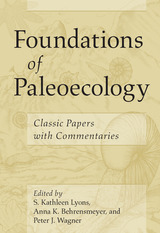 Foundations of Paleoecology: Classic Papers with Commentaries
Edited by S. Kathleen Lyons, Anna K. Behrensmeyer, and Peter J. Wagner
University of Chicago Press, 2019 Approximately 99% of all life that has ever existed is extinct. Fortunately, these long dead species have left traces of their lives and interactions with other species in the rock record that paleoecologists use to understand how species and ecosystems have changed over time. This record of past life allows us to study the dynamic nature of the Earth and gives context to current and future ecological challenges.
This book brings together forty-four classic papers published between 1924 and 1999 that trace the origins and development of paleoecology. The articles cross taxonomic groups, habitat types, geographic areas, and time and have made substantial contributions to our knowledge of the evolution of life. Encompassing the full breadth of paleoecology, the book is divided into six parts: community and ecosystem dynamics, community reconstruction, diversity dynamics, paleoenvironmental reconstruction, species interaction, and taphonomy. Each paper is also introduced by a contemporary expert who gives context and explains its importance to ongoing paleoecological research. A comprehensive introduction to the field, Foundations of Paleoecology will be an essential reference for new students and established paleoecologists alike.
 Foundations of Real Estate Development Financing: A Guide to Public-Private Partnerships
Arthur C. Nelson
Island Press, 2014 America’s landscape is undergoing a profound transformation as demand grows for a different kind of American Dream--smaller homes on smaller lots, multifamily options, and walkable neighborhoods. This trend presents a tremendous opportunity to reinvent our urban and suburban areas. But in a time of fiscal austerity, how do we finance redevelopment needs? In Foundations of Real Estate Development Finance: A Guide for Public-Private Partnerships, urban scholar Arthur C. Nelson argues that efficient redevelopment depends on the ability to leverage resources through partnerships. Public-private partnerships are increasingly important in reducing the complexity and lowering the risk of redevelopment projects. Although planners are an integral part of creating these partnerships, their training does generally not include real-estate financing, which presents challenges and imbalances in public-private partnership.
This is the first primer on financing urban redevelopment written for practicing planners and public administrators. In easy-to-understand language, it will inform readers of the natural cycle of urban development, explain how to overcome barriers to efficient redevelopment, what it takes for the private sector to justify its redevelopment investments, and the role of public and nonprofit sectors to leverage private sector redevelopment where the market does not generate sufficient rates of return.
This is a must read for practicing planners and planning students, economic development officials, public administrators, and others who need to understand how to leverage public and non-profit resources to leverage private funds for redevelopment.
Foundations of Real World Intelligence
Edited by Yoshinori Uesaka, Pentti Kanerva, and Hideki Asoh
CSLI, 2001 Real-world intelligence includes the ability to handle complex, uncertain, dynamic, multi-modal information in real time. In order to pursue the artificial realization of such "human" or "intelligent" information processing, a novel system of representing and interpreting knowledge must first be developed. This book collects the results of ten years of research at six laboratories, focusing on the theoretical and algorithmic foundations of the intelligence we find in the real world.
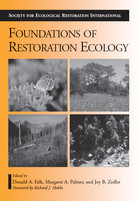 Foundations of Restoration Ecology
Edited by Donald A. Falk, Margaret A. Palmer, and Joy B. Zedler; Foreword by Richard J. Hobbs ; Society for Ecological Restoration International
Island Press, 2006 As the practical application of ecological restoration continues to grow, there is an increasing need to connect restoration practice to areas of underlying ecological theory. Foundations of Restoration Ecology is an important milestone in the field, bringing together leading ecologists to bridge the gap between theory and practice by translating elements of ecological theory and current research themes into a scientific framework for the field of restoration ecology.
Each chapter addresses a particular area of ecological theory, covering traditional levels of biological hierarchy (such as population genetics, demography, community ecology) as well as topics of central relevance to the challenges of restoration ecology (such as species interactions, fine-scale heterogeneity, successional trajectories, invasive species ecology, ecophysiology). Several chapters focus on research tools (research design, statistical analysis, modeling), or place restoration ecology research in a larger context (large-scale ecological phenomena, macroecology, climate change and paleoecology, evolutionary ecology).
The book makes a compelling case that a stronger connection between ecological theory and the science of restoration ecology will be mutually beneficial for both fields: restoration ecology benefits from a stronger grounding in basic theory, while ecological theory benefits from the unique opportunities for experimentation in a restoration context.
Foundations of Restoration Ecology advances the science behind the practice of restoring ecosystems while exploring ways in which restoration ecology can inform basic ecological questions. It provides the first comprehensive overview of the theoretical foundations of restoration ecology, and is a must-have volume for anyone involved in restoration research, teaching, or practice.
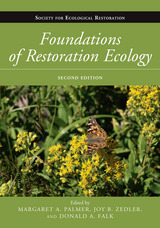 Foundations of Restoration Ecology
Margaret A. Palmer, Joy B. Zedler, and Donald A. Falk
Island Press, 2016 The practice of ecological restoration, firmly grounded in the science of restoration ecology, provides governments, organizations, and landowners a means to halt degradation and restore function and resilience to ecosystems stressed by climate change and other pressures on the natural world. Foundational theory is a critical component of the underlying science, providing valuable insights into restoring ecological systems effectively and understanding why some efforts to restore systems can fail. In turn, on-the-ground restoration projects can help to guide and refine theory, advancing the field and providing new ideas and innovations for practical application.
This new edition of Foundations of Restoration Ecology provides the latest emerging theories and ideas in the science of restoration ecology. Fully one-third longer than the first edition and comprehensive in scope, it has been dramatically updated to reflect new research. Included are new sections devoted to concepts critical to all restoration projects as well as restoration of specific ecosystem processes, including hydrology, nutrient dynamics, and carbon. Also new to this edition are case studies that describe real-life restoration scenarios in North and South America, Europe, and Australia. They highlight supporting theory for restoration application and other details important for assessing the degree of success of restoration projects in a variety of contexts. Lists at the end of each chapter summarize new theory introduced in that chapter and its practical application.
Written by acclaimed researchers in the field, this book provides practitioners as well as graduate and undergraduate students with a solid grounding in the newest advances in ecological science and theory.
 The Foundations of Science and the Concepts of Psychology and Psychoanalysis
Herbert Feigl and Michael Scriven, Editors
University of Minnesota Press, 1956 The Foundations of Science and the Concepts of Psychology and Psychoanalysis was first published in 1956. Minnesota Archive Editions uses digital technology to make long unavailable books once again accessible, and are published unaltered from the original University of Minnesota Press editions. This first volume of Minnesota Studies in the Philosophy of Science presents some of the relatively more consolidated research of the Minnesota Center for Philosophy of Science. The work of the Center, which was established in 1953 through a grant from the Louis W. and Maud Hill Family Foundation, has so far been devoted largely to the philosophical, logical, and methodological problems of psychology. Some of the twelve papers in this volume are concerned with broad philosophical foundations; others consider specific problems of method or interpretation. The contributors, some of whom are represented in the authorship of more than one paper, are Herbert Feigl, director of the Center; Rudolf Carnap; B.F. Skinner; Michael Scriven; Albert Ellis; Antony Flew; L. J. Cronbach; Paul E. Meehl; R. C. Buck; and Wilfrid Sellars.
The Foundations Of Scientific Inference
Wesley Salmon
University of Pittsburgh Press, 1967
Not since Ernest Nagel’s 1939 monograph on the theory of probability has there been a comprehensive elementary survey of the philosophical problems of probablity and induction. This is an authoritative and up-to-date treatment of the subject, and yet it is relatively brief and nontechnical.
Hume’s skeptical arguments regarding the justification of induction are taken as a point of departure, and a variety of traditional and contemporary ways of dealing with this problem are considered. The author then sets forth his own criteria of adequacy for interpretations of probability. Utilizing these criteria he analyzes contemporary theories of probability , as well as the older classical and subjective interpretations.
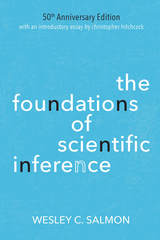 The Foundations of Scientific Inference: 50th Anniversary Edition
Wesley C. Salmon
University of Pittsburgh Press, 2017
After its publication in 1967, The Foundations of Scientific Inference taught a generation of students and researchers about the problem of induction, the interpretation of probability, and confirmation theory. Fifty years later, Wesley C. Salmon’s book remains one of the clearest introductions to these fundamental problems in the philosophy of science. With The Foundations of Scientific Inference, Salmon presented a coherent vision of the nature of scientific reasoning, explored the philosophical underpinnings of scientific investigation, and introduced readers to key movements in epistemology and to leading philosophers of the twentieth century—such as Karl Popper, Rudolf Carnap, and Hans Reichenbach—offering a critical assessment and developing his own distinctive views on topics that are still of central importance today.
This anniversary edition of Salmon’s foundational work in the philosophy of science features a detailed introduction by Christopher Hitchcock, which examines the book’s origins, influences, and major themes, its impact and enduring effects, the disputes it raised, and its place in current studies, revisiting Salmon’s ideas for a new audience of philosophers, historians, scientists, and students.
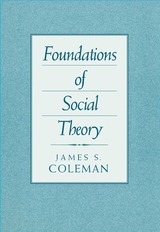 Foundations of Social Theory
James Coleman
Harvard University Press, 1990 Combining principles of individual rational choice with a sociological conception of collective action, James Coleman recasts social theory in a bold new way. The result is a landmark in sociological theory, capable of describing both stability and change in social systems.
This book provides for the first time a sound theoretical foundation for linking the behavior of individuals to organizational behavior and then to society as a whole. The power of the theory is especially apparent when Coleman analyzes corporate actors, such as large corporations and trade unions. He examines the creation of these institutions, collective decision making, and the processes through which authority is revoked in revolts and revolutions.
Coleman discusses the problems of holding institutions responsible for their actions as well as their incompatibility with the family. He also provides a simple mathematical analysis corresponding to and carrying further the verbal formulations of the theory. Finally, he generates research techniques that will permit quantitative testing of the theory.
From a simple, unified conceptual structure Coleman derives, through elegant chains of reasoning, an encompassing theory of society. It promises to be the most important contribution to social theory since the publication of Talcott Parsons' Structure of Social Action in 1936.
Foundations of Space-Time Theories
John Earman, Clark N. Glymour, and John J. Stachel, Editors
University of Minnesota Press, 1977 Foundations of Space-Time Theories was first published in 1977. Minnesota Archive Editions uses digital technology to make long-unavailable books once again accessible, and are published unaltered from the original University of Minnesota Press editions. The essays in this volume are based on the papers given at a conference on the philosophical aspects of the space-time theory held under the auspices of the Minnesota Center for Philosophy of Science.
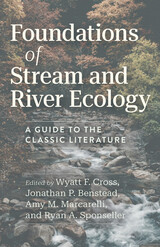 Foundations of Stream and River Ecology: A Guide to the Classic Literature
Edited by Wyatt F. Cross, Jonathan P. Benstead, Amy M. Marcarelli, and Ryan A. Sponseller
University of Chicago Press, 2024 For students and practitioners, a comprehensive primer on the key literature in stream and river ecology.
The study of streams and rivers combines ecology, chemistry, hydrology, and geology to reveal the factors that control the biological diversity and functioning of these unique ecosystems. Although stream ecology is a relatively young discipline, foundational papers published over the past half century have shaped our current understanding of these ecosystems and have informed our efforts to manage and protect them. Organized by topics such as the physical template, community structure, food webs, ecosystem energetics, and nutrient dynamics, the chapters of this book offer summaries of the key literature, historical and contextual information, and insightful discussions of how past research has influenced present studies and may shape future work.
Foundations of the Islamic State: Management, Money, and Terror in Iraq, 2005-2010
Patrick B. Johnston
RAND Corporation, 2016 Drawing from 140 recently declassified documents, this report comprehensively examines the organization, territorial designs, management, personnel policies, and finances of the Islamic State of Iraq (ISI) and al-Qa‘ida in Iraq. Analysis of the Islamic State predecessor groups is more than a historical recounting. It provides significant understanding of how ISI evolved into the present-day Islamic State and how to combat the group.
 Foundations of the Mind: Children’s Understanding of Reality
Eugene Subbotsky
Harvard University Press, 1993 In the wake of Jean Piaget’s work on children’s understanding of reality, it is generally accepted that by age two, children assume that an object hidden in a box will remain there unchanged until someone tampers with it. Eugene Subbotsky persuasively demonstrates that many children—and some adults—will often accept mysterious disappearances and creations, perceiving them not as tricks or illusions but as actual occurrences. His analysis clearly shows that alongside our everyday belief in object permanence, we also have a set of quasi-magical beliefs that can be activated by appropriate situations and behaviors. The acceptability of these beliefs will vary from culture to culture, and will be widespread among preliterate peoples but less obvious in advanced industrial countries. The author, a Russian psychologist, draws on his own extensive research and examines other taken-for-granted concepts, such as the distinction between animate and inanimate.
Foundations of the Mind, amply illustrated with experimental material, has enormous implications for the study of both child development and the psychology of human beliefs. It attacks our complacent and often culturally biased faith in the nature of reality, and as such will become required reading for all psychologists.
 Foundations of the Portuguese Empire, 1415-1580
Bailey W. Diffie and George D. Winius
University of Minnesota Press, 1978
Foundations of the Portuguese Empire, 1415-1580 was first published in 1977. Minnesota Archive Editions uses digital technology to make long-unavailable books once again accessible, and are published unaltered from the original University of Minnesota Press editions.
This account traces the history of the Portuguese overseas discoveries, following the expansion into the Atlantic island, the Madeiras, and the Azores. It continues the account with the history of Portuguese discoveries along the African coast, at Guinea, the Congo, and Good Hope, then follows the voyages of Vasco da Gama to India and to Cabra, Brazil, and the expansion in the early years of the sixteen century to Malacca, China, and the East Indies. The volume presents not only a useful narrative of the spread of Portuguese empire but also new interpretations and analyses of the Portuguese overseas history.
Foundations of the Unity of Science, Volume 2
Edited by Otto Neurath, Rudolf Carnap, and Charles F. W. Morris
University of Chicago Press, 1971 The growing concern throughout the world for the logic, the history, and the sociology of science reveals a comprehensive international movement interested in considering the scientific enterprise in its entirety. The purpose of the International Encyclopedia of Unified Science, as originally conceived by the late Otto Neurath, was to explore in numerous volumes the foundations of various sciences and to aid the integration of scientific knowledge. Circumstances during World War II and the death of Professor Neurath, however, limited the scope of the Encyclopedia. The Foundations of the Unity of Science constitutes the only completed unit of the proposed multi-volume Encyclopedia.
 Foundations of Tropical Forest Biology: Classic Papers with Commentaries
Edited by Robin L. Chazdon and T. C. Whitmore
University of Chicago Press, 2002 Foundations of Tropical Forest Biology presents a timely collection of pioneering work in the study of these diverse and fascinating ecosystems. Modeled on the highly successful Foundations of Ecology, this book consists of facsimiles of papers chosen by world experts in tropical biology as the "classics" in the field. The papers are organized into sections on related topics, each introduced with a discussion of their role in triggering subsequent research. Topics covered include ecological and evolutionary perspectives on the origins of tropical diversity; plant-animal interactions; patterns of species diversity and distribution of arthropods, vertebrates, and plants; forest dynamics and ecosystem ecology; conservation biology; and tropical forest management.
Foundations of Tropical Forest Biology makes essential works in the development of tropical biology available in a convenient form to both senior scholars interested in the roots of their discipline and to students encountering the field for the first time, as well as to everyone concerned with tropical conservation.
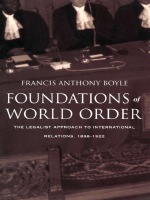 Foundations of World Order: The Legalist Approach to International Relations, 1898–1922
Francis Anthony Boyle
Duke University Press, 1999 In Foundations of World Order Francis Anthony Boyle provides the first historically comprehensive analysis of U.S. foreign policy regarding international law and organizations. Examining the period from the Spanish American War to the establishment of the League of Nations and the Permanent Court of International Justice, Boyle argues that the international legal framework created at the beginning of the twentieth century not only influenced the course of American foreign policy but also provided the foundation upon which relations among states were built.
Although both the League of Nations and the Permanent Court of International Justice were rejected by the U.S. Senate, Boyle shows how the early governance of these institutions—precursors, respectively, to the United Nations and the International Court of Justice—informed later efforts to reduce and regulate transnational threats and the use of military force. Delving into such topics as the United States and its initial stance of neutrality in World War I and its imperial policy toward Latin America and the Caribbean, Boyle offers detailed readings of the relevant treaties, tribunals, and conferences, and assesses the political actors involved. Taking up the legalist point of view, he discusses the codification of customary international law, the obligatory arbitration of international disputes, and the creation of a new regime for the settlement of such disputes.
Boyle has provided in Foundations of World Order a compelling portrait of the relationship between political power and law, and of the impact of these forces on U.S. diplomacy. This volume will serve as a valuable resource to students, scholars, and practitioners of international law; it will also be of great interest to historians and political scientists engaged with issues of U.S. foreign policy and diplomatic history.
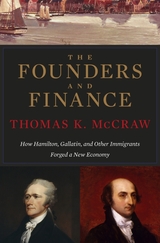 The Founders and Finance: How Hamilton, Gallatin, and Other Immigrants Forged a New Economy
Thomas K. McCraw
Harvard University Press, 2012 In 1776 the United States government started out on a shoestring and quickly went bankrupt fighting its War of Independence against Britain. At the war’s end, the national government owed tremendous sums to foreign creditors and its own citizens. But lacking the power to tax, it had no means to repay them. The Founders and Finance is the first book to tell the story of how foreign-born financial specialists—immigrants—solved the fiscal crisis and set the United States on a path to long-term economic success.
Pulitzer Prize–winning author Thomas K. McCraw analyzes the skills and worldliness of Alexander Hamilton (from the Danish Virgin Islands), Albert Gallatin (from the Republic of Geneva), and other immigrant founders who guided the nation to prosperity. Their expertise with liquid capital far exceeded that of native-born plantation owners Washington, Jefferson, and Madison, who well understood the management of land and slaves but had only a vague knowledge of financial instruments—currencies, stocks, and bonds. The very rootlessness of America’s immigrant leaders gave them a better understanding of money, credit, and banks, and the way each could be made to serve the public good.
The remarkable financial innovations designed by Hamilton, Gallatin, and other immigrants enabled the United States to control its debts, to pay for the Louisiana Purchase of 1803, and—barely—to fight the War of 1812, which preserved the nation’s hard-won independence from Britain.
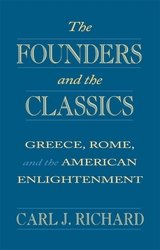 The Founders and the Classics: Greece, Rome, and the American Enlightenment
Carl J. Richard
Harvard University Press, 1995 Is our Greek and Roman heritage merely allusive and illusory? Or were our founders, and so our republican beginnings, truly steeped in the stuff of antiquity? So far largely a matter of generalization and speculation, the influence of Greek and Roman authors on our American forefathers finally becomes clear in this fascinating book-the first comprehensive study of the founders’ classical reading.
Carl J. Richard begins by examining how eighteenth-century social institutions in general and the educational system in particular conditioned the founders to venerate the classics. He then explores the founders’ various uses of classical symbolism, models, “antimodels,” mixed government theory, pastoralism, and philosophy, revealing in detail the formative influence exerted by the classics, both directly and through the mediation of Whig and American perspectives. In this analysis, we see how the classics not only supplied the principal basis for the U.S. Constitution but also contributed to the founders’ conception of human nature, their understanding of virtue, and their sense of identity and purpose within a grand universal scheme. At the same time, we learn how the classics inspired obsessive fear of conspiracies against liberty, which poisoned relations between Federalists and Republicans.
The shrewd ancients who molded Western civilization still have much to teach us, Richard suggests. His account of the critical role they played in shaping our nation and our lives provides a valuable lesson in the transcendent power of the classics.
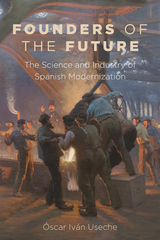 Founders of the Future: The Science and Industry of Spanish Modernization
Óscar Iván Useche
Bucknell University Press, 2022 In this ambitious new interdisciplinary study, Useche proposes the metaphor of the social foundry to parse how industrialization informed and shaped cultural and national discourses in late nineteenth- and early twentieth-century Spain. Across a variety of texts, Spanish writers, scientists, educators, and politicians appropriated the new economies of industrial production—particularly its emphasis on the human capacity to transform reality through energy and work—to produce new conceptual frameworks that changed their vision of the future. These influences soon appeared in plans to enhance the nation’s productivity, justify systems of class stratification and labor exploitation, or suggest state organizational improvements. This fresh look at canonical writers such as Emilia Pardo Bazán, Concha Espina, Benito Pérez Galdós, Vicente Blasco Ibáñez, and José Echegaray as well as lesser known authors offers close readings of their work as it reflected the complexity of Spain’s process of modernization.
 The Founders, the Constitution, and Public Administration: A Conflict in World Views
Michael W. Spicer
Georgetown University Press, 1995 Viewed alternately as an obstacle to justice, an impediment to efficient government, and a tool by which some groups gain benefits and privileges at the expense of others, public administration threatens to become the whipping boy of American government. In this innovative look at the nation's bureaucracy, Michael W. Spicer revisits the values of the Constitution in order to reconcile the administrative state to its many critics. Drawing on political and social philosophy, Spicer argues that there is a fundamental philosophical conflict over the role of reason in society between writers in public administration and the designers of the American Constitution. This examination of worldviews illuminates the problem that American government faces in trying to ground a legitimate public administration in the Constitution. Defending and developing the Founders' idea that political power, whatever its source, must be checked, he critically examines existing ideas about the role of public administration in American governance and offers an alternative vision of public administration more in line with the Founders' constitutional design. This book will provide fresh insights for anyone interested in the role of public administration in the United States today.
|
|

